Press Book 2022





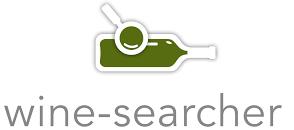 Kathle
Kathle
Global warming hasn't been all bad for wine. It has made it possible for Vitis vinifera to thrive in inauspicious growing zones like England And the extreme damaged or destroyed more than 74,000 acres of vines in France alone this Organisation of Vine and Wine, which pointed to drought, heat and frost as the culprits.
In Bordeaux, where France's national appellation body, the INAO, unveiled four new red and two new white grape varieties approved for inclusion on blends to great fanfare (and in some cases, consternation) in 2021, winegrower Jonathan Ducourt is combating the warmer temperatures with an array of nontraditional grapes, and even le gasp! hybrids. Twenty years ago, Ducourt had five classic Bordeaux varieties planted; now there are 12 grapes planted.
"Grapes like Merlot tend to go too high in ABV now," Ducourt says. "It's no longer unusual in Saint -Émilion to see 14 or 15 percent. Our Sauvignon Blanc is suffering from warmer temperatures too, especially at night when the temperature doesn't go down as it used to, and we lose the freshness and citrus fruit flavors."
Ducourt has planted 22.5 acres of Colombard to blend with the Sauvignon Blanc, usually at a ratio of 15 30 percent Colombard, and 70 85 percent Sauvignon Blanc. He has also planted about 12 acres of Petit Verdot, though the vineyard has been too young for use yet.
"Bordeaux has always evolved with the grape varieties planted in the region," says Ducourt. "Surely the ones we have today are not the ones we will grow in 50 100 years. It is up to us now to test the varieties that will be part of Bordeaux blend for the future generation."

There are more than 10,000 wine grapes on the planet, but just 13 occupy about one third of the vine area of the world, according to the International Organisation of Vine and Wine. As wonderful as the Cabernets and Chardonnays of the world are, the climate is going to force our palates to welcome a few new grapes to the party.

September 30, 2022 Circulation: 5,248,836 Digital
Drinking wine made from grapes that spend a lot of time hanging around oak vessels often feels a bit like listening to a comedian who idolizes Rodney Dangerfield. It’s hard not to roll your eyes occasionally at the forehead slapping lack of subtlety.
Winemaking, in recent decades, has turned a corner. Both winemakers and wine lovers are increasingly inspired by wines that are made with purity organically grown grapes, less intervention in the cellar and that transparently reflect the terroir. Land over hand.
A winemaker’s most obvious fingerprint is often made by their choice of vessel.
“The vessel a winemaker chooses to ferment and age their wines in can have an enormous impact on the final product,” says traveling winemaker Carlo DeVito, also author of Drink the Northeast: The Ultimate Guide to Breweries, Distilleries, and Wineries in the Northeast. “Over the years, I’ve worked with everything, from oak, to steel, to clay, to glass. They each have their purpose, but I will say that if you want a completely clean fermentation and you want to know what a grape truly tastes like, fermenting and aging it in glass will you get you there.”

Glass, typically the vessel of choice for home winemakers, has been popping up more and more in some of the most experimental and progressive cellars in the world.
The Bordeaux company will offer wineglobes that hold up to 400 liters by 2023, and their clients for smaller globes already include several of the hautest cutting edge vignerons in France, including Stephane Deroncourt at Domaine d l’A, Christophe Perrot Minot at Domaine Perrot Minot and Anabelle Cruse Bardient at Chateau Corbin.

The driving force behind the push toward glass among larger vintners is often all about letting the grape and terroir have their say.
Anabelle Cruse Bardinet, owner of Chateau Corbin, a Saint Émilion Grand Cru Classé winery in Bordeaux, has been using Wineglobes to ferment and age wine, starting with the 2019 vintage of Cabernet Franc.
“We use them mainly for Cabernet Franc but also for our Merlot in the Chateau Corbin blend,” Cruse Bardinet explains. “We age the wine inside of them during the end of fermentation until the bottling, just as we would use a new oak barrel. We’re looking for purity and respect for the wine. We want to keep the freshness of the grapes and their typicity.”
Christine Derencourt, the vigneron at Bordeaux’s Domaine de l’A ferments and ages whites and ages red in 220 liter Wineglobes. (They age most of their reds in oak barrels, but Derencourt loves what the globes do for Cabernet Franc.)





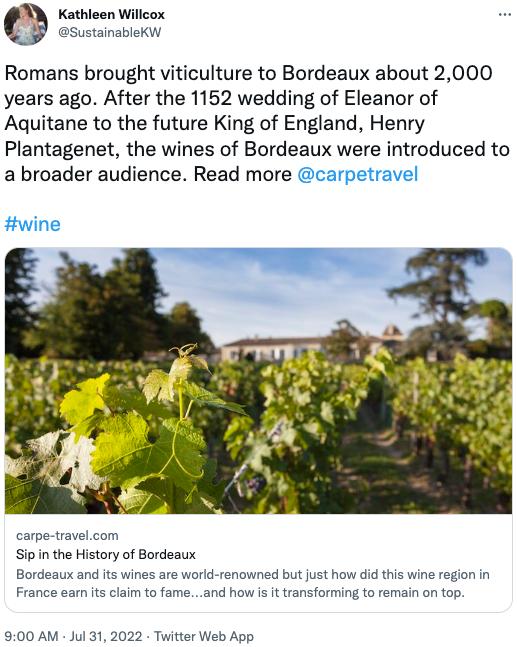

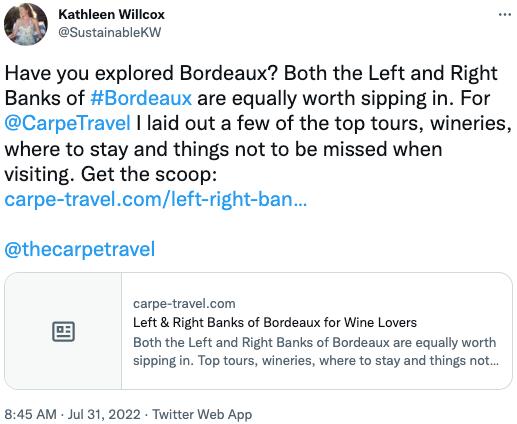



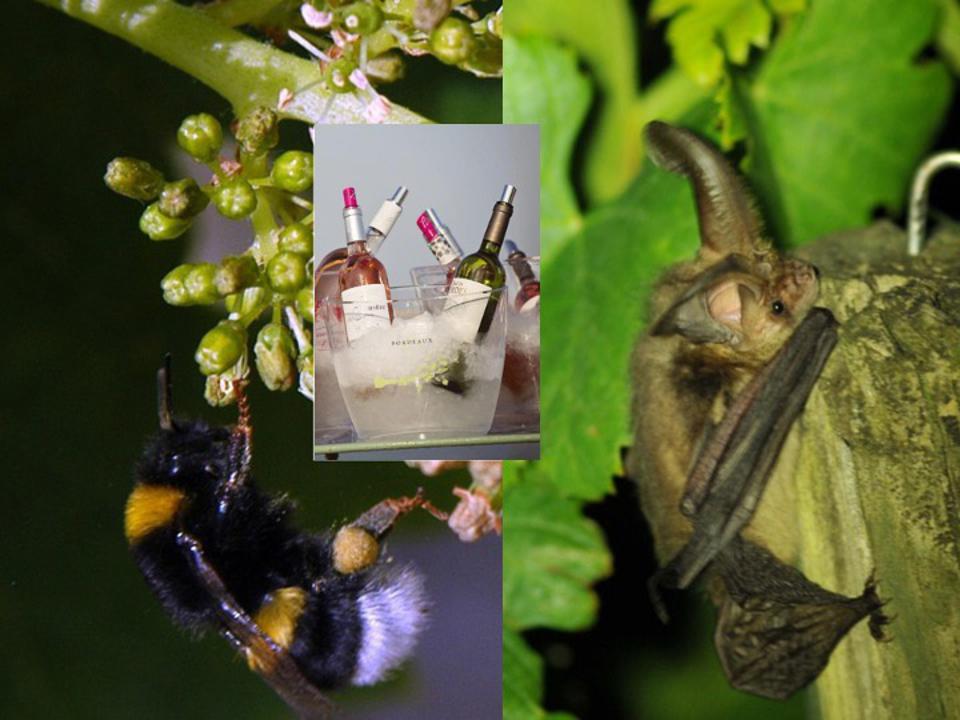 Liz Thach, MW
Liz Thach, MW
research studies to answer this question. These efforts are part of Bordeaux’s strategy to adapt to climate change and to reduce their environmental footprint.

“We spend one million euros per year on scientific research,” reported Marie Catherine Dufour, Bordeaux’s Technical Director, in a recent webinar. “Some of our studies verify the positive impact of bees, spiders, and bats in the vineyard.”
The Bordeaux wine region has committed to a goal of reducing carbon output 43% by 2030. “We have five strategic focuses for the 2030 carbon plan,” explained Dufour. These are to: 1)reduce the weight of glass and packaging, 2) reduce the impact of freight, 3) change winemaking practices to reduce farm fuel consumption and input, 4) promote energy efficiency solutions, and 5) sequester carbon in and around the vineyard. “The two that are impacted by bees and bats are winemaking practices and sequestration,” she continued.
There are many wineries and wine related organizations that are involved in the implementation of the strategy. The CIVB has named these organizations, ‘Eco Heroes. The two wineries that are doing most of the research around bees and bats are Domaines Denis Dubourdieu and Vignobles Arbo.

According to Jean Jacques Dubourdieu, owner of Domaines Denis Dubourdieu, “As part of our study, we installed 15 bee houses 5 years ago to analyze how bees impact biodiversity within the vineyard.” The results showed that since bees pollinate 80% of the plants in and around the vineyard, that they are very important to biodiversity.
Biodiversity around the vineyards is an important aspect of Bordeaux’s plan to reduce carbon emissions. Practices include a systems approach of planting more hedges and trees, creating and maintaining flower meadows and ecological corridors, as well as keeping grass cover. In order to make this happen, bees and other beneficial insects are critical to help with pollination and pest control.
“But,” continued Dubourdieu, “the biggest danger to bees is the Asian hornet we have in France, that are simply killing the bees. Also, too dry summers and springs. This is a difficulty.”
Winegrower, Margaux Arbo, of Vignobles Arbo, described the research they have conducted with bats at their estate. “For 12 years we have studied the impact of bats in our vineyards, and discovered there are 15 different species of bats,” she reported. “The bats love to hunt in the grass where they can find moths….This is our role to drive them into the vineyard where they can be a natural fighter. They are really our best friends.”
The bat studies have verified that bats reduce the number of predatory insects that can harm the grapes, and therefore reduce the need for pesticides. Additionally, vineyards that have larger bat populations reduce perforations of the grape bunches and leaves by 14 to 50%. All of this assists in reducing the use of agri chemicals and tractor passes, contributing towards a lower carbon footprint.
But how does this impact wine quality? To date, this topic is still being researched, but early results show that there is an ‘additional freshness’ to the wines that come from vineyard plots that have more biodiversity. Therefore, such practices as encouraging populations of bees, bats, and other beneficial insects, as well as planting cover crop, shrubs and trees, are thought to positively impact wine quality.
“There is one study,” stated Dufour, “called Viti Forest, that is carried out by INRAE our national research associationthat would tend to confirm this feeling (perspective).”
In addition to these efforts, the Bordeaux wine region has also achieved other environmental successes. Currently 75% of the Bordeaux vineyards are certified as using an environmental approach, and 23% of their vineyards are organic or in conversion to organic.








 Shelby Vittek
Shelby Vittek










 Kathleen Willcox
Kathleen Willcox


For decades, many wine lovers and producers discounted biodynamic farming as nothing more than pseudoscience. That’s starting to change as evidence mounts of the philosophy’s positive impact on vineyard health and wine flavor even as its more out there aspects remain unproven.
“We found that after converting to biodynamic farming, our vines were stronger, healthier and more disease tolerant,” notes Jasper Raats, cellar master and managing director at Longridge Wine Estate, first planted in 1841 in Stellenbosch, South Africa. “And the wines themselves also have a zest and vitality that was missing previously.”
For those unfamiliar with biodynamic farming, it is a holistic approach to land management rooted in the early 20th-century work of Austrian born educator and social reformer Dr. Rudolf Steiner. Steiner’s philosophy regards each farm as a self sustaining system that entails a very specific form of organic farming, influenced by astrological and spiritual principles as
well as lunar and cosmic cycles. Farming is planned around an astronomical calendar, and each day represents an element fire, water, earth or air. There are also fruit days, which are ideal for harvesting; leaf days, which are best for watering; root days for pruning; and on flower days, the vineyard must be left alone.
In biodynamic farming, the farm is viewed as a whole living organism, requiring a diversity of animal and plant species with an emphasis on pasture, native plants and pollinator plants to thrive. In biodynamic farming, practitioners believe that everything you need to make the plants healthy is on the farm, including natural pesticides.
It should be noted that Steiner himself had a problematic history of racist thought that the biodynamic movement and the educational institutions he inspired have repudiated in modern times. One of his books, The Occult Significance of Blood, first published in 1906, contains this disturbing passage: “To what extent are uncivilized peoples capable of become civilized? How can a Negro or an utterly barbaric savage become civilized? And in what way we ought to deal with them?”
Can a person’s words and actions be truly separated from their work? All of the wine producers interviewed here roundly reject Steiner’s racist ideology, and instead focus completely on his farming philosophies. But Steiner’s background certainly casts a shadow over his legacy and that of biodynamic farming.
Skepticism of biodynamic farming is understandable. Some of its imperatives seem to be pulled from a Saturday Night Live skit: Farm by the rhythms of the moon. Bury a cow (never a bull!) horn crammed with manure in the soil all winter. Dig it up and turn it into a tea that farmers spritz over the vines in a bid to increase a plant’s immunity
Other biodynamic practices, like applying compost with animal manure and plant material, rejecting GMO plant material and the use of medicinal herbs like yarrow and dandelion to naturally combat pests are less head scratching.
But here’s the thing: Biodynamic farming seems to work, at least by certain measures. While the efficacy of specific practices remains unclear, a recent review in the journal Organic Agriculture of 147 peer-reviewed scientific studies show that when considered broadly, biodynamic farming seems to enhance soil quality and vineyard biodiversity. It’s convincing enough evidence to convert some farmers.
“The microclimate of the vineyar has improved considerably, too,” Reyneke says. “With conventional farming, you are propping up the vines and soils artificially, and they become weak, [and] the soil is hotter.”
Biodynamic farming, especially with the help of cover crops, has naturally cooled the soil down, he says, adding that his operation’s “irrigation requirements are half of what they used to be.” And when it does rain, the runoff and erosion Reyneke contended with previously are no longer an issue.
“Our soil can retain and absorb the moisture now,” he says.
But do biodynamic farming practices result in better wine? A long term replicated study published in the American Journal of Enology and Viticulture in 2005 showed that when compared to an organic vineyard, a biodynamically farmed vineyard had significantly higher levels of brix, a measure of a grape’s sugar content. It also boasted higher levels of phenols, which are compounds that affect bitterness and depth of color. They have also been shown to have antioxidants, which may avert cellular damage in humans. Finally, the biodynamic farm’s soil was richer in anthocyanins, which have been touted in countless studies as having antiviral, antioxidant, antimicrobial and anti inflammatory properties.
Other winemakers contend that their biodynamically farmed wines require less intervention in the cellar than they did before.
“Our wines are now much more balanced,” says Reyneke. “We don’t need to add tartaric acid in the cellar.”

“We used to have to balance the acidity of our wines,” Villars Lurton says, noting that some chaptalization the addition of calcium carbonate to neutralize acid, or sugar to boost alcoholic content is permitted in Bordeaux to increase alcohol levels and harmonize flavors. “For the past 15 years, we have not had to do that.”

Villars Lurton continues, “We also don’t have to use nearly as many sulfites. Our wines naturally taste better, rounder and more approachable at a young age. Because we are so focused on the natural health of the vineyard, it leads to fresher, more complex wines, and grapes that are more disease resilient.”
And it may not just be wishful thinking on the part of winemakers. Biodynamic wine truly does seem to taste better, at least according to some. A UCLA analysis of 74,000 reviews from wine magazines found that biodynamic farming has a “small but significant positive effect on wine quality.”
Today, an estimated 800 wineries are certified biodynamic through Demeter and Biodyvin, the certifying bodies in the U.S. and Europe, respectively.
Meanwhile, sales of biodynamic wine increased more than 700% in the U.S. to about $6 million in four years as of March 2021, according to Nielsen sales data. Year over year, dollar sales increased 33% and volumes were up 27%, which suggests that on average, buyers are also shelling out more for each bottle sold.
Is biodynamic wine here to stay? The winemakers mentioned here certainly think so. If it’s truly better for the vines, the planet and the wines, the conversation about biodynamic winemaking has only just begun.
 Claire Villars Lurton, owner of Chateau Haut Bages Libéral in Bordeaux, who began converting her 100 acres in 2007, echoes Reyneke’s observations.
Claire Villars Lurton, owner of Chateau Haut Bages Libéral in Bordeaux, who began converting her 100 acres in 2007, echoes Reyneke’s observations.
The Bordeaux wine region is joining forces with New York restaurants to celebrate the “Eco Heroes” of Bordeaux with a special big bottle promotion this November. New York restaurants will feature fourteen Bordeaux wineries that exemplify the region’s significant commitment to sustainability and environmentally friendly practices. Making this particularly memorable for New York wine lovers, the featured wines will be offered in 3 Liter bottles, a rare, double magnum size.

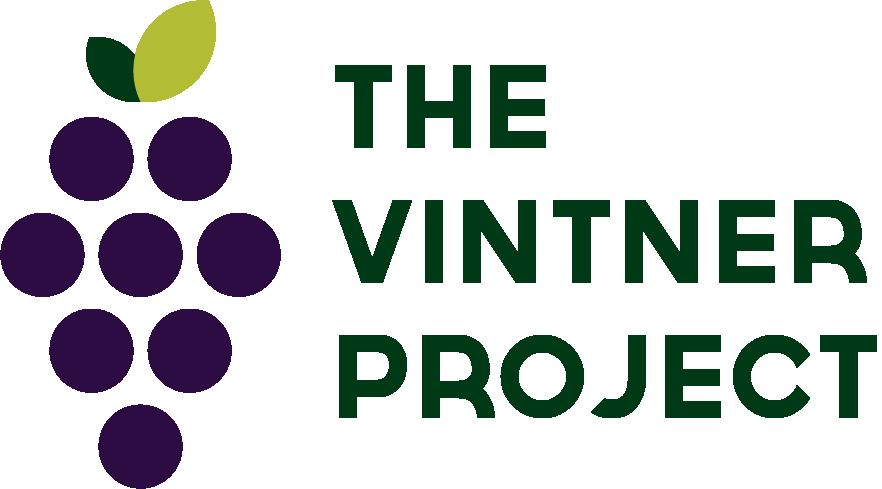
Ranging from wine bars to Michelin starred restaurants, more than 50 venues in New York have signed up to support the program this fall. Launching November 1, participating venues will pour a selection of wines from 3 Liter bottles, and many are opting to host additional tasting experiences and promotions.

A consolidated list of participating wineries & restaurants provided below:
Entre Deux Mers
• Château Biac (Cadillac Côtes de Bordeaux)
The Médoc
• Château Clarke (Listrac Médoc)
• Château Fourcas Hosten (Listrac Médoc)
• Château du Moulin Rouge (Haut-Médoc)
The Libournais
• Château Corbin (Saint Émilion Grand Cru)
• Château des Laurets (Puisseguin Saint Émilion)
• Château de La Dauphine (Fronsac)
• Château Puyanché (Côtes de Bordeaux)
Bordeaux and Bordeaux Supérieur
• Château de Parenchère (Bordeaux Supérieur)
• Château Roquefort (Bordeaux Blanc)
• Château La Rame (Bordeaux Rouge)
• Château Thieuley (Bordeaux Rouge)
Graves and Sauternais
• Château d’Arche (Bordeaux Blanc)
• Clos Floridène (Graves Rouge)
Manhattan
• Aldo Sohm Wine Bar
• Amali
• Amelie Upper West
• Amelie West Village
• AOC East
• Bacchus Wine Bar
• Balthazar Restaurant
• Bar Boulud
• Barbounia
• Benoit
• Boucherie Union Square
• Boucherie West Village
• Brandy Library
• Buddakan
• Clay restaurant
• Felix
• Ilili
• Isabella
• Juniper Bar
• l’Abeille
• La Brasserie
• La Grande Boucherie
• Le Coucou
• Le Pavillon
• Marc Forgione
• Marseille
• Mino Brasserie
• Monkey Bar
• Musket Room
• Nice Matin
• Niche Niche
• Noreetuh
• Pastis
• Peak
• Restaurant Daniel
• St Tropez Soho
• St Tropez West Village
• Temperance Wine Bar
• Temple Court
• The Algonquin Hotel
• Vin sur vingt East Village
• Vin sur vingt Nomad

• Vin sur vingt Riverside
• Vin sur vingt Upper West Side
• Vin sur vingt West Village
• Waverly Inn & Garden
• Wolfgang’s Steakhouse
• Zero Bond
• Calissa
The Finger Lakes
• F.L.X. Table
Westchester County
• GlenArbor Golf Club
Connecticut
• Rothmann’s Steakhouse
New Jersey
• Prime 94 Steak House
• Ventanas Restaurant
• VintEdge Wine Bar





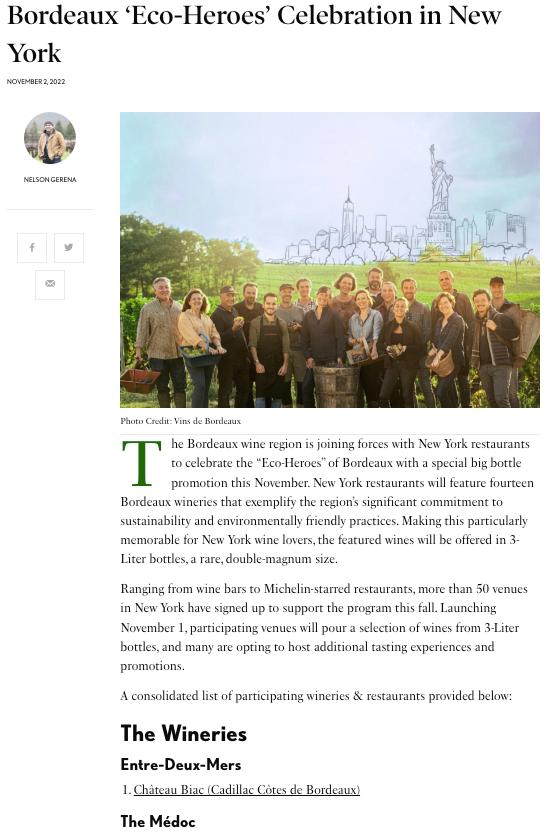

Over 60 restaurants will pour big bottle formats that spotlight fourteen inspiring wineries and Bordeaux’s significant environmental commitment

The Bordeaux wine region is joining forces with New York restaurants to celebrate the “Eco Heroes” of Bordeaux with a special big bottle promotion this November.


New York restaurants will feature fourteen Bordeaux wineries
New York restaurants will feature fourteen Bordeaux wineries that exemplify the region’s significant commitment to sustainability and environmentally friendly practices. Making this particularly memorable for New York wine lovers, the featured wines will be offered in 3 Liter bottles, a rare, double magnum size.
Ranging from wine bars to Michelin starred restaurants, more than 60 accounts in New York have signed up to support the program this fall.

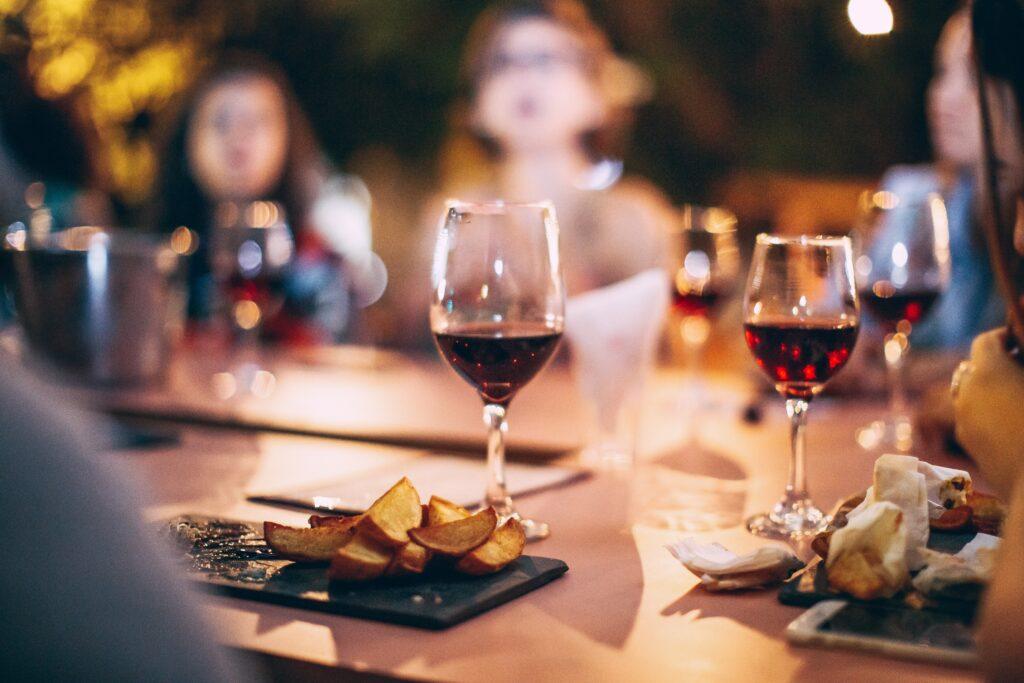
 Launching November 1, participating acco Liter bottles, and many are opting to host additional tasting experiences and promotions.
Launching November 1, participating acco Liter bottles, and many are opting to host additional tasting experiences and promotions.
“SUSTAINABILITY IN WINEMAKING IS REALLY AT THE FOREFRONT FOR WINEGROWERS IN BORDEAUX,”
“We are thrilled to work together with our wineries, importers and New York hospitality partners tohonor
the ‘Eco Heroes’ of Bordeaux this
term vine health and mitigate the impact of climate change. Recent efforts have reached impressive sustainable benchmarks: 75% of the Bordeaux vineyard is certified by an environmental approach; 23% of the vineyard is organic or in conversion; and collectively, the region has reduced carbon emissions by 24% since 2012. Many winegrowers are also actively developing biodiversity initiatives to encourage healthy bat, bee and tree populations to thrive in synergy with vineyard plantings.
The participating winemakers and châteaux representatives from Bordeaux represent the rich biodiversity and range of their region. Their wines capture the artistry and depth of various Bordeaux appellations from many different perspectives.


The featured wineries this November in New York include:
• Château Biac (Cadillac Côtes de Bordeaux), Gabriel Asseily, Owner
• Château Clarke (Listrac Médoc), Fabrice Darmaillacq, Winemaker & Technical Director
• Château Corbin (Saint Émilion Grand Cru), Nicolas Fabre, Cellar Master •
• Château d’Arche (Bordeaux Blanc), Mylène Caillemet, Sales Director
• Château de La Dauphine (Fronsac), Stéphanie Barousse, General Director
• Château de Parenchère (Bordeaux Supérieur), Julia Gazaniol, Sales Director
• Château des Laurets (Puisseguin Saint Émilion), Fabrice Bandiera, Technical Director
• Château du Moulin Rouge (Haut Médoc), Geoffrey Ribeiro, Owner/Winemaker
• Château Fourcas Hosten (Listrac Médoc), Eloi Jacobs, General Manager
• Château La Rame (Bordeaux Rouge), Olivier Allo, Manager
• Château Puyanché (Côtes de Bordeaux), Bernadette Arbo, Manager
• Château Roquefort (Bordeaux Blanc), Camille Giai, Commercial Director
• Château Thieuley (Bordeaux Rouge), Sylvie Courselle, Owner
• Clos Floridène (Graves Rouge), Jean Jacques Dubourdieu, Own


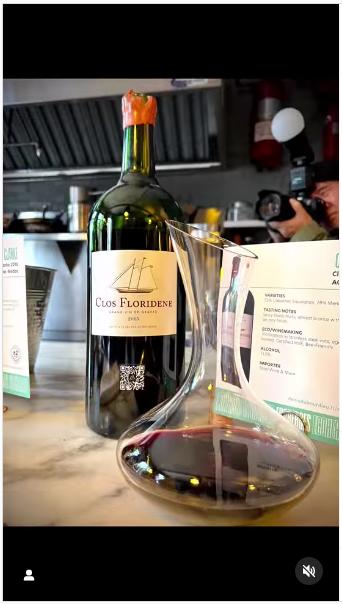
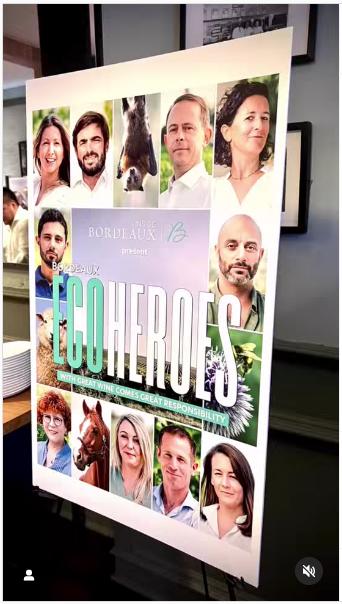
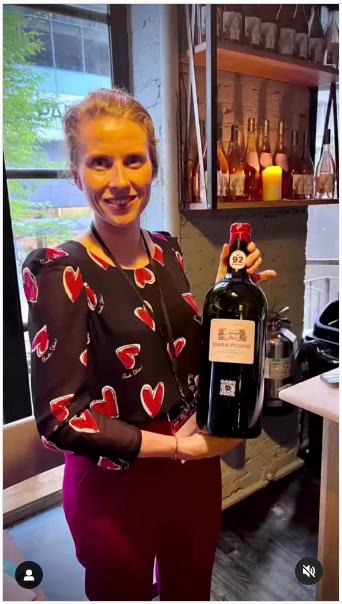

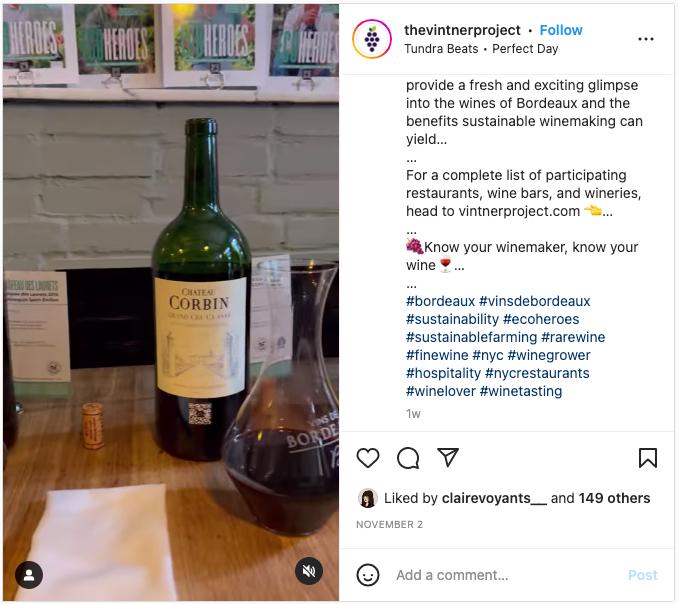
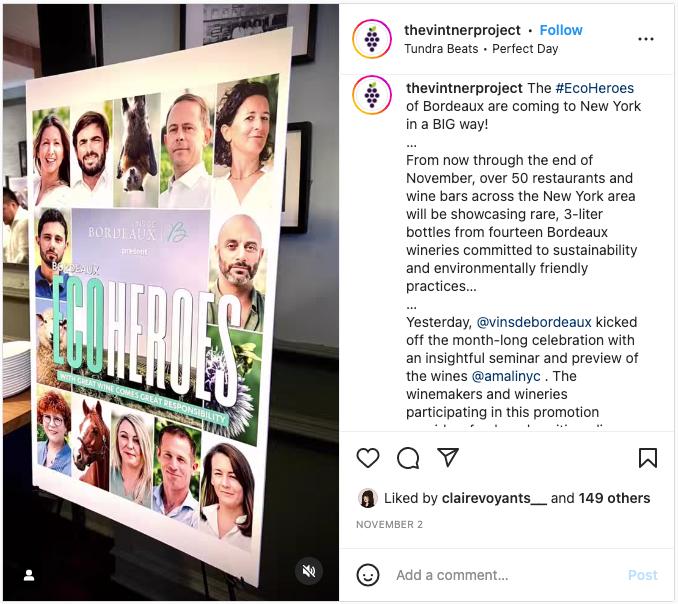







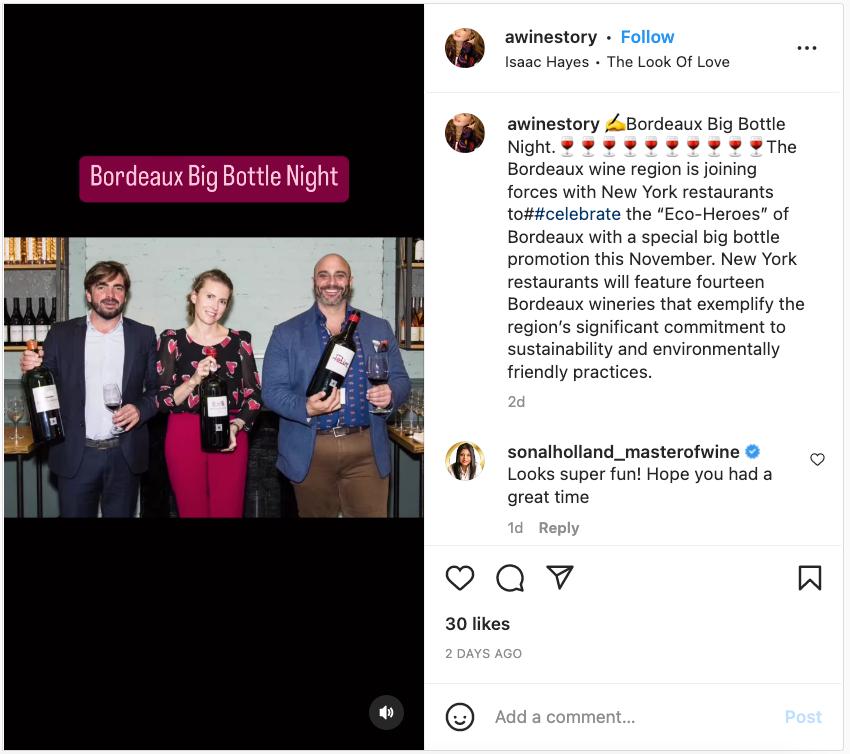


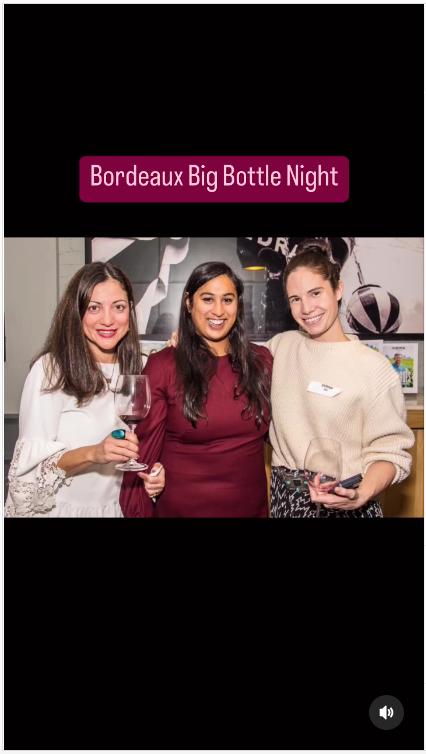











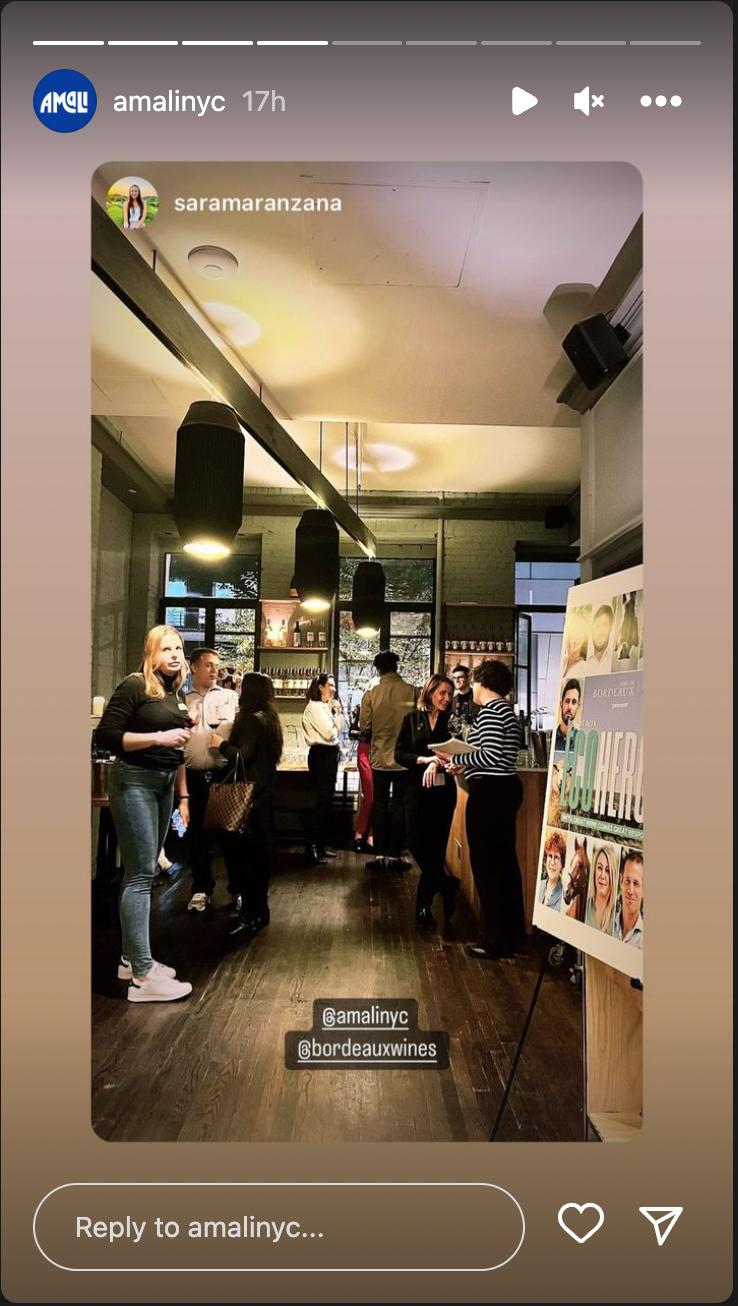





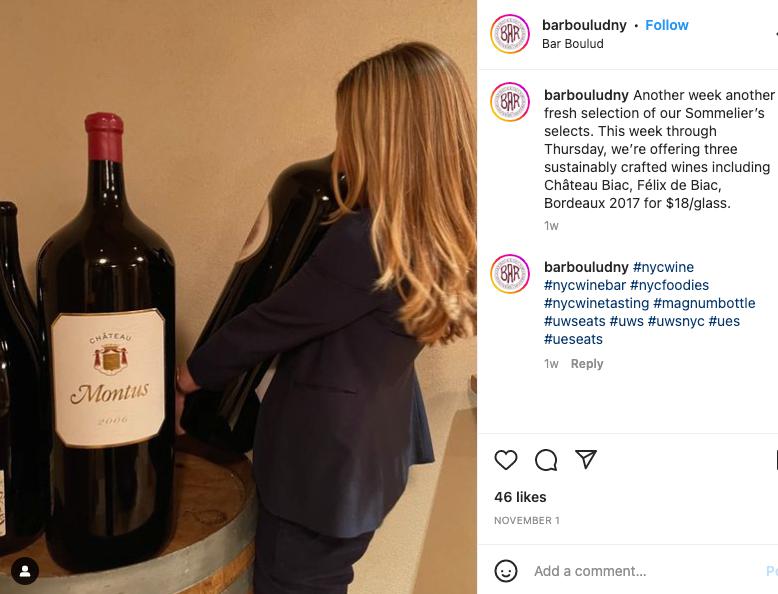

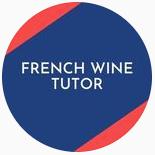
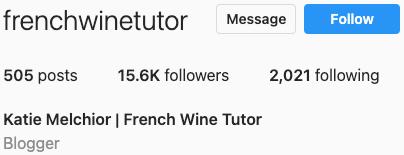

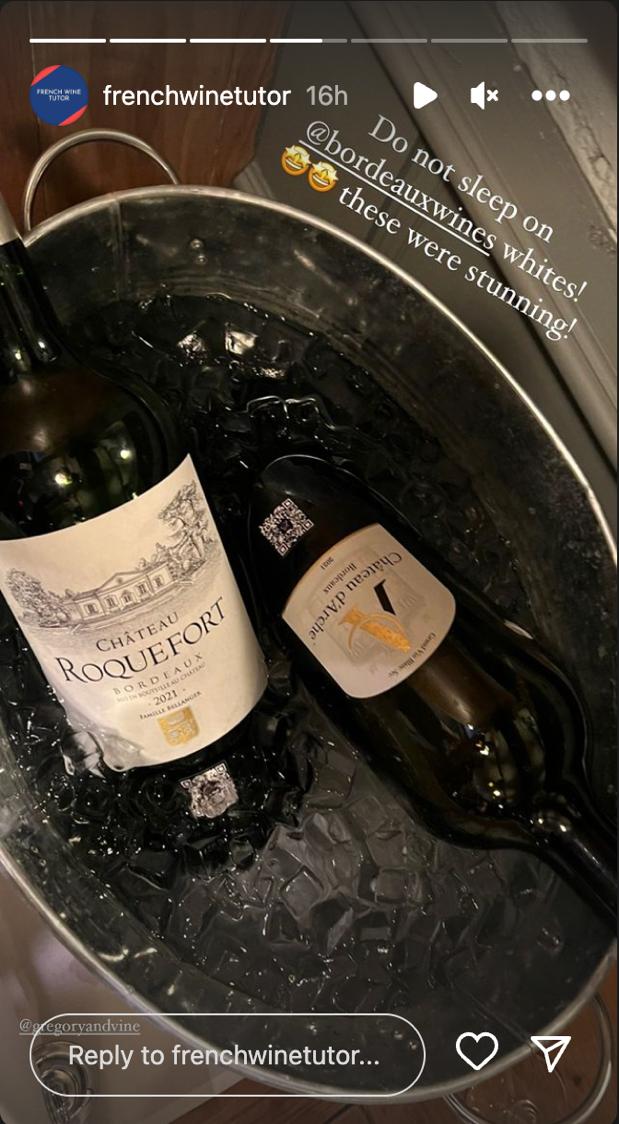














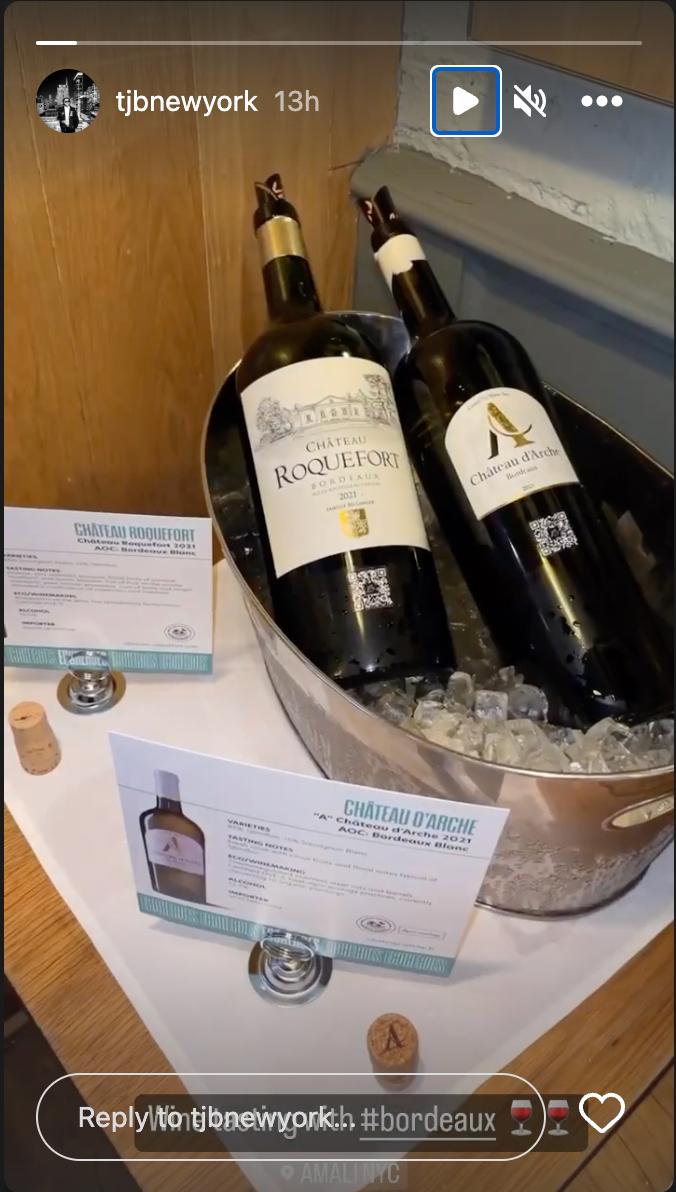

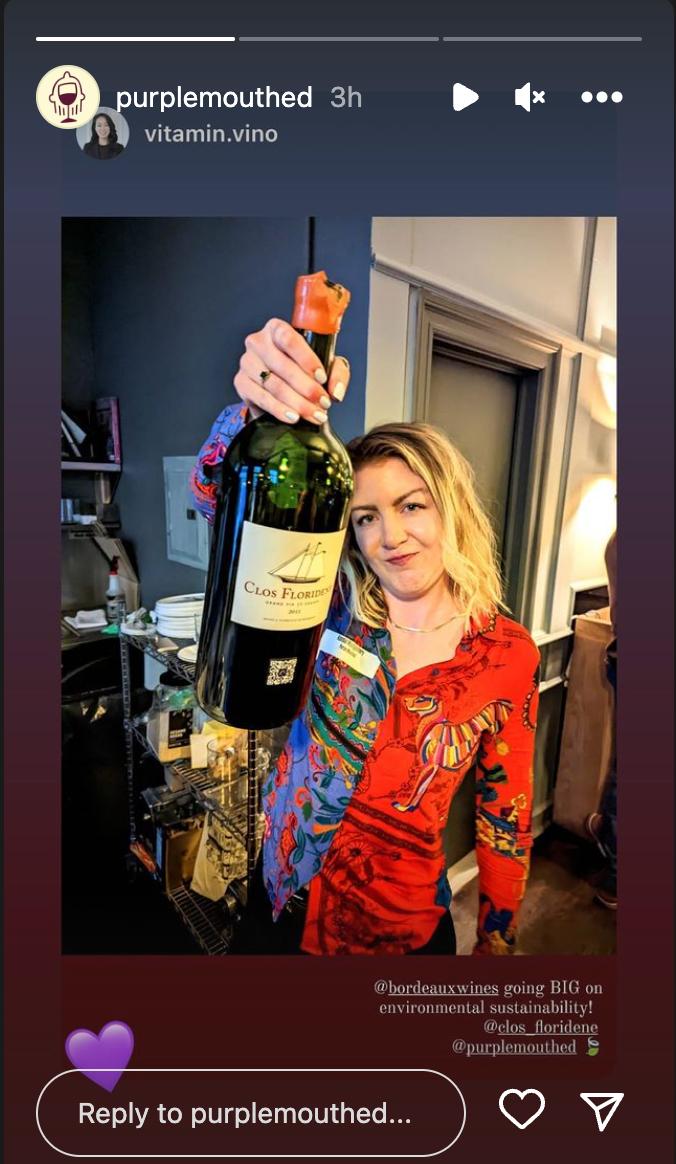







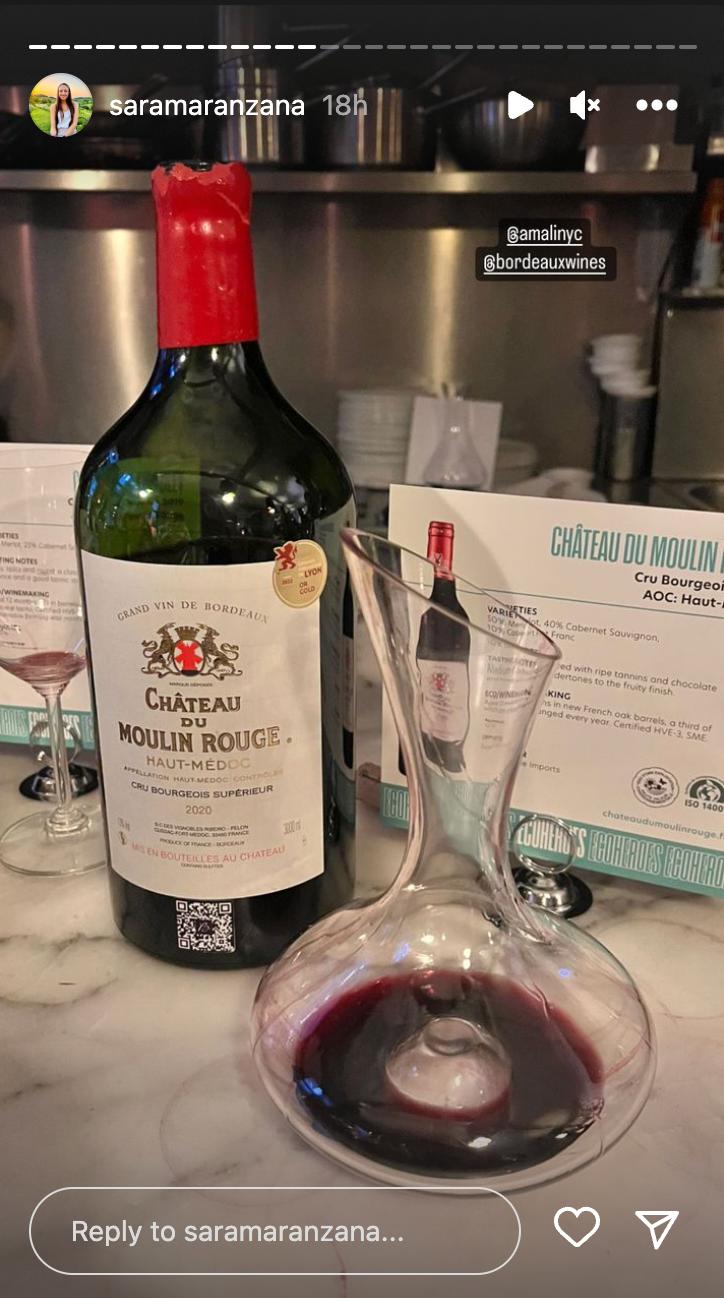


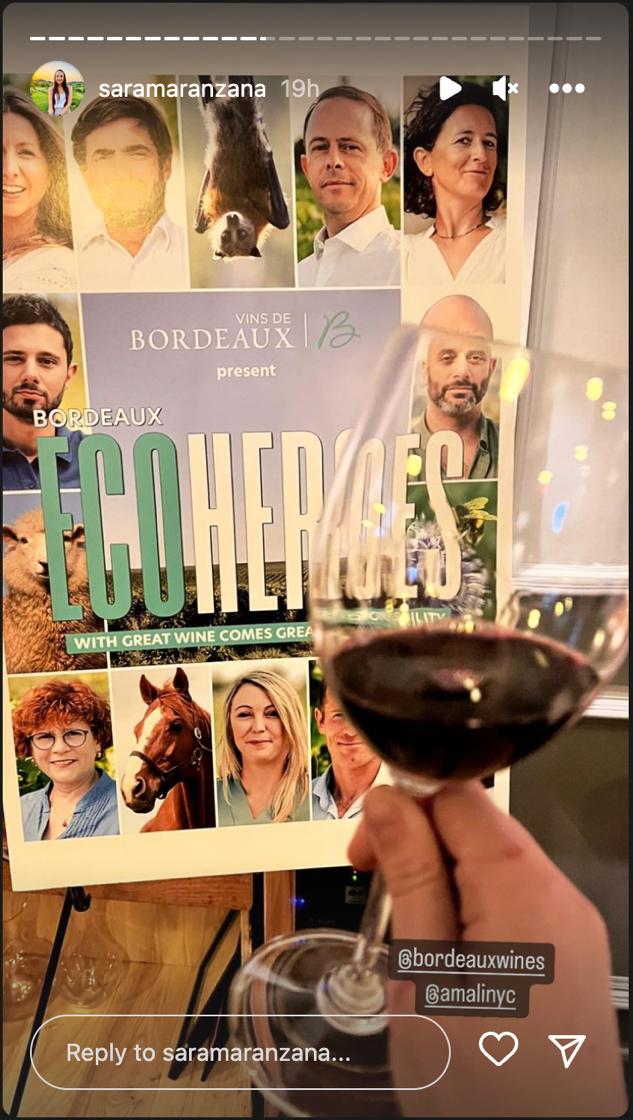
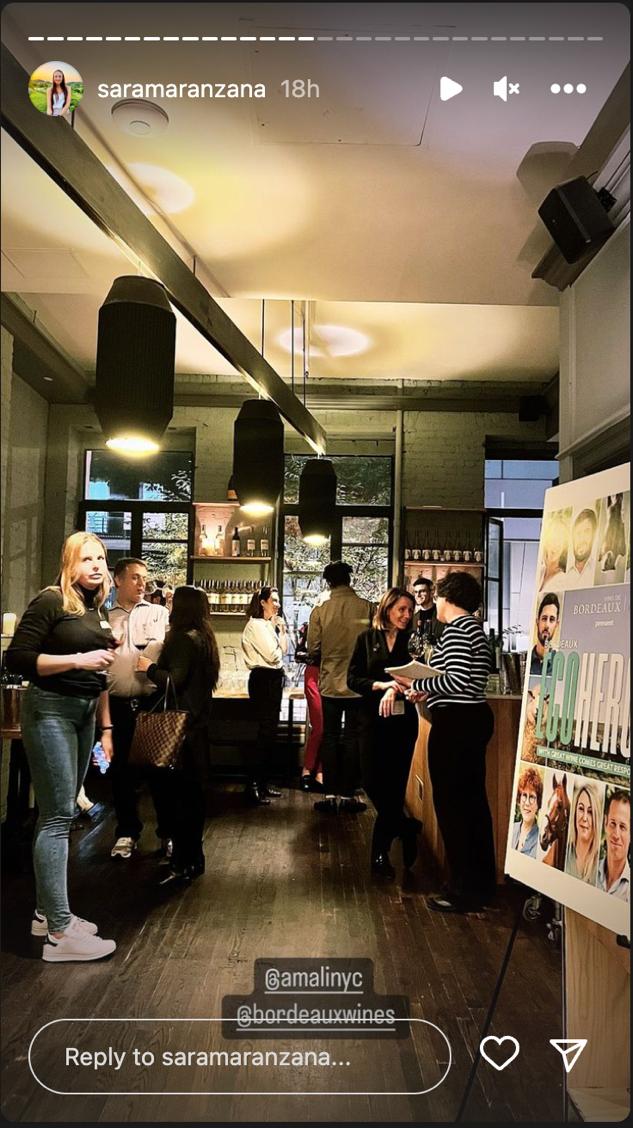






















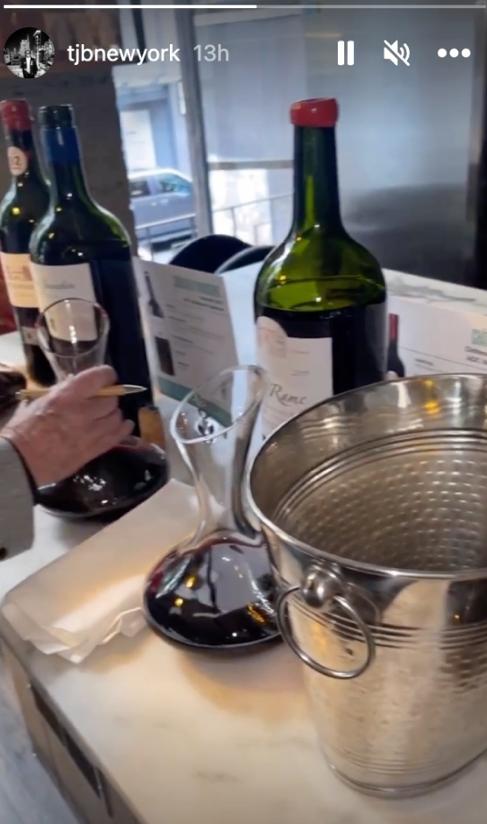

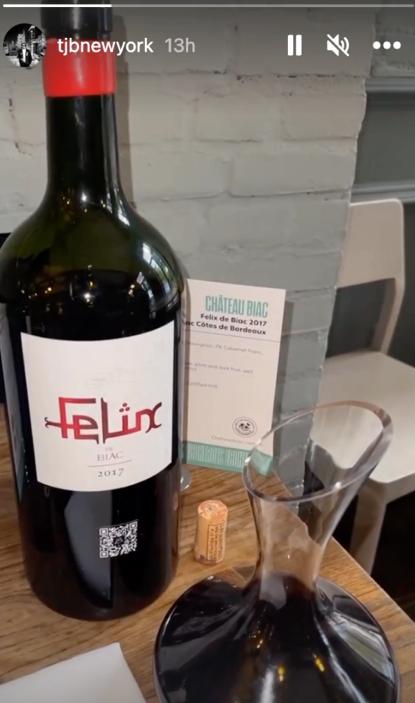
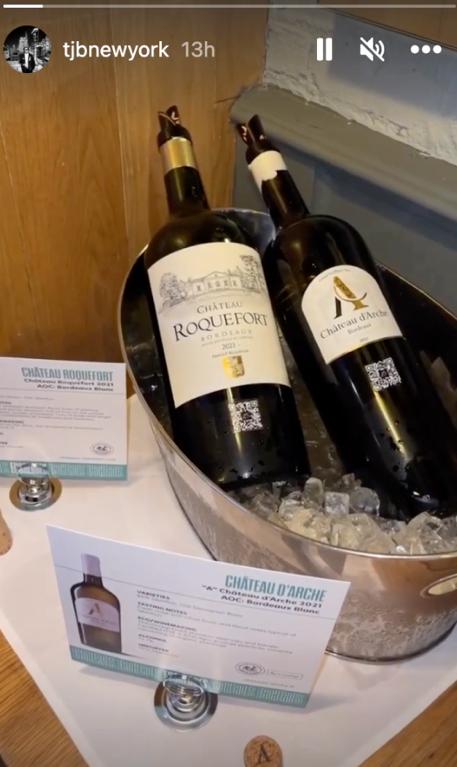


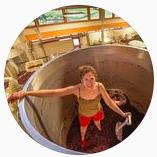

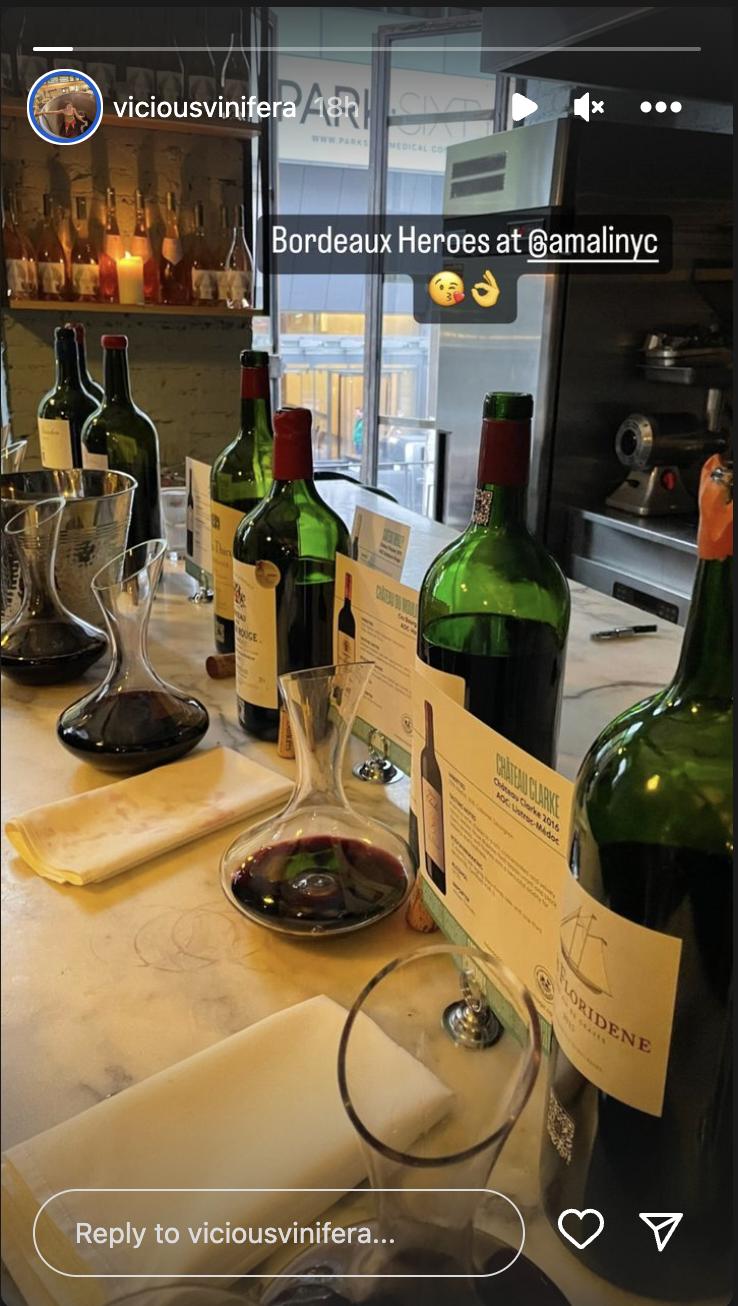




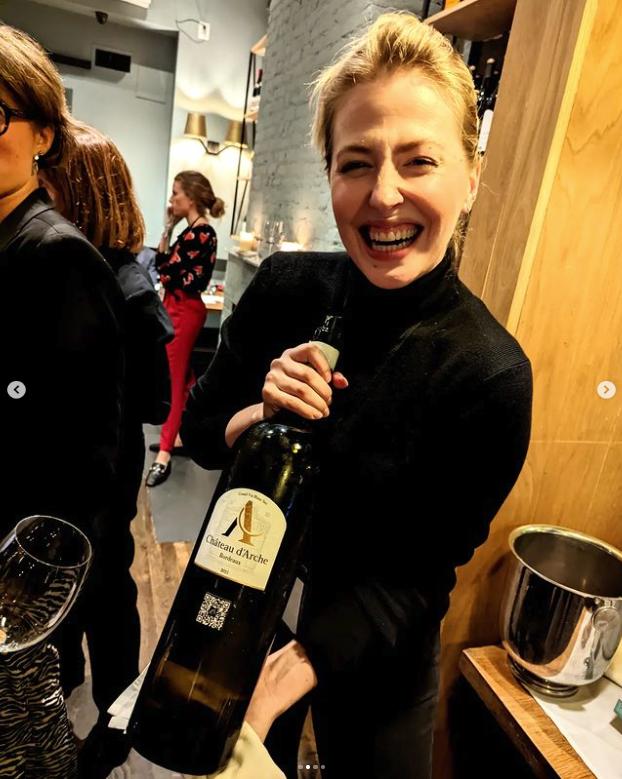


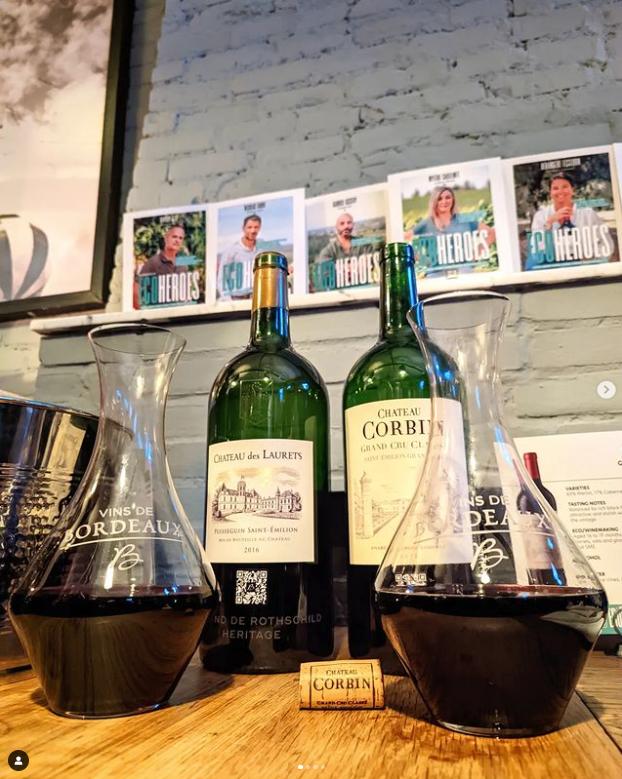

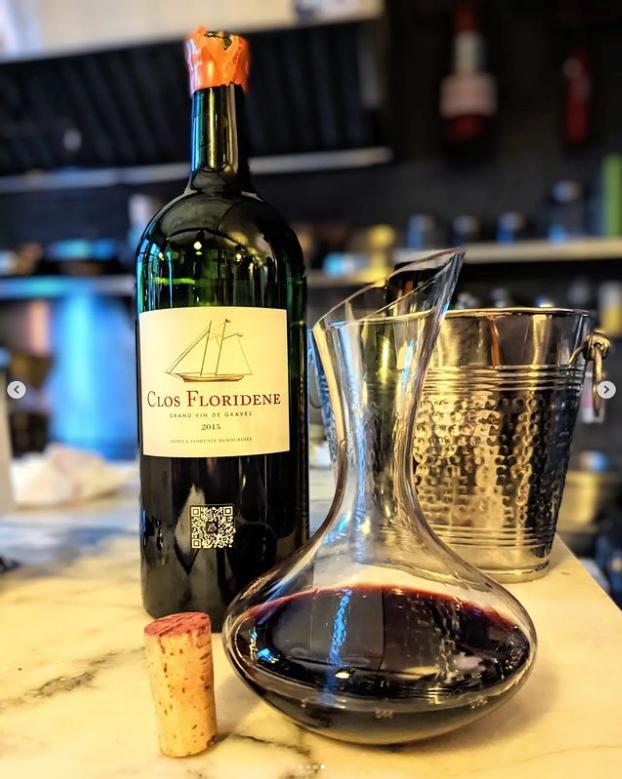



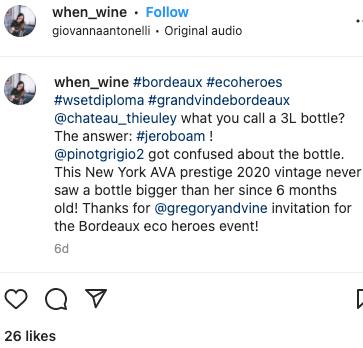








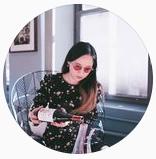





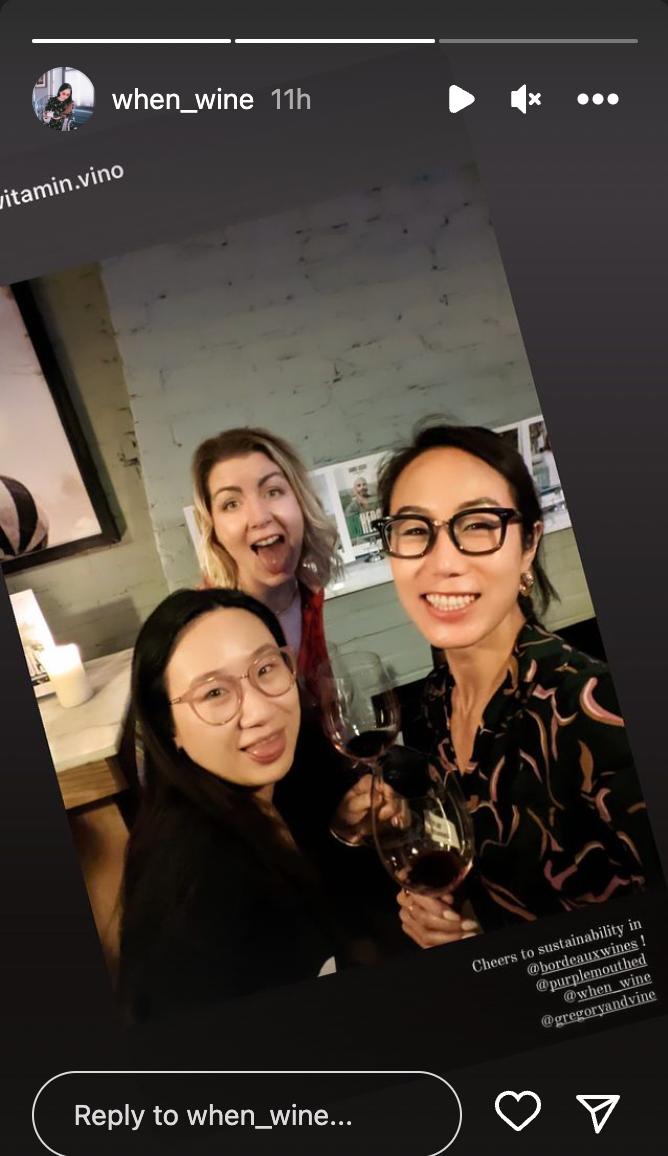

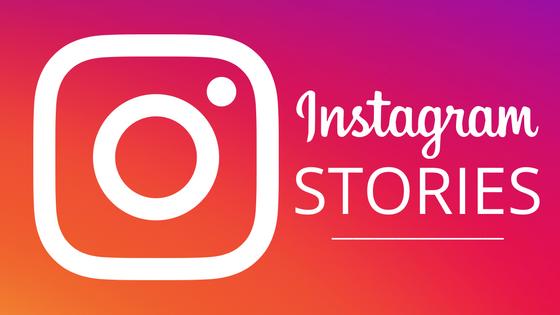






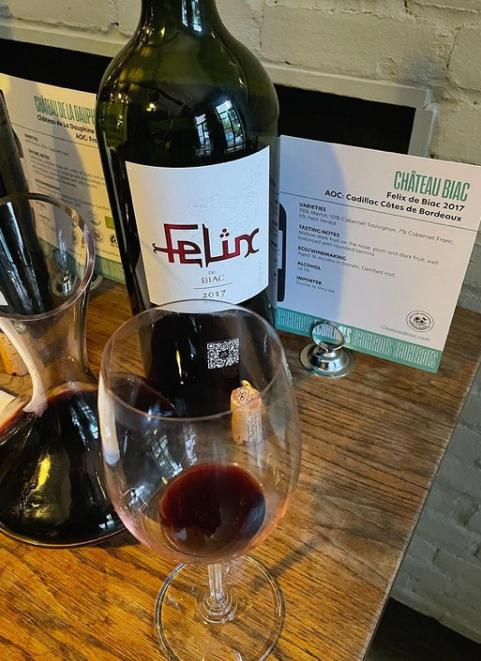

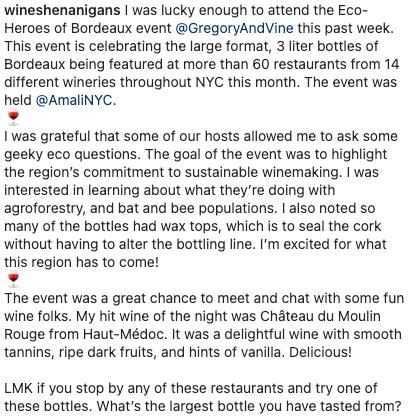












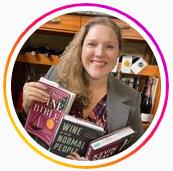


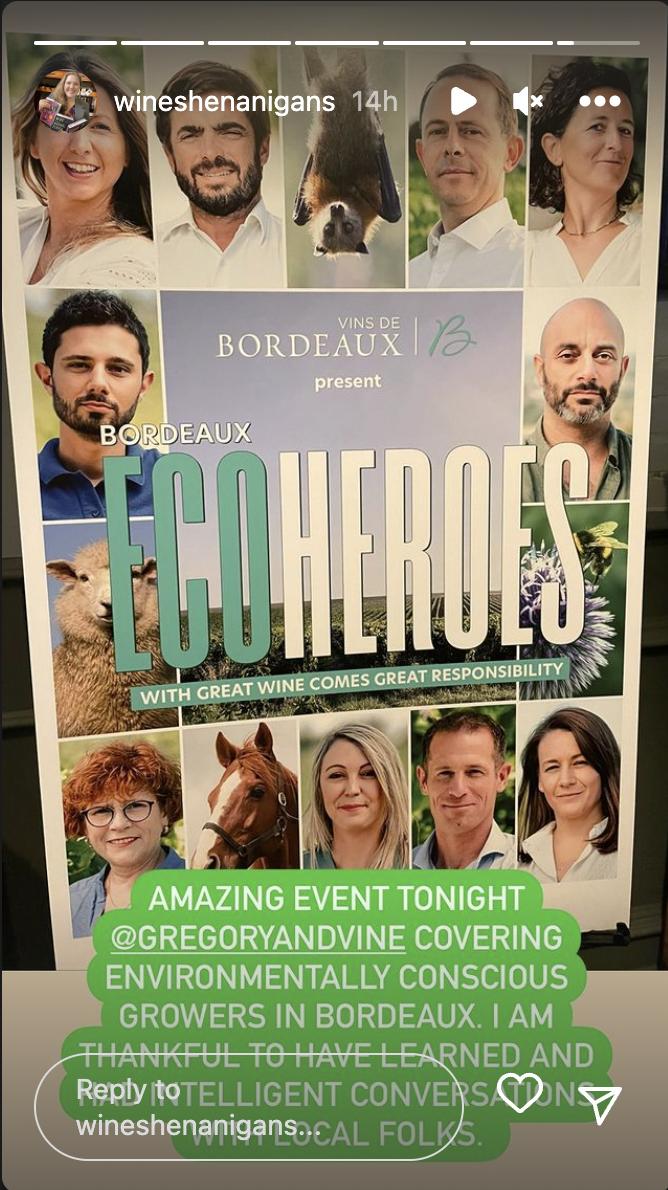






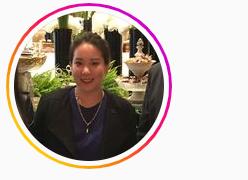








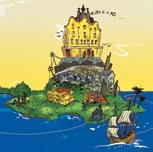
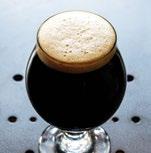
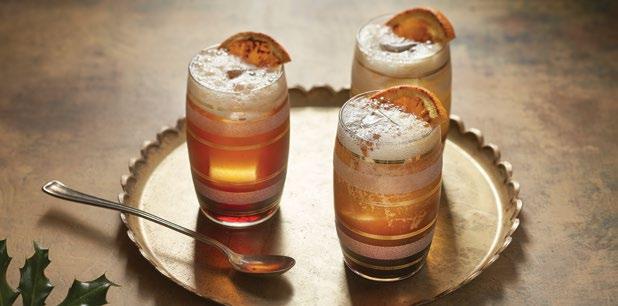
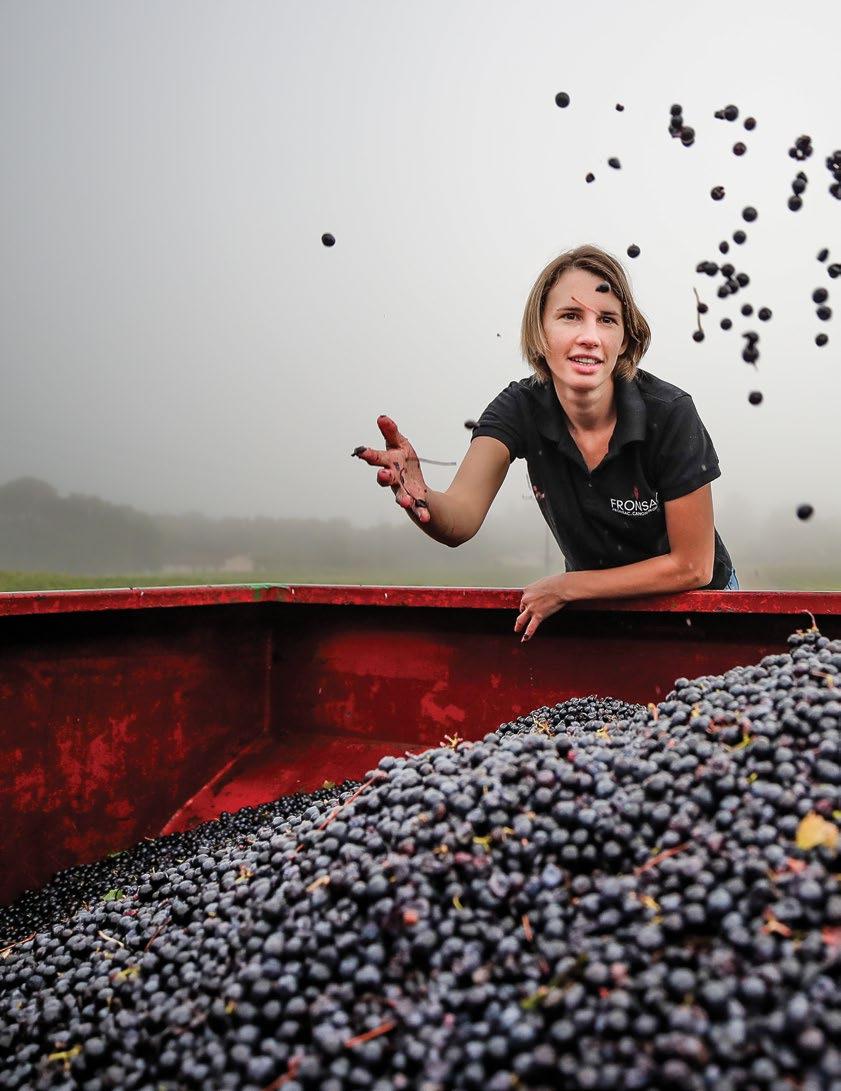
 Story by SHANA CLARKE
Story by SHANA CLARKE
rainstorm, quick and urgent, beats down on the roof of the lowceilinged, nearly windowless winery in the Fronsac appellation of Bordeaux. A small family of barrels sits stacked against one stone wall, and the cement floor bears splotches of both rain and wine. In lieu of a tasting room, or even a table, vigneron Lydia Coudert, dressed in jeans and sneakers, pours wine from bottles lined up on an upturned oak barrel. Coudert is the proprietor, along with her father, at Vignobles Coudert, one of the many small, family-run estates found throughout the region.
Bordeaux is the largest wine-growing region in France, with an outsized reputation to match. Bottles from top châteaux easily command thousands of dollars. Scores and notes from annual en primeur tastings—where prices are set for upcoming vintage releases—are followed as breathlessly by collectors as baseball fans during the final inning of a World Series game. Bottles sit aging in collectors’ cellars while the ideal “drinking window” is hotly debated. It’s not just a region—it’s a brand. Yet, this rarefied world of high-end wine is just one component of a massive region consisting of 5,300 winegrowers and 65 appellations. And within this mosaic, generational shifts, coupled with multiple environmental and societal factors, are creating a reckoning of sorts: What is Bordeaux today, and what should it be?
Coudert is a fifth-generation vigneron, but joining the family business wasn’t a foregone conclusion. After studying science for three years, engineering for five, and economics and finance for another year, she worked as an engineer in the energy sector for a decade. Her work brought her all over the world—Sweden, Belgium, Houston. But, eventually, the vines called. “I couldn’t imagine myself at least not trying to [make wine] one day, [out of] respect for my father, my grandfather,” Coudert says.
But she approached the business differently. At first, she observed and absorbed the work done before her. Before long, she saw opportunities to experiment with the winemaking process and found a willing partner in cellar master Julie Macary, who has been with the Coudert family for 18 years. (The two go way back, even attending the same preschool.) Macary wanted to try vinifying wines without sulfur dioxide. Although SO2 is commonly used as a protectant in the winemaking process, detractors say it mutes fruit and can obscure a wine’s character. Coudert was game, and they experimented on 6,000 bottles in 2018. “I really loved the wine. It was very fruity and supple, and for me, it was really in the direction that we should go.” The next year, they did the entire harvest’s vinification sans sulfur, and they haven’t looked back since.
Coudert counts herself fortunate: Her father is open to many of these ideas and gives her a freedom
that she says he never had with his father, whom Coudert describes as “very strict.” One vintage, they played jazz music in the cellar, working with the theory that vibrations from the sound waves will keep particles in motion and malolactic fermentation will occur faster. Coudert also created a line of wines named after her children, each bottle labeled with a charming illustration that wouldn’t be out of place in a picture book. Given the youthful inspirations, it’s no surprise that these wines were made to be drunk young. Some may see Coudert and her style of wines as an anomaly in the region, but Coudert says it’s all about perception. “I think [people] are just starting to see the changes, even though the changes started a long time ago. I think people now, more and more, see the fun bottle with the label first. And then [when they taste it] they see it’s not only the tannic, woody, very concentrated wines that exist.”
…
Bordeaux contains five official classification systems, each an attempt to define quality by setting parameters on what can be produced, and how. Some classifications may be reviewed annually, such as Crus Bourgeois du Médoc, while the most famous, Grand Cru Classés en 1855, has only been revised once in its 167-year history. But in the past few years, the validity of such order has been called into question. In the Saint-Émilion Grand Cru classification, three out of the four top-ranking estates have pulled out of the 2022 ranking, citing a de-emphasis on terroir, legal battles, and a focus on non-wine criteria such as marketing. Taken in a broader context, it’s causing many to question the rankings’ real purpose or benefit.
Twenty-nine-year-old Hugues Laborde has only been with Château Haut-Meyreau for five years. But he’s already implemented big changes, from the style of wines—moving to a softer, more fruitforward character—to experimental plantings of grapes, such as Nebbiolo and Petit Manseng. Noting how his peers were turning away from wine in favor of less uniform, lower alcohol beverages, Laborde aims to create styles to draw them in. “For people
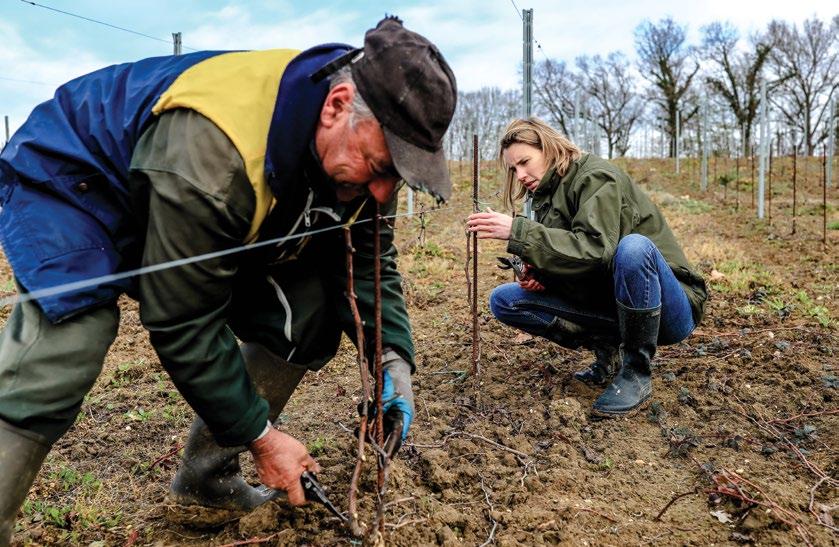

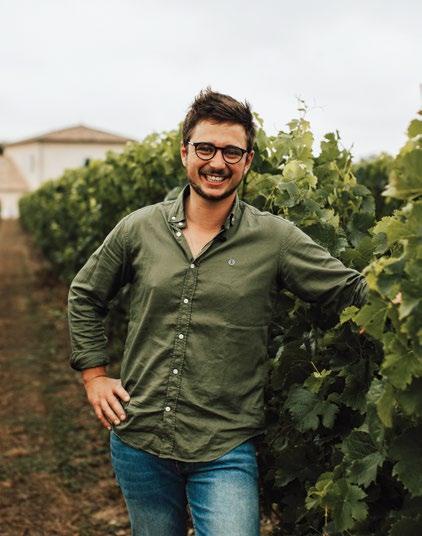 Top: Lydia Coudert and Raymond Manouvrier tending the vines at Vignobles Coudert. Left: Bottles of Château Castagnac Margot, named after one of Lydia Coudert’s children. This photo: Hugues Laborde of Château Haut-Meyreau.
Top: Lydia Coudert and Raymond Manouvrier tending the vines at Vignobles Coudert. Left: Bottles of Château Castagnac Margot, named after one of Lydia Coudert’s children. This photo: Hugues Laborde of Château Haut-Meyreau.
 An amphora used for aging wine at Château Durfort-Vivens.
An amphora used for aging wine at Château Durfort-Vivens.
who don’t understand wine, the idea isn’t to dismiss them, but to make wine appealing,” he says.
One of his first projects was to create a singlevarietal Cabernet Franc without sulfites. Because the wine didn’t fit into Bordeaux AOC requirements, he opted to label it as Vin de France—essentially, a table wine without any regional designation. Ironically, these declassified wines sold very well, which both pleased and frustrated Laborde. “It was like, I don’t understand why this type of product is not considered Bordeaux wine, because it is Bordeaux wine.”
And as someone who considers himself a Bordeaux vigneron first and foremost, Laborde says it’s aggravating that these wines can get devalued, but big companies that produce large volumes of wines that “have no identity,” as he puts it, get to keep the Bordeaux moniker. Laborde says he thinks other producers are failing themselves—and failing the region. “We don’t ask ourselves the right question,” he says. “The right question is, ‘What [does] the market want to discover?’ That is the big problem in Bordeaux.”
The conversation about attracting new drinkers also extends beyond what’s happening in the vineyard. Marie-Pierre Lallez, who runs Vignobles Raguenot with her sister and husband, began canning their wines during the early days of Covid, hoping a new format could help boost sales. Canned wine, although increasingly popular in the U.S., was—and still is—a novelty in tradition-bound Bordeaux. It took a while to find cans with the appropriate lining, as well as someone who could do the actual canning (their quest ultimately ended with a company in the south of France).
Naming the brand French Can Can, they brought their red, white, and rosé to market with surprising success. “It’s a new way of selling,” Lallez says. “Young people are drinking wine, but not in a formal way that we used to drink wine. We know wine in cans is part of the future.” She says it was important to sell the wine under the Bordeaux appellation. “Many consumers see Bordeaux as a bit of a hasbeen; maybe it is a bit boring or old-fashioned,” says Lallez. With cans, they hope to promote something innovative for the region. And noting it’s the same premium wine that goes into the can as into the bottle, Lallez thinks it can help shift perceptions.
This past June, just days before what was supposed to be the triumphant, post-pandemic return of Bordeaux Fête le Vin—an annual wine celebration in the city—hail decimated a large swath of vineyards throughout the region. Just two months later, multiple wildfires threatened the region during a heat wave so
severe that some producers were granted permission to irrigate their vines, a practice typically not allowed under the region’s classifications. It’s devastation like this—attributable to climate change—that’s been motivating many in Bordeaux to convert to sustainable, organic, and biodynamic farming.
In fact, 75 percent of vineyard acres carry some sort of sustainable certification, a high number due in part to the variety of certifications available in France. The most widely recognized are AB (organic); Demeter or Biodyvin (biodynamic); and HVE or Terre Vitis (sustainable). As of 2020, wineries could use “Vin Mèthode Nature” to indicate low-intervention practices. There’s also a bee-friendly certification, a designation that acknowledges business practices that reduce environmental impacts, and one exclusively for cooperative cellars.
For Gonzague Lurton of Durfort-Vivens, a highly ranked “Second Growth” château in Margaux, climate change served as the catalyst for completely rethinking his wine style. His vineyards have been fully biodynamic since 2012 and were certified in 2016, and Lurton finds the fruit more expressive than with conventional farming. But biodynamic certifications have certain thresholds for sulfur use, and as an estate whose wines required a long aging time, a certain amount of sulfur was needed to protect them during maturation. In addition, oak barrels, the most common aging vessel in Bordeaux, require sulfur for cleaning. The desire to eliminate sulfur seemed unattainable.
In 2017, Lurton consulted with his technical director Léopold Valentin, who came back with a solution whose traditions date even further back than Bordeaux’s: terracotta pots. Known also as amphora, or qvevri, these vessels have been used for thousands of years in places like Georgia, and have been coming back into fashion, especially with low-intervention winemakers. At first, Lurton was skeptical. He was worried about too much micro-oxygenation with the material, which would accelerate the aging process. But the bespoke pots, from a company in Italy, were fired to specification based on desired porousness.
The winery started by aging one plot of Cabernet Sauvignon as an experiment. Lurton, who also oversees a property in California, wasn’t in Bordeaux for the first six months of the experiment. When he returned, they opened the jars for the first time. “The result was astonishing for us; it was more than what we expected,” he says, smiling at the memory. “The style of the wine was so different. It had the aromas of grapes. I never heard anybody say that the wine has a taste of grapes; the taste of other fruit, yes, but not grapes. And in the mouth, we could not even feel the expression of tannins. They were so smooth, so
melted. It was incredible.” He knew he wanted to take this experiment further, and he ordered more pots for the next vintage.
But then, disaster struck. The 2018 vintage was almost completely wiped out due to disease pressure, save for about 10 percent of the crop. With nothing to lose, they decided to vinify whatever they had in terracotta. His technical director was reluctant; how would these vessels—not built for vinification—work when it came to some of the most important initial steps in the wine-making process? With some MacGyvering of the pots, they succeeded, and to this day the clay vessels are used for both vinification and aging.
Lurton’s cellar has grown to 160 terracotta vessels, which he believes to be the largest amphora cellar in the world. Standing next to the handcrafted army of pots, some of which are almost as tall as him, Lurton points to individual features of each. Moving the lids is the most perilous part of the process, he says, giving one an affectionate pat. They can’t be replaced because they were each designed for a specific pot. If one breaks … And yet, the pots are still more economical than oak. They never need to be replaced and use much less water for cleaning. As for sulfur? “One cuvée is produced without any sulfur added,” he confirms. “All the other wines are produced with 50 percent less total sulfur than before.”
However, overlooking this sea of ochre and amber, it’s hard to forget that Durfort-Vivens is a Second Growth estate—one with a reputation dating back to the 1855 classification. Aren’t there certain style expectations? How much is a wine like this allowed to change? “Terracotta helped the wine find its place,” Lurton explains. He looks back on his wines and finds the older vintages too austere when young. Now, there are more complex fruit aromas, the wines are more approachable at a younger age, and they can be enjoyed earlier. “We are not trying to make a big wine. It’s just a big expression of a wine.”
In 2021, waves spread throughout the wine world when the Bordeaux and Bordeaux Supérieur Association approved the use of six new grape varieties in Bordeaux AOC and Bordeaux Supérieur AOC blends. Currently, Cabernet Sauvignon, Cabernet Franc, and Merlot dominate red grape plantings, while Sémillon, Sauvignon Blanc, and Muscadelle are the most commonly planted white grapes. The new varieties now allowed include four red (among them the Portuguese grape Touriga Nacional, and Marselan, a cross between Cab Sauv and Grenache Noir) and two white varieties (Alvarinho, also from Portugal, and Liliorila, a cross
between Chardonnay and Baroque). The grapes are more resilient in the face of extreme heat, disease pressure, and other effects brought on by climate change. But the intention is not to change the wines in any dramatic way, and until more is known, only 5 percent of a vineyard can be planted with these varieties, and a cuvée can only contain 10 percent.
Marc Milhade of Château Boutisse Saint-Émilion Grand Cru, as well as Château Recougne Bordeaux AOC, is one of the winemakers experimenting with these grapes. The vines are still too young to be viable, but he’s also taking another look at grapes that have always existed in the region but fell out of fashion over the years as another possible salvation. Carménère, a grape that thrived before phylloxera mostly wiped it out in the late 1800s, is one of particular interest. As a variety with low acidity and one that can be tough to age, it never rebounded in the way others did. But with its elegant spice character and ability to produce a lower-alcohol wine, Milhade and others think it’s due for a revival, and could be another tool in the response to climate change.
In 2000, Milhade’s father started a Carménère nursery at Recougne using old vines found throughout Saint-Émilion. After identifying the best clones, he submitted them to the official grapevine catalog, making them available to all winemakers. In 2007, Milhade started planting some at Boutisse for use in the estate’s Merlotdominant Saint-Émilion Grand Cru wines. A warming climate means very ripe grapes, which means more alcohol. Merlot, especially, doesn’t take to these hot temperatures, but Milhade finds Carménère works as a tempering component in a cuvée. “A blend is a lot of details, and Carménère is just one of the details,” he says.
Under the Recougne label, Milhade makes a single-varietal Carménère—only about 8,000 bottles at the moment, but it’s selling well. “It gives something new to the Bordeaux region,” he says. Whether alone or in a blend, “What I like about Carménère is it’s not bringing a very deep color or strong concentration,” he says. “It’s a little bit lighter. And today we see globally that the people are looking for wines which are not too deep like they were in the [Robert] Parker period.”
Something old becoming something new: Like Carménère, this is the challenge facing Bordeaux. “The heart of the production of Bordeaux has to go on, has to continue, but we have to propose a new vision of Bordeaux with new wines,” says Milhade. “That’s what I did, changing the grape varieties [for example]. But it’s hard, because traditionalists don’t want to change anything. So it’s always a fight. But the new generation, they are trying to push in order to have the right to produce new things and to offer wines that consumers are expecting. It takes time.”
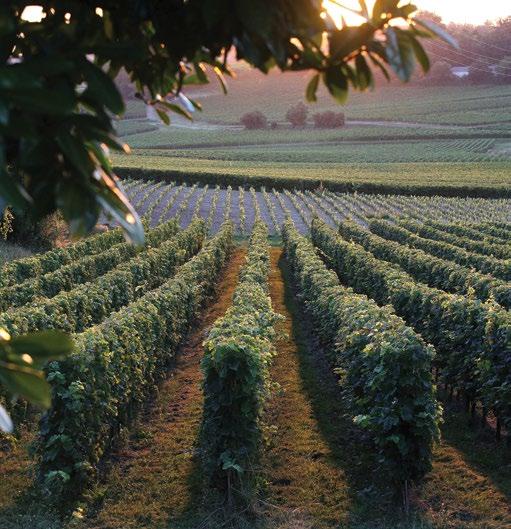
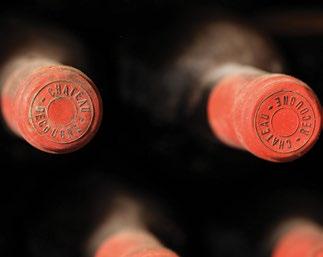

 Clockwise from this photo: Marc Milhade of Château Boutisse Saint-Émilion Grand Cru and Château Recougne; bottles of Recougne; the harvest at Boutisse; vines at Château Boutisse.
Clockwise from this photo: Marc Milhade of Château Boutisse Saint-Émilion Grand Cru and Château Recougne; bottles of Recougne; the harvest at Boutisse; vines at Château Boutisse.


In the world of wine, Bordeaux’s reputation easily precedes it— even if that reputation only represents a fraction of the region. “People think it’s expensive. Even wine professionals will say, ‘Oh, I can’t afford to like Bordeaux,’ ” says Mary Gorman-McAdams, a Master of Wine and instructor with the Bordeaux wine school, who is also an independent wine consultant and educator working as a U.S. trade advisor for the CIVB. “That’s because the Grand Crus Classés are what’s most associated with Bordeaux. But they only represent 5 percent of the volume produced.” The remaining 95 percent comes from a region both vast and varied. Bordeaux is the largest AOC in France by almost half, covering more than 270,000 acres and comprised of 65 individually recognized appellations within the main designations. “It’s a diversity of prices and a diversity of styles,” Gorman-McAdams says. “The average price of a bottle of Bordeaux here in the U.S. is $20.”
Not that Bordeaux hasn’t earned its lofty reputation. Vines have been grown in the region for thousands of years dating back to the Romans, with centuries of setbacks and advancements. Today more than 6,000 winemakers (65 percent of which are family-owned estates) create a wide range of styles. The region’s terroir—colloquially divided between the left and right bank of the Gironde—and an ideal climate has also played a large role. “It’s predominantly gravels on the left bank, and gravels retain heat and drain really well, so they’re perfect to ripen Cabernet Sauvignon. You’ve got the deep clays, cooler soils, and limestone across on the right bank,” explains Gorman-McAdams. “And then you’ve got the oceanic climate. What’s really important is the gulf stream, which prolongs the warmth in the fall. You often hear in Bordeaux that it’s September that saves the harvest.”
The vineyard classification system was introduced in 1855, when Napoleon III requested that each vineyard establish official guidelines. The Grand Crus Classés en 1855 was the first classification, and encompasses the bulk of Bordeaux’s highest-valued vineyards, with four subsequent classifications aimed at defining the parameters of what can be produced to protect the style of each region. But some winemakers have been questioning the philosophy of the system. Read more about the changing face of Bordeaux on page 66.
However, increasingly erratic weather is escalating the push for sustainability efforts, and 75 percent of the vineyard area has now achieved some form of certification, with the most falling under Haute Valeur Environnementale. “It’s less strict than organic in terms of treatments, but has much higher requirements in terms of biodiversity and how you mind and manage your people, so it’s a much more holistic approach,” she says. “Bordeaux is a very large region, so it’s not like a sailboat in the harbor; it’s more like a tanker, and it takes a while to crank up and get going, but when it does …”
Story by Penelope Bass Illustrations by Matty Newton
The wines made in Bordeaux are about 85 percent red blends and about 9 percent dry whites, which come primarily from the Entre-Deux-Mers region. But more recent years have seen an increasing interest in sparkling wines (Crémant de Bordeaux) and thoughtful production of rosé. “The fact that Bordeaux wines are blends rather than varietal wines—I think the magic there is that the whole is greater than the individual parts,” says Gorman-McAdams.
The vast AOC of the Médoc is home to some of Bordeaux’s most famous (and expensive) vineyards, as well as smaller estates with a new generation of winemakers utilizing sustainable practices and crafting modern wines, like this lush, juicy red blend from Château Paloumey. $31.99, wine.com

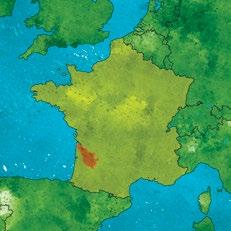
Family estate Château Marsau in the Francs appellation has been 100 percent organic since 2021, and is also planted fully to Merlot, resulting in their highly acclaimed single-varietal wine. Gorman-McAdams recommends the 2016 vintage for its succulent fruit and refined character. $23.99, garyswine.com
Although the maison Calvet was founded in 1818, this crisp, fruitforward sparkling rosé, made via the méthode traditionnelle, is representative of the more modern styles emerging from Bordeaux, notes Gorman-McAdams. $18.99, wine.com
Gorman-McAdams points to the women-owned family estate Château Thieuley for their excellent representation of Bordeaux’s dry white style. The blanc is a blend of primarily Sémillon and Sauvignon Blanc, offering fresh flavors of white fruit and citrus. $12.99, grapeandstill.com
From the small, Graves-region estate founded by the late Denis Dubourdieu, who was a seminal figure in the modernization of Bordeaux dry whites, the Clos Floridène Blanc offers bright acidity with flavors of grapefruit and grassy herbs. $26.99, totalwine.com


After enduring the driest July on record since 1959, summer wildfires that threatened to ruin grape crops, and the earliest documented start of picking, winemakers in Bordeaux are pleased with the 2022 vintage. Both flowering and fruit set took place under excellent conditions after late spring frost and hail, which had much greater impact on the 2020 and 2021 harvests, affected some areas in the south of the region. The CIVB (Bordeaux’ regional wine council) has not released official statistics yet, but totals were expected to be just slightly lower than the 50 year average and significantly higher than last year’s haul.
The ongoing drought and high July and August temperatures led to the authorization of irrigation in appellations including Pessac Léognan, Pomerol, Lalande de Pomerol and Saint Emilion, which is a first in the region. While irrigation was permitted through August 15, there were no systems in place for adequate water delivery in most places, so very few houses put the practice into use except for their vines that are under three years old, which are always allowed to be irrigated. There are no reported incidents of “smoke taint” from summer wildfires affecting the flavor or quality of grapes.
Vineyards with older vines whose roots reach deep into the soil to retrieve available groundwater fared better than those with younger, more shallow root systems. Nicholas Seillan, seventh generation winemker at Château Lassègue, explained,
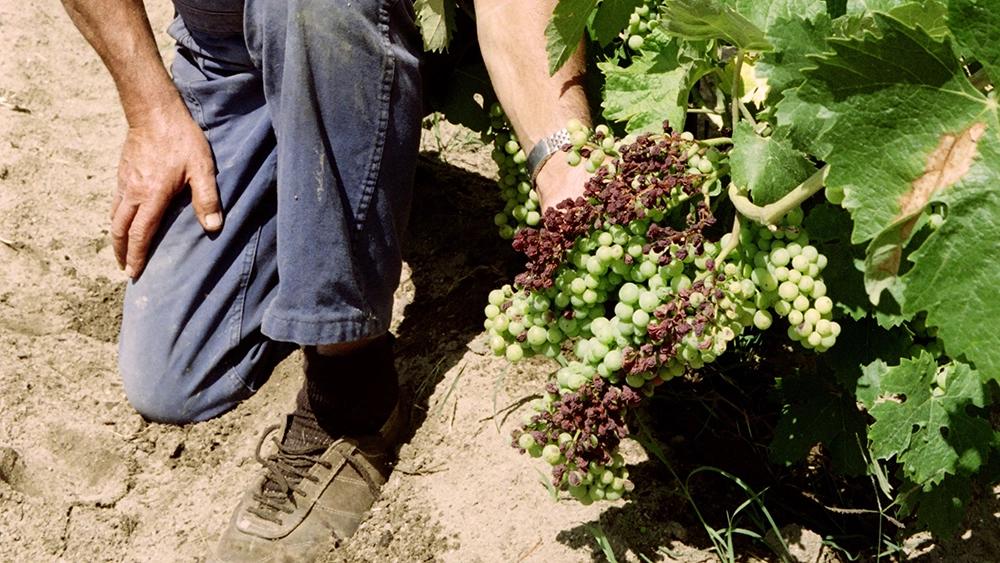
“We are fortunate at Lassègue to benefit from clay and limestone as a key element of the terroir, which provides a stock of retained moisture during dry periods. Summer 2022 was particularly hot and dry. However, the old vines with their deep roots were an additional factor which helped the vineyards to support the difficult conditions this year.”

Harvest for white grapes began on August 16, with the harvest for reds across the region starting almost a full month later. Alexandre de Malet Roquefort of Domaines Comte de Malet Roquefort told us, “The harvest at [estate vineyard] La Gaffelière began with the Merlots on September 13 and ended on September 28.” He also pointed out that the collection was shorter than usual, stating, “Harvests were concentrated over 15 days instead of the usual three to four weeks.” Mssr. de Malet Roquefort praised the character of this year’s crop, adding, “The quality of the Merlots and Cabernet Francs is extraordinary this year. Ripeness is on point, with good freshness, despite the heat, which will allow beautiful balance in the wine. On the quantity side, we are on ‘correct’ volumes. We are expecting a very fine vintage!”
The fine vintage did not come without worry. As Ludovic Migeon of Château de Lescours stated, “The very hot periods concentrated our grapes and made the vine’s roots suffer. Lack of water over a very long period prevented the seeds from growing properly. We waited as long as we could to reach maturity trying to keep as much juice as we could in the berries. This year’s weather conditions forced us to make unusual and difficult choices.” He went on to say that the “smaller quantity does not erase the very nice quality.” Timing this year was also different at Lescours, where picking began on September 17.As Migeon explained, “We usually wait for the Cabernets, but this year they were picked up at the same time as our last Merlot.”
Seillan reiterated the sentiments of the other winemakers, telling us, “We are very pleased both in term of quality and quantity. The skins were thicker than normal this year due to the dry conditions, but we did not lose volume in the grapes. This will certainly be a richer vintage and we are excited to see it develop.”
For the moment we will have to let the hand of the winemaker perform its magic until members of the wine trade fully evaluate the 2022 vintage during April’s highly anticipated En Primeur week in Bordeaux.

October 24, 2022
Circulation: 80,000 Digital

On a recent morning, winemaker and owner Julie Johnson shows off the scruffy edges of her vineyard and the hedgerows lining the driveway at Napa’s Tres Sabores. “I have 15 varieties of pomegranate,” she says. “They bring hummingbirds, and hummingbirds eat insects. Some kind of sage is always blooming and bringing in beneficial predators. California buckwheat is great for pollen. The lavender isn’t native, but it’s drought tolerant, and bees love it. The dill looks messy, but it’s a feast for beneficial wasps.”
Everywhere surrounding Johnson’s organic grapes, other flora and fauna thrive. The estate is cacophonous with birdsong and insect buzz and scented by herbs and flowers. The oak forest climbing the hill behind the vines is home to bobcats and mountain lions. Foxes visit the crush pad. “It’s wild and raucous and untamed, but there’s great potential,” says Johnson. “I have 52 year old, dry farmed vines. The ecosystem helps them.”
Tres Sabores is an exemplar of the practice of agroforestry, defined by the United States Department of Agriculture (USDA) as “the intentional integration of trees and shrubs into crop and animal farming systems to create environmental, economic, and social benefits.” This form of farming is slowly coming into vogue, as climate emergencies and soil science have collapsed the belief in a required separation between farm fields and natural habitat. Though Johnson has been nurturing biodiversity since Tres Sabores launched in 1999, her understanding of estate management has evolved with the times.
Don’t miss the latest drinks industry news and insights. Sign up for our award winning Daily Dispatch newsletter delivered to your inbox every week.
“I’ve always loved growing things that complement the vineyard,” she says. “And, as it turns out, it’s imperative that we weave this web of hedgerows and trees and native plantings into our monoculture.”
In fact, agroforestry on vineyards is nearly as old as winemaking. The ancient Roman system called Arbusta used trees as living trellises, a practice still employed in places such as Bolivia. Before mechanization, European vineyards often incorporated orchards. Under modern monocropping, however, agroforestry fell away. With the need to address climate pressures and growing interest in sustainability, the practice is coming back.
In Bordeaux, wineries including fabled Château Cheval Blanc have embraced it. Southeast of Bordeaux, the 160 winemakers of Les Vignerons de Buzet are engaged in a study of agroforestry’s impact on soil health. In Sicily, the Fondazione SOStain Sicilia is encouraging agroforestry in vineyards. Katherine Favor, an agriculture specialist at the National Center for Appropriate Technology (NCAT), reports seeing the practice implemented on vineyards in Argentina, Portugal, Spain, Greece, Iran, and Nepal.
In Bordeaux at Château Lestrille, winemaker Estelle Roumage found that planting native shrubs lured 11 species of bats, voracious eaters of the insects that inhabit plants.

Native trees and shrubs can bring in harmful insects, too. “You have an explosion of biodiversity, so you have potentially more vine parasites,” says Jean Baptiste Cordonnier, who manages his Bordeaux estate, Château Anthonic, with a similar approach as the winemakers at Bonterra. “But they are under control because they have predators.”


Trees and shrubs also bring benefits through their roots. Raised on a biodiverse, organically farmed estate, Cordonnier did his studies in agricultural engineering, specializing in tropical forests. He returned to Bordeaux in 1993 to find Château Anthonic “almost like a desert.” Rot pressures had forced his father to use chemicals. “The reasons were good, but the decisions were not,” says Cordonnier.
Cordonnier halted the herbicides and tried cover cropping and composting, but “it was almost impossible to increase the biodiversity,” he says. Then he planted 100 meters of hedge. “The result was impressive. In one year, we had garter snakes again.” So, he installed four kilometers of hedgerows, connecting them to the estate’s forests.
“It is a corridor for biodiversity,” he says. “Birds and insects came back. Most important, but less visible, was the fungus growing on native shrub roots.” In 2017, a frost killed his grapes, and the only wine they produced that year was from the rows close to the hedges. They had protection against cold winds, but also, the microbiome made them more resilient. “The shrubs were making mycorrhizal links with the vines,” Cordonnier says. “It was a strong influence on their health.”
Nowadays, Cordonnier’s vines are never more than 15 meters from a tree to facilitate the mycorrhizal network. “When hosted on the roots of a plant, the fungi bring water, minerals, antibiotics, and all the molecules that vines can’t produce from the soil to the vine. These help the vine fight rot,” he says. “The vines produce sugar, and fungi cannot do that, so they share sugar with the fungi. It’s a win win. We were making vines that were orphaned from fungi. Now we’re bringing it back, and the vines are more resistant.”

Everyone likes a spectacle even wine connoisseurs.
When Philippe Newlin, now the Bordeaux buyer for wine.com, got married, he wowed his 80 guests by pouring glasses of crus classés Bordeaux from Methusalehs, or 6-liter bottles. Each one held the same amount as eight regular bottles of Bordeaux and stood nearly 2 feet high. The couple’s best friends wrote celebratory inscriptions with gold metallic markers on the glass, making the impressive empties treasured souvenirs.

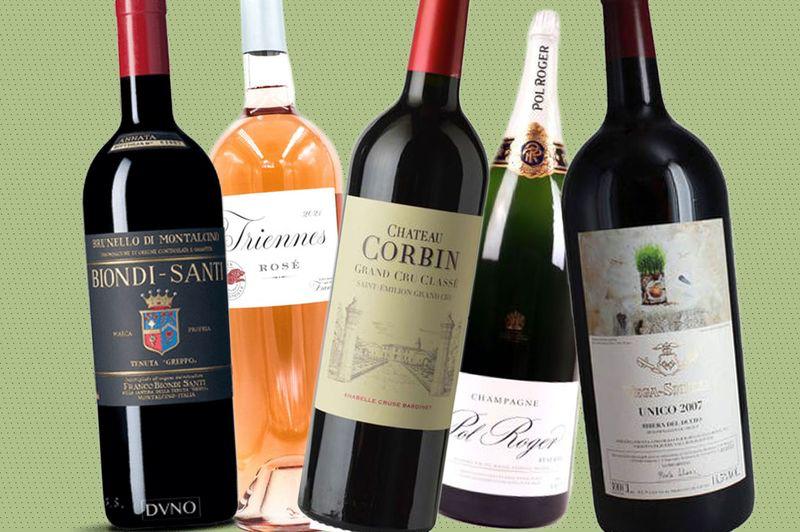
So, what exactly is a “big” bottle? The lead off is the 1.5 liter magnum, equivalent to two standard 750ml bottles, which holds about 12 glasses of wine. Now that we’re all entertaining again, they’re perfect for a six person dinner party.
Every bottle size has a name, usually Biblically inspired, though no one knows how that started: jeroboam (3 liters, also called double magnum in Bordeaux); methuselah (6 liters, known as imperial in Bordeaux); salmanazar (9 liters); balthazar (12 liters); nebuchadnezzar (15 liters); melchior (18 liters); solomon (20 liters); and for the ultimate nightlife trophy, the colossal melchizedek (30 liters), also called a midas. It holds a whopping 240 glasses worth and weighs in at about 100 pounds, requiring a sommelier who’s also a weightlifter.
And starting on Nov. 1, more than 60 restaurants and wine bars in New York, including Bar Boulud, Le Coucou, and Temperance Wine Bar will be pouring Jeroboams of 14 Bordeaux chateaux noted for their sustainable practices.

You’ll pay a premium for a big bottle, but the reasons it’s worth splashing out your cash go beyond the obvious flaunt factor.
If you pick up a big bottle of an old vintage at auction, the wine is far more likely to be in top shape than it would be in regular size bottle. That’s because the larger the format, the slower and more gradually the wine ages. The evolution of its flavor and aroma over time depends on the interaction between the liquid in the bottle and the air between the wine surface and the cork. Bigger bottles have a smaller ratio of air to wine, which slows the rate of oxygenation, allowing more complexity to develop while prolonging the wine’s life.
The rule of thumb is for every 3 liters, add five years for the wine to reach maturity. The increased volume and thicker glass also make the wine less sensitive to temperature changes and the effects of light.
The regions with the longest big bottle history are Bordeaux and Champagne, where they were often stashed for family weddings, anniversaries, or special customers like Russian czars.
Bordeaux negociant Millesima carries about 12,000 large format bottles of the region’s wines in its cellars. And if you buy futures, you can specify the bottle size you want.
Long Island based Sokolin Fine Wine Merchants also carries a wide selection of big bottles.
Right now, Port Chester, New York based Zachys is offering as much as 51% off on more than 250 big bottles, including magnums, imperials, and more. Starting on Nov. 15, Wine.com is holding a special one-week offering of large formats, with dozens of magnums under $100.
And in London, check out Farr Vintners and Hedonism Wines in Mayfair, where you can pick up a 6 liter bottle of 1982 Petrus for £121,000 ($135,907). If you’re buying in dollars, the exchange rate is on your side.


2016 Chateau Corbin ( 3L; $185)
Medium bodied and lush, this Saint Emilion is balanced and spicy, with expansive plummy aromas and plenty of ripe fruit.
October 21, 2022 Circulation: 45,521,436 Digital

Everyone likes a spectacle even wine connoisseurs.
When Philippe Newlin, now the Bordeaux buyer for wine.com, got married, he wowed his 80 guests by pouring glasses of crus classés Bordeaux from Methusalehs, or 6-liter bottles. Each one held the same amount as eight regular bottles of Bordeaux and stood nearly 2 feet high. The couple’s best friends wrote celebratory inscriptions with gold metallic markers on the glass, making the impressive empties treasured souvenirs.


So, what exactly is a “big” bottle? The lead off is the 1.5 liter magnum, equivalent to two standard 750ml bottles, which holds about 12 glasses of wine. Now that we’re all entertaining again, they’re perfect for a six person dinner party.
Every bottle size has a name, usually Biblically inspired, though no on that started: jeroboam (3 liters, also called double magnum in Bordeaux); methuselah (6 liters, known as imperial in Bordeaux); salmanazar (9 liters); balthazar (12 liters); nebuchadnezzar (15 liters); melchior (18 liters); solomon (20 liters); and for the ultimate nightlife trophy, the colossal melchizedek (30 liters), also called a midas. It holds a whopping 240 glasses worth and weighs in at about 100 pounds, requiring a sommelier who’s also a weightlifter.
And starting on Nov. 1, more than 60 restaurants and wine bars in New York, including Bar Boulud, Le Coucou, and Temperance Wine Bar will be pouring Jeroboams of 14 Bordeaux chateaux noted for their sustainable practices.

You’ll pay a premium for a big bottle, but the reasons it’s worth splashing out your cash go beyond the obvious flaunt factor.
If you pick up a big bottle of an old vintage at auction, the wine is far more likely to be in top shape than it would be in regular size bottle. That’s because the larger the format, the slower and more gradually the wine ages. The evolution of its flavor and aroma over time depends on the interaction between the liquid in the bottle and the air between the wine surface and the cork. Bigger bottles have a smaller ratio of air to wine, which slows the rate of oxygenation, allowing more complexity to develop while prolonging the wine’s life.
The rule of thumb is for every 3 liters, add five years for the wine to reach maturity. The increased volume and thicker glass also make the wine less sensitive to temperature changes and the effects of light.
The regions with the longest big bottle history are Bordeaux and Champagne, where they were often stashed for family weddings, anniversaries, or special customers like Russian czars.
Bordeaux negociant Millesima carries about 12,000 large format bottles of the region’s wines in its cellars. And if you buy futures, you can specify the bottle size you want.
Long Island based Sokolin Fine Wine Merchants also carries a wide selection of big bottles.
Right now, Port Chester, New York based Zachys is offering as much as 51% off on more than 250 big bottles, including magnums, imperials, and more. Starting on Nov. 15, Wine.com is holding a special one-week offering of large formats, with dozens of magnums under $100.
And in London, check out Farr Vintners and Hedonism Wines in Mayfair, where you can pick up a 6 liter bottle of 1982 Petrus for £121,000 ($135,907). If you’re buying in dollars, the exchange rate is on your side.
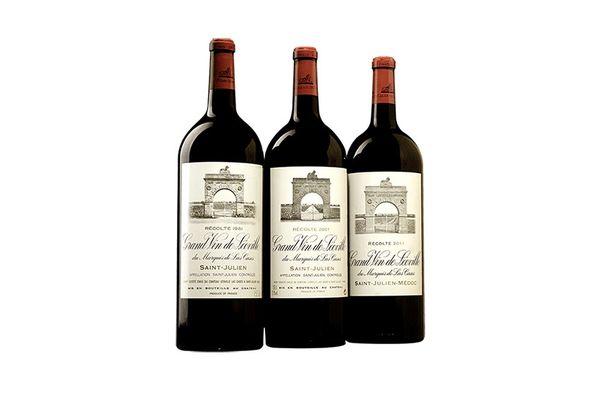

2016 Chateau Corbin ( 3L; $185)
Medium bodied and lush, this Saint Emilion is balanced and spicy, with expansive plummy aromas and plenty of ripe fruit.
October 20, 2022 Circulation: 7,769,077 Digital
Utter the word "Bordeaux" and thoughts of massive, impossibly elegant châteaux and wildly expensive bottles of red probably fill the mind. Perhaps images of monocle wearing men with posh accents and ascots are involved in the word association; Fireplaces and fine china are also likely to make appearances.
But in reality, that's not what Bordeaux is about at all. Or, rather, that's not all that Bordeaux is about. While for centuries it benefited from a reputation as the source of some of the most age worthy and sought out wine in the world, there is infinitely more to the region than car payment bottles of trophy reds.
Bordeaux is the largest wine region in France, and driving from one end to the other can take hours. From the great First Growths of the Médoc to the unexpectedly affordable and often utterly charming reds and whites that don't have that legendary pedigree, Bordeaux is a region of variety, often unexpected value, and far more range than it typically gets credit for.
Bordeaux is located in southwestern France, about a five and a half hour drive from Paris or a little over two hours on the much quicker TGV train. It's a primarily maritime climate, and is seriously influenced by the Atlantic ocean to the west but also affected by continental factors. Its weather is variable; sun and clouds can alternate in rapid succession, while rain and (increasingly) hail are not uncommon.
As in the rest of the wine world, climate change has been affecting Bordeaux's weather in often dramatic and unpredictable ways, from fires and springtime frosts to hail, heatwaves, and more. Luckily, Bordeaux is a region of blending, a process that involves combining several key grape varieties, which seems to help mitigate some of the worst impacts since different varieties bud, flower, and ripen at different times.
There are five main red varieties that are permitted in Bordeaux, in addition to a handful of newly allowed ones for wines labeled as such, as opposed to more location specific appellations. Three white varieties are important in the region, giving producers the option of leaning more or less heavily on better performing varieties for both reds and whites, depending on the conditions during that particular growing season.

Bordeaux is divided into the Left Bank and the Right Bank, with the Gironde Estuary, which turns into the Garonne and Dordogne Rivers, bisecting them. The Left Bank is home to the most highly regarded Cabernet Sauvignon based reds, whereas the Right Bank is where Cabernet Franc and Merlot thrive more famously. Between the two in the Entre Deux Mers, is where a large percentage of the region's white wines are grown and produced. Bordeaux Blanc, which typically blends Sauvignon Blanc, Semillon, and a bit of Muscadelle, is generally one of the great values in the world of French white wine.
In the south of the region beneath the Left Bank, the great sweet wines of Bordeaux are grown: Sauternes (home of the iconic Château d'Yquem), Barsac, Cadillac, and Monbazillac make for fantastic sipping wines and accompaniments to savory dishes like cheese and foie gras, as well as tropical fruit and caramel based desserts alike.
The classification of 1855 is one of the most famous in wine history, and was a response to Napoleon III's desire to showcase the superiority of French wines at the Exposition Universelle de Paris. Even today, the four First Growths that were identified back (the four top wines of the Médoc) then remain among the greatest in the region…and the world. The original ones Châteaux Latour, Lafite Rothschild, Margaux, and Haut Brion were joined by Mouton Rothschild in 1973.
Beyond the five First Growths of the Médoc are wines classified as Second through Fifth Growth. Among the seconds, there are a number that are widely believed to be of similar quality as the Firsts. They are often referred to as Super Seconds, and include Château Léoville Las Cases, Pichon Longueville Comtesse de Lalande, and more.
Though the top wines weren't classified in 1855, the Right Bank is home to some of the most legendary names of the region. In Pomerol, Merlot sings a particularly unforgettable tune, and producers like Pétrus, Le Pin, La Fleur-Pétrus, VieuxChâteau Certan and more are justifiably clamored for by collectors. In neighboring St. Émilion, Cabernet Franc is (typically) king. There, Cheval Blanc, Ausone, Angélus, and more are worthy additions to any dinner table or collection. Châteaux Pavie and Lassègue are also stellar.
As a rule of thumb in the world of wine, the more specific the geographical location is on a bottle, the better and often more expensive it will be. Wines labeled with the name of a specific commune (St. Julien and Pauillac, for example) will typically fetch more money than those labeled as Médoc, the areas where those particular communes are located. Yet that doesn't mean that delicious wines are only found in those particular and specific places.
Bottles labeled Bordeaux and Bordeaux Supérieur are often available for less than $25 sometimes much less and, since they come from parts of Bordeaux where the land is less expensive (and less prestigious in the grand scheme of things), they offer a taste of what makes Bordeaux so special without requiring the same outlay of money. They don't generally age as well as the great classes growths, but they're not typically meant to. Other appellations in Bordeaux worth looking for include Bourg, Blaye, and Fronsac, among others.

The reds of Bordeaux generally tend to be a bit less fruit focused than many of their so called New World counterparts, with tasting notes often referencing pencil shavings, sage, cedar, violets, spices, and minerality alongside fruit notes like currants, plums, and cherries.
Whether red, white, dry, or sweet, wines from Bordeaux are worth learning about and tasting. At their best, they are delicious on their own, excellent pairing partners for a wide range of food, and run the gamut of pricing from less than $20 and into the thousands. No matter what you drink from Bordeaux, however, one thing is consistent across the board: No ascots, monocles, or posh accents are necessary. In fact, it's best to avoid them altogether and just enjoy the wine.
Bordeaux is divided by the Garonne and Dordogne Rivers into the Left and Right Banks, both make up two distinct wine regions within Bordeaux. The Left Bank, south of the rivers, focuses on red blends made primarily with Cabernet Sauvignon. The Right Bank, north of the rivers, focuses on red blends made primarily with Merlot. Regardless, both the Left and Right Banks of Bordeaux are equally worth sipping in. We have laid out a few of the top tours, wineries, where to stay and things not to be missed when visiting Bordeaux.
City to Visit: St. Emilion: The Hill With 1,000 Chateaus
St. Emilion is an open air museum founded by an 8th century Breton monk named Emilion. Explore the gorgeous city center, brimming with historical monuments, before heading out in the vines.
The Monolithic Church and its bell tower, with a underground portion. Much of the church is closed off to the public, so you need to book a tour, where you’ll learn about the monk and his cave, a world famous fertility chair, the Trinity Chapel with medieval paintings, catacombs and more. Another stop not to miss on the Right Bank is The Kings Keep, a square dungeon dating back to the 13 century.
Setting the Stage Merlot is the star of Bordeaux’s Right Bank, and the wineries tend to be smaller and more laid back than the chateaus of the Left Bank.
This organically farmed winery in Fronsac is farmed and run by Benoit and Maud Soulies, who purchased the 16t century estate in 2016. Their chateau is simple, but their welcome is warm, and they also open their fields to camper vans and RV’ers who want to park and enjoy an overnight amid the vines during the summer and early fall.



 Jill Barth
Jill Barth
But in the wine industry, the word can represent anything from lip service to demonstrated action. Terms like organic and biodynamic are defined, and are often the standard bearers for ecological responsibility. But some solid wineries choose not to certify. Others may be in conversion. Others go above and beyond and find those labels less than potent. Some wineries lose certification after a particularly hard season, but still hold true to values that are considered environmental and social standards. Just because a wine or winery isn’t organic or biodynamic on paper doesn’t mean it’s up to no good.
Jean-Baptiste Cordonnier and Nathalie Coipel Cordonnier are the proprietors at Château Anthionic in Bordeaux, where grapes are grown organically. But the domaine takes it further than that, defining what is being done not only for vine production, but also to improve the area around the château with agroforestry, planting trees in and near the vineyards to reduce the impact of climate change and provide a refuge for wildlife. These are acts that, for now, aren’t defined by any official certification or stamp, but the winery itself defines and communicates these efforts to help consumers understand that the wine they purchase reflects biodiverse values.
Sometimes a winery will be required to demonstrate social or environmental responsibility before identifying itself as part of a larger entity. Every château in the Crus Bourgeois du Médoc classification, for example, must have obtained a High Environmental Value certification. This is codified by the French government, ensuring a property addresses four elements: biodiversity conservation, plant protection strategy, management of fertilizer use, and management of water.
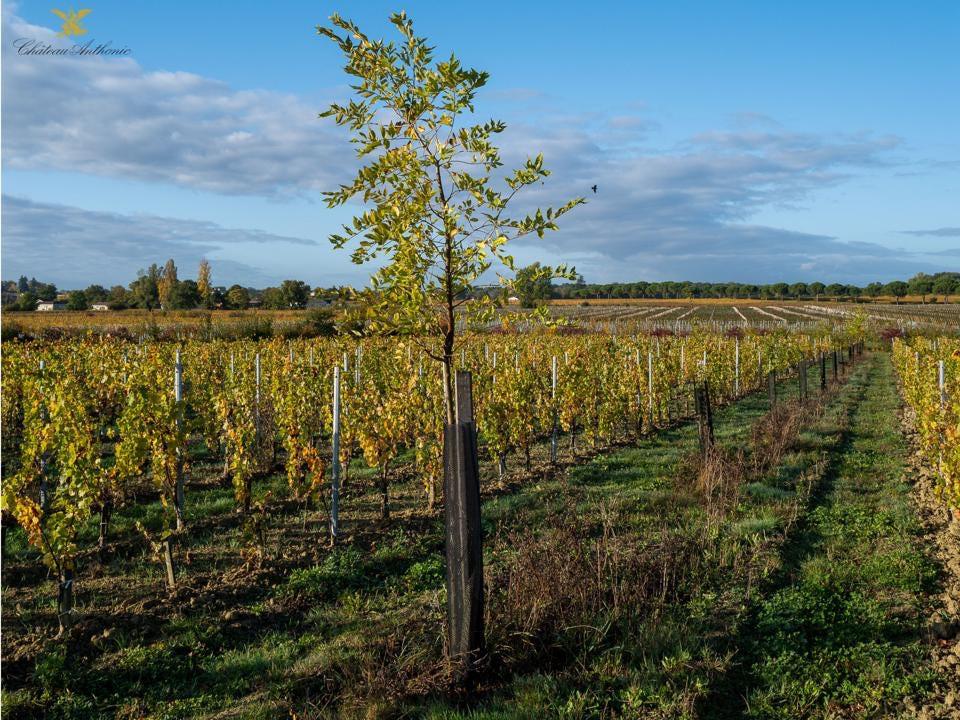 Chateau Boutinet
Chateau Boutinet
Husband and wife duo Nathalie and Jerome opened their doors in 2011. Located on 30 acres of vineyards, 22 acres of wood and 12 acres meadows, with a ruined castle and a deep dedication to organic winegrowing, visitors can take part in yoga and tasting workshops, and learn how becoming rooted in the flow of yoga can open up new layers of tasting and aroma experiences. ($45). They also host a weekly wine and dine, with a tour of the vineyards, an explanation of their approach to biodiversity, and a wine and tapas party. ($25).
If you have your heart set on the iconic Bordeaux experience, head over to Chateau Saint Georges, which is set on the highest hill of the George Saint-Emilion appellation, Bordeaux’s smallest. The roots of the estate date back to the 4th century, when a spending villa was erected by the Latin poet Ausone. Today, the stunning 18th century architecture, 111 acre single block vineyard and formal gardens can be explored with tastings that start at $9, and range from classic vineyard and winery tours to country picnics on the estate.
Camp at La Brande for an authentic vineyard experience, or go the fairytale route and stay at Chateau de la Riviere in Fronsac, with a like setting, vast underground cellar, lovely pool, spring fed pond, incredible library, DIY tea blending Tisanerie and formal gardens. While you’re there, explore the beautiful reds, whites and rosés produced on the 168-acre estate. Prices start at $140.
Cabernet Sauvignon is the dominant grape here, and the Left Bank has earned a reputation for producing powerful wines that can stand the test of time. The estates here tend to be bigger and sometimes grander than those of their compatriots on the Right Bank. The chateaux of Lafite Rothschild, Latour, Margoux and Mouton Rothschild, plus 56 other exceptional estates, are featured on the world famous 1855 Classification list.
If you’re thirsty for a deep dive into the Medoc’s history, consider a half day tour focused on the Margaux appellation, with visits to two classified growth chateaux. $80 per person.
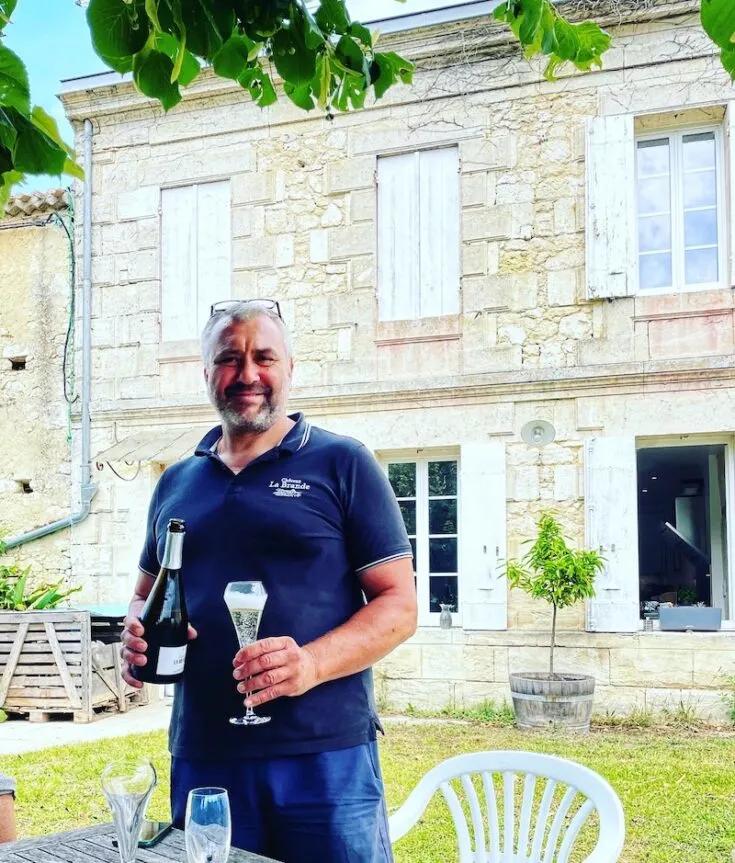
For an adventure you’ll remember forever, invest in a sidecar tour of vineyards and castles, with tastings at classified castles across the region. $319 for two.
This classified Cru Bourgeois has perfected the art of French living, and visitors can indulge in the wine, food and leisure that accompanies it. The 18th century chateau offers a guesthouse with a poolroom, music room, basketball, pétanque and formal gardens. You can stay at the Chateau, and attend the Food & Wine Academy, but contact the chateau for reservations and prices well ahead of time.
The roots of this Chateau date back to the 13th century, and the estate has been a designated historical monument since 2012. The owner’s daughter, Alice, offers a tour of the winery, which begins with a feeding of the friendly and beautiful peacocks that dot the landscape, continues with a tour of the grounds and the winery, and a tasting of the wines. (Grape juice is available for children). $12 per person.
Everything at the Grand Cru Classé Chateau Smith Haut Lafitte is geared toward a holistic relationship with the earth, from the farming to the tourism experiences. The chateau owns a vine nursery on Ile de Lalande, an investment it made to protect and ensure vine purity. The 215 acre biodynamically and organically farmed estate is surrounded by forests and hedges, and dotted by bee hives, to encourage biodiversity. The estate also features an on site cooperage, is solar powered, it uses horses in lieu of tractors to plow the soil and they create their own biodynamic sprays to treat the vines for diseases, instead of using chemicals.
Reserve a visit in advance, and either discover the adjacent Forest of the Senses, a 25 acre open air museum and walking trail dotted with contemporary artworks, tree houses and sculptures juxtaposed by the owl and bat boxes, honey house and medicinal herb garden. Or, take one of many customized tours of the estate, private cellar and art collection, along with tastings of the Grand Cru Classé wines. Prices start around $185 for four people.
For a luxury stay, the 5 star Palace hotel Les Sources de Caudalie, owned and managed by the Smith Haute Lafitte’s Alice Tourbier Cathiard, is it. Nestled within the vineyards, this contemporary hotel is constructed from recycled materials and features three restaurants, including the 2 Michelin starred La Grand’Vigne and a Spa Vinthotherapie, with hot springs, a hammam, a jacuzzi and an array of treatments. Prices start at $310.
Budget hotels are still hard to come by on the Left Bank, but Chateau Leognan punches well above its weight class in terms of what you get. The 15 acre 17th century estate offers private and group tours, tennis courts, guest rooms with a restaurant on site. Prices start at $130.

July 28, 2022 Circulation: 9,500 Digital

 Brianne Cohen
Brianne Cohen
A new month awaits, which means a new batch of wines for me to share with you for my Best Bottles: July Edition. If you miss the IG Live, don’t fret, all the wine details are below or you can re watch it on my Instagram feed.
Without further ado, I bring to you my best bottles for the month of July!
We are in Bordeaux between two seas, or Entre Deux Mers, as you see on the label. Bordeaux is a region in France that is famous for its incredible red wines. Which means that a lot of times people sleep on their white wines. A white Bordeaux is really nothing to ignore! As a reminder when we are in the Old World, or in Europe, we can only grow certain grapes in certain regions. In Bordeaux the white grapes allowed are Sauvignon Blanc and Semillon. So, if you’re a Sauvy B drinker, and want to try something different, reach for a white Bordeaux. You really don’t need to know more than that. If you see a wine bottle that says Bordeaux on the front of the label and it’s white, it’s gonna be Sauvy B based. This Chateau Canteloudette wine is super easy to drink, a daily drinker, porch pounder if you will. We don’t need to go any deeper than that. This is your “I’m having a bunch of people over, throw a few bottles on ice type of wine” and everyone will be happy.
 Chateau Canteloudette Entre-Deux-Mers 2020 $15 (Bordeaux, France)
Chateau Canteloudette Entre-Deux-Mers 2020 $15 (Bordeaux, France)
July 29, 2022 Circulation: 4,027



When you buy something using retail links in our stories, we may earn a commission. Wine Enthusiast does not accept payment for reviews of wines, beers, spirits or other products. Read about our blind tasting and review process here. Prices may vary depending on retailer.


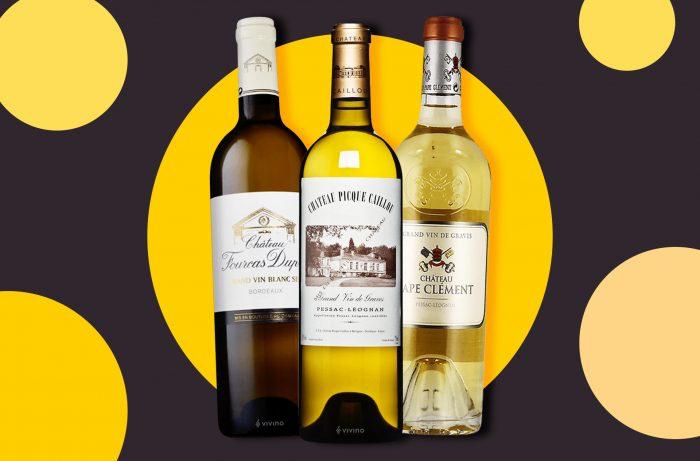
About 3 hours south of Paris is one of the most revered wine regions of the world. Bordeaux has been one of the epicenters of the wine world for centuries. While so many people seek out their red and dessert wines, their white wines are not something to be overlooked.
Primarily made from Sauvignon Blanc and Sémillon, it can also have a small percentage of Muscadelle. Sauvignon Blanc is known for its high acidity and herbal notes, while Sémillon lends body to the blend and soften the wines. Depending on the percentage of the grapes, the wine can go from tart acidity with citrus and grassy notes to a richer mouthfeel with baked apple tones.
Château Carbonnieux 2019 Pessac-Léognan; $45, 94


Points The estate is noted for white wine, and this latest release lives up to the reputation. This textured, mainly Sauvignon Blanc wine has tight acidity set against wood aging and ripe citrus and white fruit flavors. Drink the wine from 2024. Cellar Selection Roger Voss
Wood aged, this balanced wine is poised between ripe citrus and spice. It offers a hint of pineapple along with lively acidity. Editors’ Choice Roger Voss

Château

From an estate in Listrac, this is a ripe, young and lightly honeyed wine. With a touch of spice and vanilla, the wine has developed well. Drink from 2022. Roger Voss
Château La Gabarre 2021 Bordeaux Blanc; $10, 88 Points
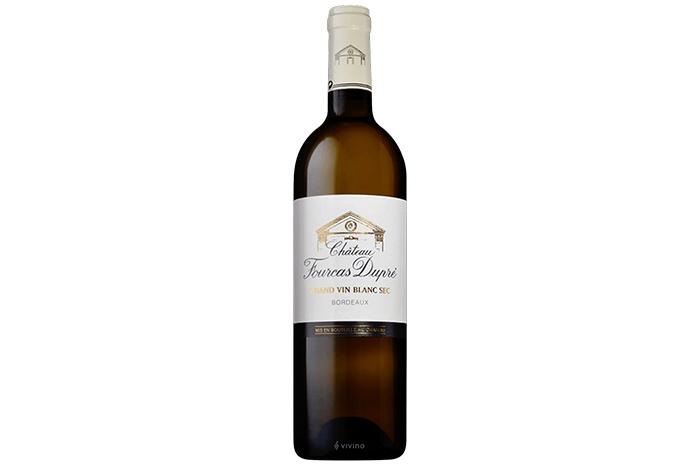
This is packed with green fruits, rounded by kiwi and acidity. The wine is fragrant with great final freshness. Drink now. Best Buy Roger Voss
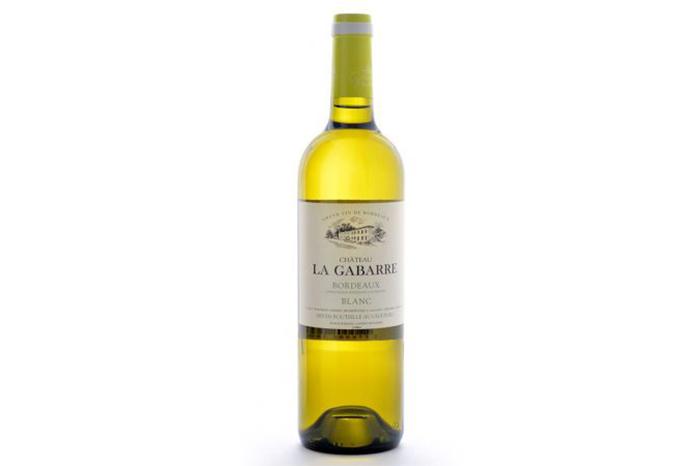
This vintage shows swathes of ripe fruits that have a youthful, textured character. Wood aging has added spice and rounded out the white fruitflavored texture. This complex wine will age and should be drunk from 2024. Cellar Selection Roger Voss
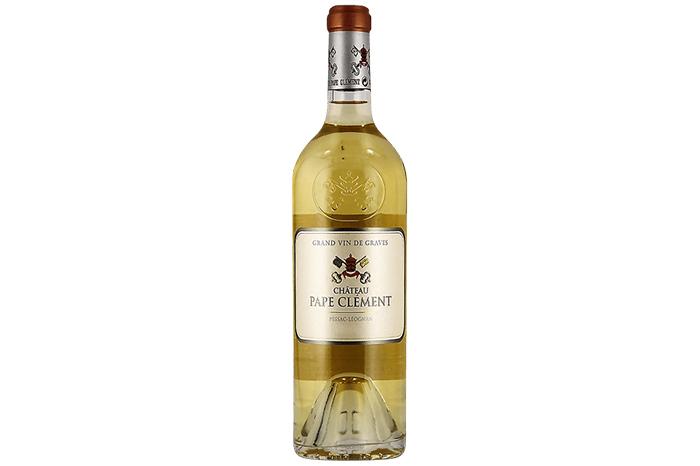

While this wine is still young, it has all the elements of aging potential. The bright green and citrus fruits are spiced with wood aging and a vivid, taut texture. The wine is sure to develop, to be ready to drink from 2024. Cellar Selection Roger Voss

Château Roc de Minvielle 2021 Bordeaux Blanc; $17, 89 Points


Bright and fruity, the wine’s apple and grapefruit flavors are taut and textured. It is a lively young wine, better from later this year. Best Buy Roger Voss
Perfumed and with fine fruit, the wine is full of baked apple fruitiness. Its rounded spicy aftertaste gives the wine complexity and a fine tangy aftertaste. Drink now. Best Buy Roger Voss
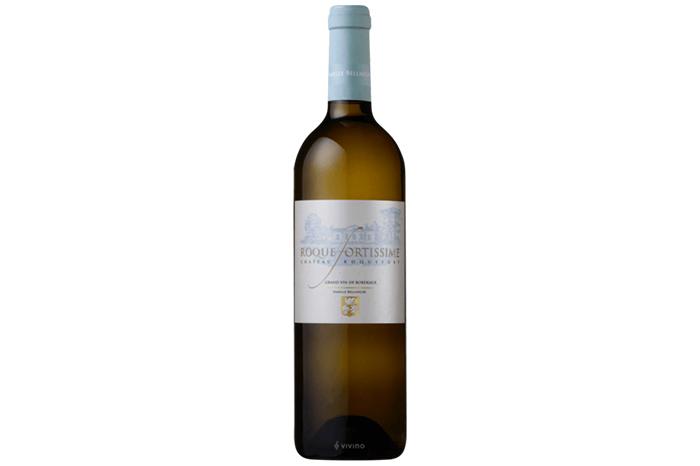
The late Denis Dubourdieu was a leader in developing Bordeaux white wines. His family carries on his legacy in this smooth, creamy and rounded wine. Acidity and fresh citrus come through at the end. Drink from 2023. Editors’ Choice Roger Voss
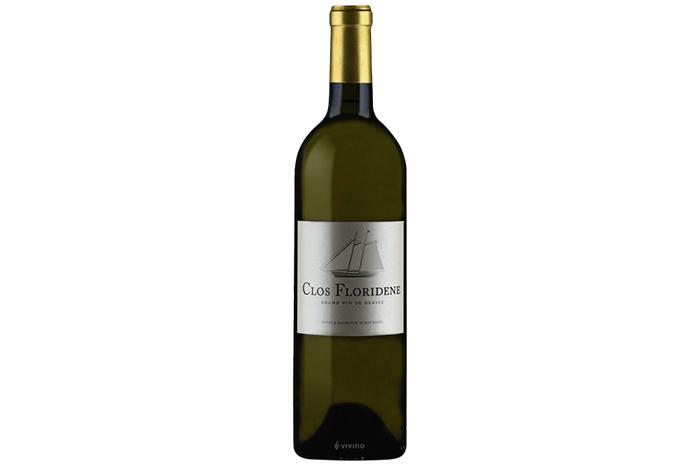
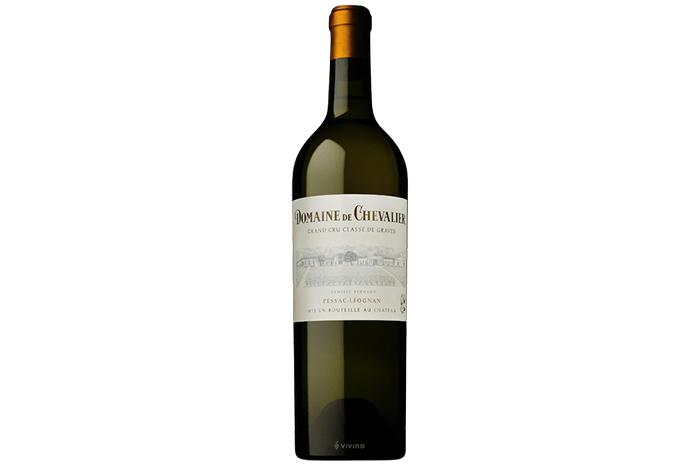

The latest release of this legendary white wine comes from a mere 17 acres of the 165 acre vineyard. Wood aged and rich in ripe Sauvignon Blanc, the wine bursts with energy and white fruits, touched by spice and with a long aging ahead of it. Drink this wine from 2025. Cellar Selection Roger Voss
July 20, 2022 Circulation: 441,900 Digital
White Bordeaux (Bordeaux Blanc) wines are crafted using the Sauvignon Blanc and Semillon grape varieties, along with small quantities of Sauvignon Gris and Ugni Blanc.

Only around 10% of all Bordeaux wine is white. The remaining 90% of the region’s wine production is dedicated to red Bordeaux wine.
Interestingly, this wasn’t the case until a few decades ago.
Until the 1950s, white Bordeaux wines accounted for around 50% of the total production. What changed this was the devastating frost of 1956 followed by the growing demand for red Bordeaux.
Nevertheless, the seductive aromatics and nutty flavors of the unique Bordeaux blanc wines will lure you in!
Let’s travel to the Bordeaux region and discover the exotic white Bordeaux styles, 8 delicious bottles, vineyard and winemaking practices, and the major white Bordeaux appellations and producers.
There are two different white Bordeaux wine styles.
Bordeaux’s dry white wines are light and fruity and are usually a wine blend of Semillon and Sauvignon Blanc grape varieties. Some may also have the Ugni Blanc grape variety.

The best dry white wines are produced in the Pessac Leognan and Graves appellations.
The sweet white Bordeaux wines are rich, creamy, and luscious, admired for their racy acidity and honeyed flavors. The Sauternes white wine is the most popular sweet white Bordeaux wine.

Besides its seductive aromas, white Bordeaux wines also offer a brilliant opportunity to taste the best of Bordeaux’s terroir without burning a hole in your wallet.
Also, this white wine is easy to pair with a wide variety of foods.


Dry white Bordeaux wine is light and has citrus, floral, lemon, and grapefruit notes with a distinct minerality.
Sweet wine has strong honeyed fruit notes of tropical fruit, peach, apricot, lemon, and orange with nut, vanilla, spice, and floral hints.
Serve your Bordeaux Blanc wine with seafood, chicken, veal, or cheese at 12oC 15oC to get the best of its flavors.
8 Delicious White Bordeaux Bottles To Buy In 20211. 1847 Chateau d'Yquem, Sauternes, France ($111,581)
One of the finest sweet wines, this Bordeaux Blanc entices you with a luscious sweet fruit flavor, lovely spice and floral aromas, and subtle acidity.


2. 2009 Liber Pater Blanc, Graves, France ($4,278)
This 2009 white wine from Bordeaux is rich, fleshy, and has strong creme brulee, nut, and pear flavors.

This Semillon wine from the Pessac Leognan appellation has vibrant acidity with subtle creme brulee, mandarin orange, and marmalade nuances.
4.2011 Chateau Cheval Blanc 'Le Petit Cheval Blanc' White, Bordeaux, France ($228)
This Bordeaux white has fresh citrus, apple, and pear aromas and lovely acidity.


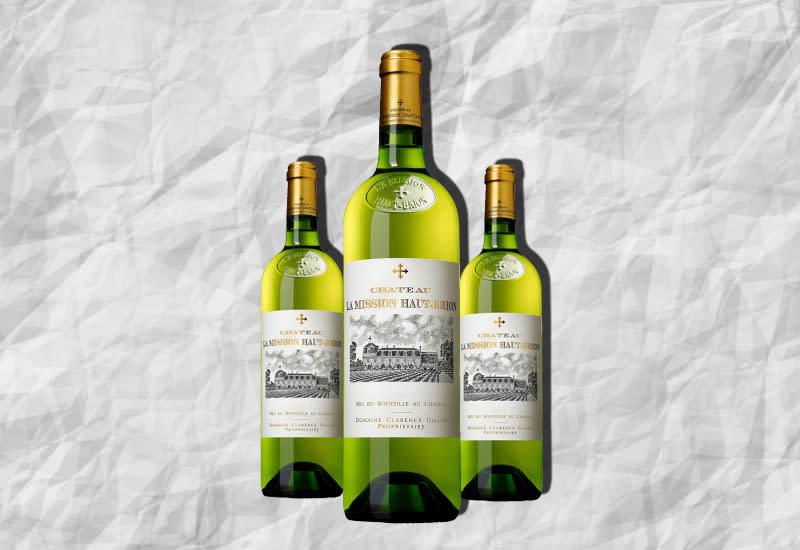
5.2003 Chateau Cos d'Estournel Blanc, Bordeaux, France ($343)
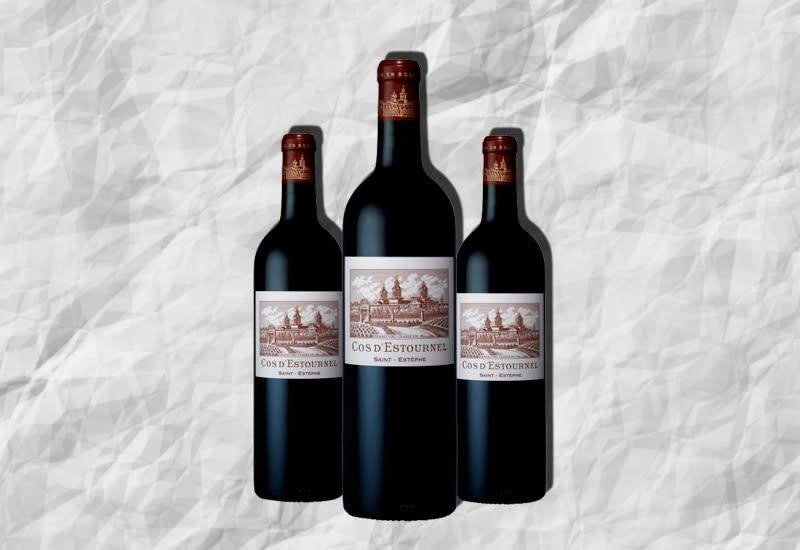
This white Bordeaux wine has a rich nose of honeysuckle, black cherry, plum, smoke, and tobacco.


6.2009
This Pessac dry white has alluring aromas of citrus, honeyed melon, grapefruit, and lemon zest. The palate of this Bordeaux Blanc has terrific acidity.
Chateau Smith Haut Lafitte Blanc, Pessac Leognan, France ($162)7.1983 Domaine de Chevalier Blanc, Pessac Leognan, France ($253)
The Domaine de Chevalier Blanc Pessac Leognan vintage is complex and concentrated. This dry white Bordeaux has lemon, citrus, and oak aromas.
8.2010 Aile d'Argent Blanc du Chateau Mouton Rothschild, Bordeaux, France ($127)


This Bordeaux vintage has a complex nose and rich palate with soft acidity, oaky notes, and a long honey finish.
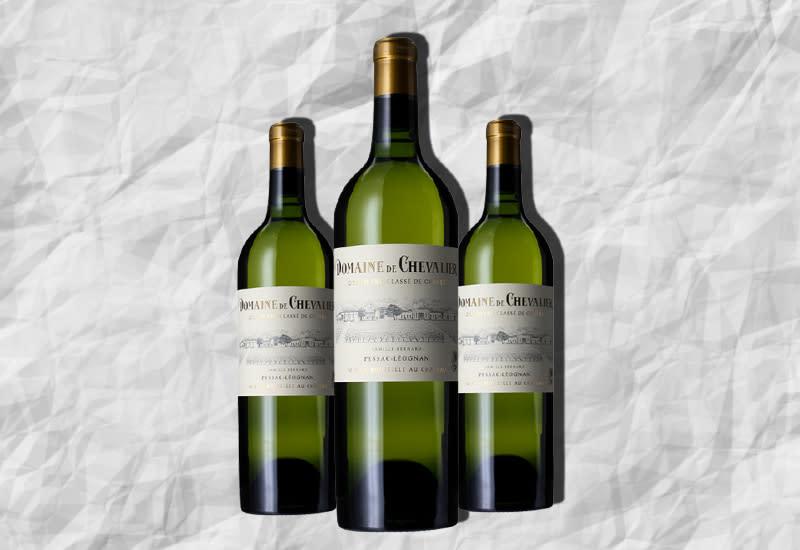
If you wish to invest in a fine Bordeaux white wine then an online wine investment firm like Vinovest can help you buy, store, and sell authentic wines easily.


A fine white Bordeaux has the potential to improve for 10 20 years on average.
However, you’ll be surprised to know that a rare Chateau d’Yquem vintage can age for over 100 years!
Also, unlike red Bordeaux wines (delicious Cabernet Sauvignon, Merlot, and Cabernet Franc grape blends), the white Bordeaux blend wines are not produced widely, adding to their rarity.
So, wines from prestigious producers like Chateau d’Yquem and Chateau Haut Brion command high prices and have a good price appreciation as well. For example, the 1946 Chateau d’Yquem grew by 314% from $2,050 in 2020 to $8,510 in 2021.
The secret of a fine White Bordeaux lies in the brilliant terroir of the region.
The limestone soils are perfect for Bordeaux white grapes. The sandy stone and gravel provide good drainage for the vine plantings. Also,
The grape bunches are picked at the perfect phenolic ripeness when acidity and sugars are balanced and are pressed quickly after picking.
Fermentation of white grapes takes place in stainless steel tanks, cement vats, or French oak barrel at 18oC 20oC (lower than red wines.) Dry wine also goes through malolactic fermentation.
The wine is aged in either barrel or stainless steel tanks. Some winemakers age their wine on lees to give a richer, complex flavor.
White Bordeaux wines are produced in almost every Bordeaux appellation. But the major ones are:

• Left Bank White Bordeaux: Medoc, St. Estephe, Pauillac, and St. Julien take the center stage, with some significant producers being Chateau Mouton Rothschild, Chateau Talbot, Chateau Margaux, Cos d’Estournel, and Chateau Lynch Bages.
• Right Bank White Bordeaux: Most white wines are produced in Saint Emilion by Chateau Monbousquet, Valandraud, Chateau Tour Saint Christophe, Fleur Cardinale, and Chateau Cheval Blanc.
• The Sauternes and Barsac regions produce the best sweet white Bordeaux wines. They’re home to some brilliant producers like Chateau d’Yquem, Chateau Rieussec, Chateau, Climens, and Chateau de Fargues.
• Some Bordeaux producers like Chateau Palmer, Chateau du Retout, Clos Dubreuil, Chateau Vieux Taillefer, and Chateau Petit Fombrauge produces white Bordeaux’ with non Bordeaux grapes like Chardonnay and Merlot Blanc. These wines are sold under the name Vin de France.

White Bordeaux wine is aromatic, flavorful, and divine thanks to the brilliance of Semillon and Sauvignon Blanc. The best of these sweet Bordeaux wine bottles also make great long term investments. Visit the Vinovest website to explore how you can build a fine collection of dry white wine, Pinot Noir red wine, a sweet botrytis wine, and more easily!
July 20, 2022 Circulation: 572,209 Digital
 Madeline Puckette
Madeline Puckette
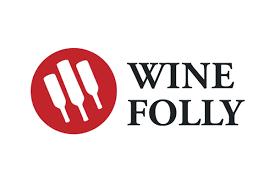
What is White Bordeaux? Well, the major grapes include Sauvignon Blanc, Semillon and Muscadelle. Find out what this famous white wine blend has to offer including food pairing recommendations.
The grapes of White Bordeaux include Sauvignon Blanc, Semillon and Muscadelle. There are a few other less known varieties used in White Bordeaux such as Colombard and Ugni Blanc (the grape used in Cognac), but most White Bordeaux are made of Semillon and Sauvignon Blanc.
Bordeaux is where Sauvignon Blanc originated and it’s very old. In fact, it’s older than Cabernet Sauvignon

There are two major styles of White Bordeaux: Light & Fruity or Rich & Creamy. Light & Fruity styles make up the majority of White Bordeaux and are generally cheaper. Rich & Creamy White Bordeaux wines are made in a specific region (Pessac Leognan) and tend to be expensive. So what do the two styles of White Bordeaux taste like?
This is the most readily available style of White Bordeaux. Expect big flavors and aromas of citrus, grapefruit, lemon, gooseberry and lime along with grass, freshly wet concrete, honey, passionfruit and honeysuckle flower.
This is the most highly sought after style of White Bordeaux. These wines tend to be predominantly Semillon which offers a much richer, more oily feeling on the tongue than Sauvignon Blanc. Expect flavors of baked apples and pears, crème brûlée, carmelized grapefruit, orange zest, ginger, figs, lemon butter and even chamomile.
If there’s basil, lime, avocado or garlic in your food, you will enjoy a bottle of White Bordeaux.
Of all the Sauvignon Blancs in the world, White Bordeaux tends to be more citrus and floral vs. grassy and herbal. The acidity is not as high as Pouilly Fumé (a Sauvignon Blanc from the Loire Valley) and the flavor is not as tropical or peachy as California Suavignon Blanc. Remember to be careful pairing White Bordeaux with overly acidic foods that will overshadow the wine.

• Arugula Salad with Lemon and Parmesan
• Asparagus Risotto
• English Pea Ravioli with Crab or Lobster
• Angel Hair Pasta with Basil Pesto
• Yellowtail Sushi with Avocado
• White Fin Fish, such as Cod or Halibut, with Beurre Blanc

White Bordeaux only makes up about 7% of wines sold from the region, the rest is red. While the region is famous for its high priced collector wines, they make up less than 5% of the region’s production. The remaining wines of Bordeaux offer exceptional value, if you know where to look!

July 15, 2022 Circulation: 5,000 Digital
I’ve no doubt shared my love hate (anti love?) relationship with Sauvignon Blanc. Give me mineral and stone and I’m in love. Tropical fruit characteristics? Bring it. But you certainly miss me with the really green, grassy ones. I’ve tried to appreciate them, but its just not my thing. Lucky for me that there are no shortage of Sauvignon Blancs that I enjoy. And that includes Sauvignon Blanc from Bordeaux. After all, the variety originated in France. Yes, its spiritual home is France’s Loire Valley where it takes on the aforementioned mineral and stone characteristics. But if you’re sleeping on Sauvignon Blanc from Bordeaux, you are certainly missing out.
This month, the French #Winophiles group of writers are exploring Sauvignon Blanc but only those that hail from France. We love you Chile and USA, but this time, its all about France.
I mean why not Bordeaux Blanc? The reds get all the press (I certainly collect my share of First Growths) but the dry white wines of the region are absolutely worth seeking out.
By the Numbers:
• 12 AOCs for dry whites in Bordeaux

• 8 main grape varieties. Some iconic (like Sauvignon Blanc) and some unexpected (we see you Alvarinho and Liliorila)

• 2 main styles of dry white Bordeaux: Lively & Fruity and Structured & Generous. Try them both!
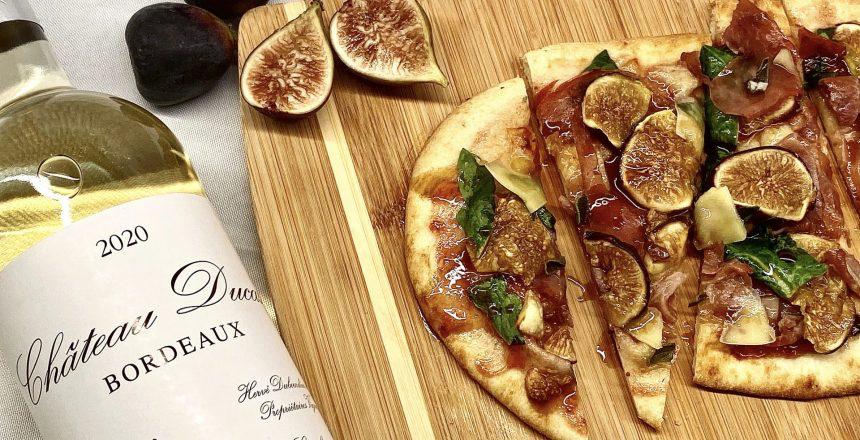
• 75% of planted vineyards in Bordeaux have environmental certifications with producers upholding a collective commitment to sustainable winemaking. Biodiversity, bee farming, agroforestry and more are being embraced. See my article on sustainable wine regions for more.

• 1,800 women and men who are currently carrying on the tradition of producing dry white wines in Bordeaux, mostly on small properties passed on over generations.
What is Sauvignon Blanc from Bordeaux Like?
While the wines of the Loire are known for their bracing acidity, Sauvignon Blanc from Bordeaux tends to see some oak aging (but usually more subtle than New World versions) resulting in wines that are a bit fuller bodied and richer. Of course, there are some that are lean, fresh, and crisp having seen little to no oak. In Bordeaux, Sauvignon Blanc is often blended with Sémillon which takes the edge off the acidity in the wine. So you’re left with a wonderful balance of acidity and creaminess. And apparently there are folks in the US that appreciate Bordeaux Blanc, since it is the #1 market for Bordeaux dry white wines. Who knew?!
When looking for a Bordeaux Blanc, wines from Pessac-Léognan and Graves are always a sure bet. However, don’t overlook the wines from the Bordeaux and Entre Deux Mers appellations as these wines are often a bargain and delicious to boot. And of course, don’t forget about those sweet white Bordeaux wines which are so delicious to pair. Of course in these wines, Semillon tends to be the star of the show, with Sauvignon Blanc playing more of a supporting role. But to be sure, dry white AOC Bordeaux wines are also showing up in areas historically known for their sweet wines and even in the Médoc, which of course is known for its stellar red wines.
Right away, one of the greatest enjoyments of these wines is how ridiculously affordable they are. So many great ones can be had for around $15 20. Many of these wines are great on their own and are easy drinking almost too much! But just as many will enjoy a spot on the dinner table.
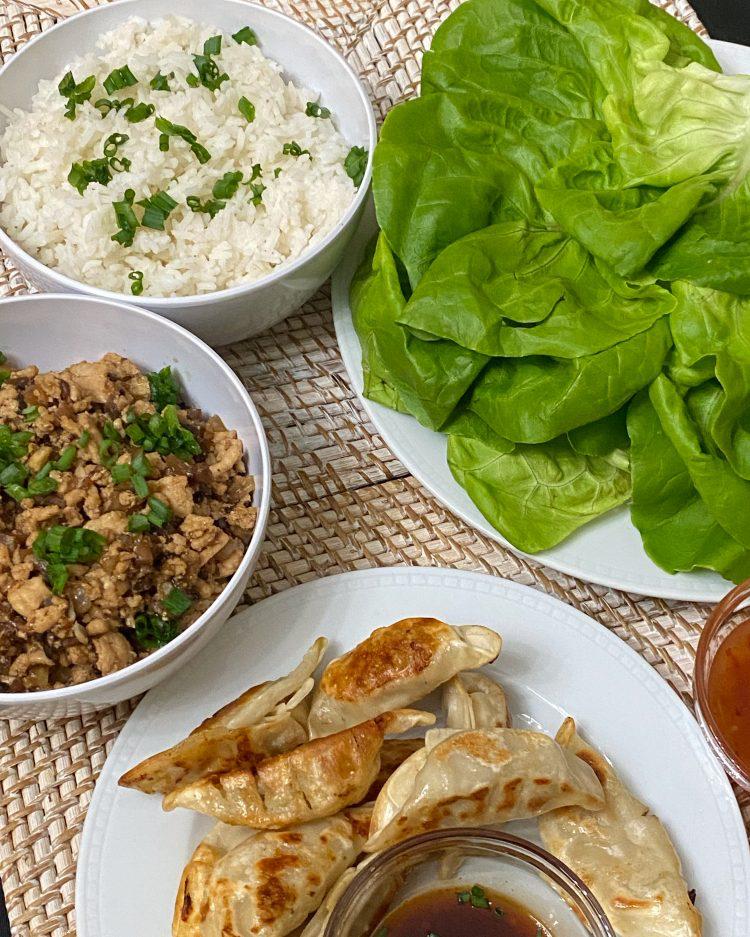
Château Suau is a blend of 80% Sauvignon Blanc and 20% Semillon with fruit sourced from the Cadillac Côtes de Bordeaux appellation. Peach, apricot, and orange citrus notes means this one can easily be enjoyed on its own. But we loved having it for dinner with chicken lettuce wraps. The umami and sweetness of the chicken and its sauce were great with the ripe fruit and aromatic nature of the wine.

Typically found for less than $20 it was the #36 on the Top 100 Best Buy 2020 list from Wine Enthusiast Magazine.
Switching gears, Château Ducasse is a blend of 60% Sémillon, 35% Sauvignon Blanc and a touch of Muscadelle and screams summer sipper. And while Sémillon leads the way, I always appreciate the lift, structure, and acidity provided by Sauvignon Blanc in blends such as this. Soft and round with stone fruit and honeysuckle with some lively acidity. Château Ducasse is made from 35 year old vines in the Barsac municipality. Since Sémillon is more prominent, we wanted to complement (as opposed to contrast which we sometimes do) the characteristics of the food. Enter grilled flatbread with figs, prosciutto and balsamic.
This one can be had for $18 from importer
In my market, its anywhere from $20 to $23 at local wine shops Houston Wine Merchant and Vinology. And just to let you in on a great pairing tip Bordeaux Blanc is my go to for gumbo. Seriously!

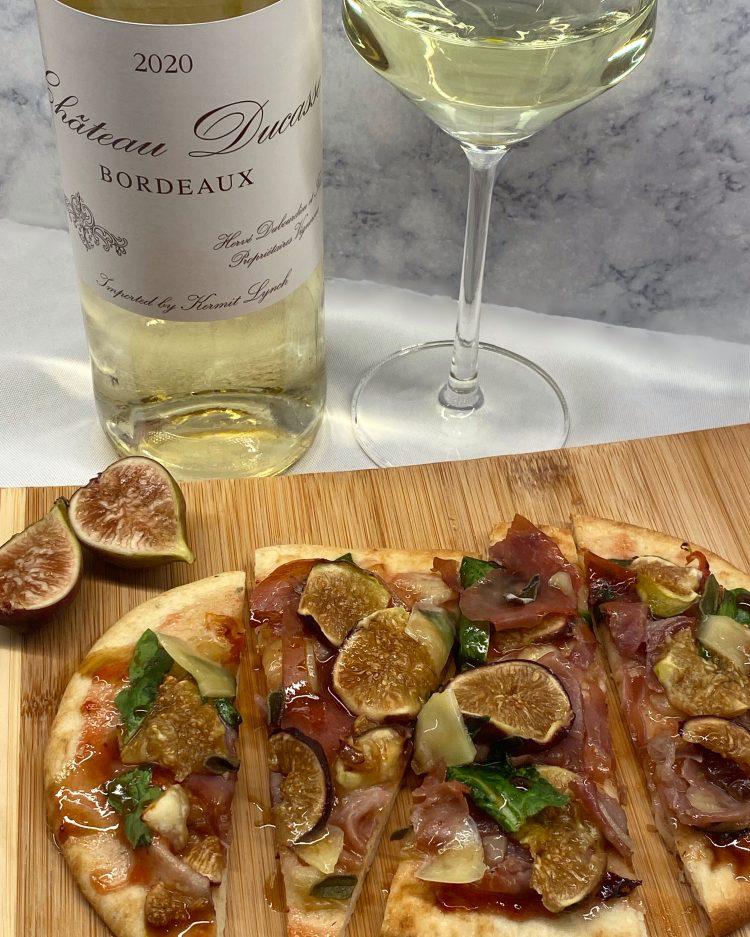 Kermit Lynch.
Kermit Lynch.


 Debbie Gioquindo
Debbie Gioquindo
We are into the dog days of summer and there is nothing like a great white to relax and cool off with. I know when you think of Bordeaux you think red wine, but did you know that there are 12 AOC’s in Bordeaux for dry white wines. Did you know that Sauvignon Blanc and Semillon are the two predominate white grapes of Bordeaux.
When you think of Sauvignon Blanc, Bordeaux Sauvignon Blanc is different. It’s classy, elegant and acidic, but not racy acidity that is going to leave you with grapefruit pith in your mouth. Bordeaux Blancs are blends and Semillon and Sauvignon Blanc that complement each other so well. Where you get a lot of citrus from Sauvignon Blanc, you get some stone fruit, apple and floral notes with Semillon that balances out the acidity in the wine.
Bordeaux Blanc is the perfect summer white. It’s easy drinking, and refreshing compliments many seafood and cheese dishes and the best is that many are priced about $15.



I had the opportunity to taste two Bordeaux Blancs which I enjoyed. If you see them at the wine shop, definitely reach for it.
2020 Chateau Ducasse Bordeaux Blanc 13 ha planted in clay and limestone with an average vine age of 35 years. This is a blend of 70% Semillon and 30% Sauvignon Blanc. I will say the Sauvignon Blanc shined through on this wine. Aromas of sweet red grapefruit, hay white flowers with a touch of minerality. The palate was soft and balanced with notes of red grapefruit, white peach, citrus, and pomelo with a hint of green grass on the finish. The wine says summer excitement.
2020 Chateau Suau Bordeaux Blanc Sec Another great Bordeaux Blanc for the summer! This blend is 80% Sauvignon Blanc and 20% Semillon. Aromas of lemon, white flowers, white grapefruit with a hint of stone fruit. The palate is soft, elegant and easy drinking. Flavors of pineapple, white grapefruit, citrus finish that leaves the acidity tingling on your tongue. This is a great pool, beach, boating and picnic wine.
July 11, 2022 Circulation: 2,062,136 Digital

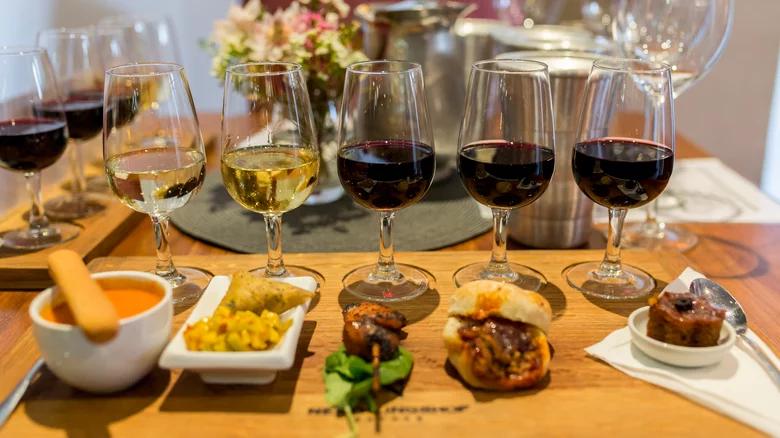 Carrie Dykes
Carrie Dykes
Have a special bottle gathering dust in your cellar? No need to plan an elaborate meal around it — in fact, the same pairing rules apply to snacks, comfort foods, and takeout. Wines with more residual sugar are great for cutting through rich, fatty foods; high acid wines will temper spice; deep, concentrated tannic expressions need a hefty counterpart; and lighter, fresher styles can amplify delicate dishes.
We flipped the script on luxury wine pairings for people that don't want to spend 12 hours a day hovering over an oven or have a standing reservation at Le Bernadin. These are just simple meals that will shine when paired with your special bottle. We could say, "try the Champagne paired with thinly sliced fingerling ovals crisped in a delicate washing of olive oil and sea salt," but we think it might be more fun to pop open that same bottle of Champagne and shamelessly enjoy it with a bag of potato chips.

A Bordeaux red blend is a deep and complex mix of cabernet sauvignon, merlot, and cabernet franc (and possibly some petit verdot, malbec, and/or carménère) made in the Bordeaux region of France. Wine Folly tells us that these wines exude rich flavors and aromas of black currant, plum, graphite, cedar, and violet. This wine's full body and parching tannins call for a meal worthy of its intricacy and weight. While many red Bordeaux options won't hurt your pocket, the best expressions can be pretty pricey, with some costing upwards of $12,000 per bottle.
To ensure a smooth pairing, fat is needed to smooth rough tannins in the wine. But you'll also want something acidic and savory to match the wine's acidity and maximize its earthy undertones, respectively. Chili checks all those boxes — a glass of Bordeaux with a steaming bowl of beef chili on a cold winter night is an ideal pairing. The beef in the chili offers plenty of fat and umami to quell those rugged tannins, the tomato paste matches the wine's acidity, and the herbs and spices used in the dish bring out rustic notes in the wine.
July 6, 2022
Circulation: 25,000 Digital
The regenerative farming movement appears to finally be reaching critical mass with consumers increasingly demanding sustainably produced wine. By 2030, the organic wine market will likely reach $21.5 billion. That projection cites an annual growth rate of 10.2% between 2022 and 2030, according to a recent report from market analysts, Grand View Research. (That far outpaces the growth rate of wine writ large, a projected 4.3% between 2021 2028).
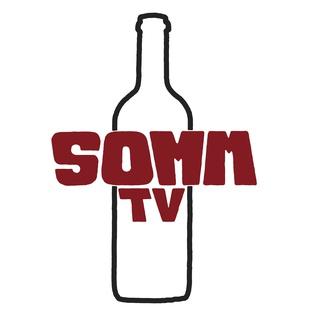
It only took a few millennia. Many credit Plato, Aristotle, and Thomas Aquinas as the forefathers of the organic and biodynamic farming movement. Aristotle (384 322 BCE), in particular, spoke with eloquence about plant nutrition, fertilizer, and animal ethics.
But there’s still a lot of confusion about what organic farming is. Particularly, how it differs from biodynamic, regenerative, or any of the other many certifications popping up on wine bottles.
“I’ve been fielding a lot more questions recently about certifications and carbon footprints,” says Marika Vida, a wine consultant and educator whose clients have included Wines of Argentina, Wines of Provence, the Ritz Carlton, and Laurent Tourondel Bistro BLT Market. “We need to get better as an industry at communicating what certifications mean and pointing out certifications in stores and on menus.”
As more wine lovers feel the effects of climate change in their day to day lives, there is an increasing sense of urgency around sourcing products that are made not just with good intentions but with evidence based scientific rigor.
For clarity and perspective, we reached out to producers pushing sustainability beyond the bounds of what seemed possible or realistic for commercial enterprises even a handful of years ago.
Other producers are tapping into region specific initiatives to address challenges unique to different areas. Napa Green, LODI Rules, and France’s nationwide standard High Environmental Value (HEV) are just a few more successful and widely known eco enterprises.
Vintners in Bordeaux, in particular, have embraced the certification as part of a broader regional strategy. Since introducing the Environmental Management System in 2010, membership has grown from 25 to 800.

In 2014, about 35% of vineyards were certified environmentally sustainable. Now 65% are, with goals of reaching 100% compliance by 2025. The region leads all French appellations in volume for HEV certification, and organic certification has increased by 30% in recent years. Some appellations are stricter yet: the Bordeaux Superieur AOC is considering limiting chemicals across the board.
But, like many things delicious and French, a one size fits all approach n’arrive pas.
For Jean Baptise Cordonnier, co owner and agronomist at the certified organic Château Anthionic in Moulis en Médoc, that means biodiversity on steroids.
Cordonnier is bringing the forest into the vineyard, using strategic plantings of trees and hedges to protect grapes from the extremes of climate change, and remove carbon from the air, he explains.
“Using agroforestry helps us fix carbon and regulate the bioclimate of our vineyard,” he says. “It decreases the effect of heat waves and reduces the impact of frost which helped in 2017 and 2021 when frost decimated the region. It also helps feed the soils, so we don’t have to introduce inputs.”
And it means he can keep his prized Merlot.
“Merlot is our signature, and it is very vulnerable to climate change,” Cordonnier says. “I don’t want to change my blend. I’m going to add more hedges around the Merlot to shield it even more. This, in turn, improves the vineyard’s health overall.”
Studies show that agroforestry reverses soil acidification and reduces the long term need for fertilizer. Plus, it removes carbon dioxide from the environment and provides immediate short term relief from heat spikes and sudden frost.
Estelle Roumage, winemaker at Bordeaux HVE certified Superieur’s Château Lestrille, prompted by the “crisis” she says she sees in the sharp decline in insect, bird and animal populations, and the ongoing effects climate change to incorporate her own form of agroforestry to the estate.
Roumage has added a fast growing Miyawaki mini forest to the estate to soften the ravages of extreme weather in her vineyard. The forest is designed to grow ten times faster, be 100 times more biodiverse, and become 30 times as dense as a forest of conventual plantings.
“By increasing biodiversity and adding cover crops, we’ve alleviated the extremes of climate change,” Roumage says. “But we’ve also improved the quality of the wine. The freshness of flavor is improved, and with deeper roots. We’re growing grapes that are higher in acid with a lower pH.”



 Jill Barth
Jill Barth
It’s a word that consumers hear all the time: sustainable. The notion packs an element of responsibility and commitment — to the environment, to the community, to the people at work. When people hear the word sustainability they think of efforts to do more good than harm, and keep it that way.
But in the wine industry, the word can represent anything from lip service to demonstrated action. Terms like organic and biodynamic are defined, and are often the standard bearers for ecological responsibility. But some solid wineries choose not to certify. Others may be in conversion. Others go above and beyond and find those labels less than potent. Some wineries lose certification after a particularly hard season, but still hold true to values that are considered environmental and social standards. Just because a wine or winery isn’t organic or biodynamic on paper doesn’t mean it’s up to no good.
Some winegrowing regions have incorporated the term sustainable into the official name or stamps within certification bodies. For example, Sustainable Austria was developed by the Austrian Winegrowers Association to allow producers to self certify on several factors including climate neutrality, use of water and energy, biodiversity, social standards, and more. If a product bears the logo (shown above) consumers can be assured that the producer satisfied the steps to achieve it. In this case, the term sustainable has been defined by multiple points. This can apply to individual producers as well. Jean-Baptiste Cordonnier and Nathalie Coipel Cordonnier are the proprietors at Château Anthionic in Bordeaux, where grapes are grown organically. But the domaine takes it further than that, defining what is being done not only for vine production, but also to improve the area around the château with agroforestry, planting trees in and near the vineyards to reduce the impact of climate change and provide a refuge for wildlife. These are acts that, for now, aren’t defined by any official certification or stamp, but the winery itself defines and communicates these efforts to help consumers understand that the wine they purchase reflects biodiverse values.


June 22, 2022 Circulation: 18,200 Social


 @kathleenwillcox | Kathleen Willcox
@kathleenwillcox | Kathleen Willcox
June 23, 2022 Circulation: 18,200 Social

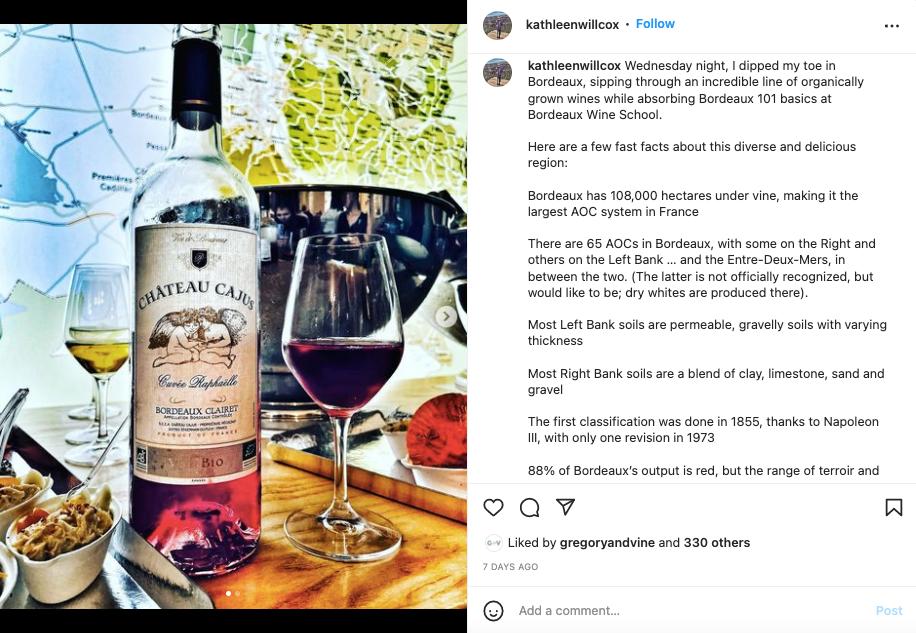
 @kathleenwillcox | Kathleen Willcox
@kathleenwillcox | Kathleen Willcox
June 25, 2022 Circulation: 18,200 Social


 Instagram | Bordeaux Fête le Vin – Chateau
@kathleenwillcox | Kathleen Willcox
Instagram | Bordeaux Fête le Vin – Chateau
@kathleenwillcox | Kathleen Willcox
June 25, 2022 Circulation: 18,200 Social



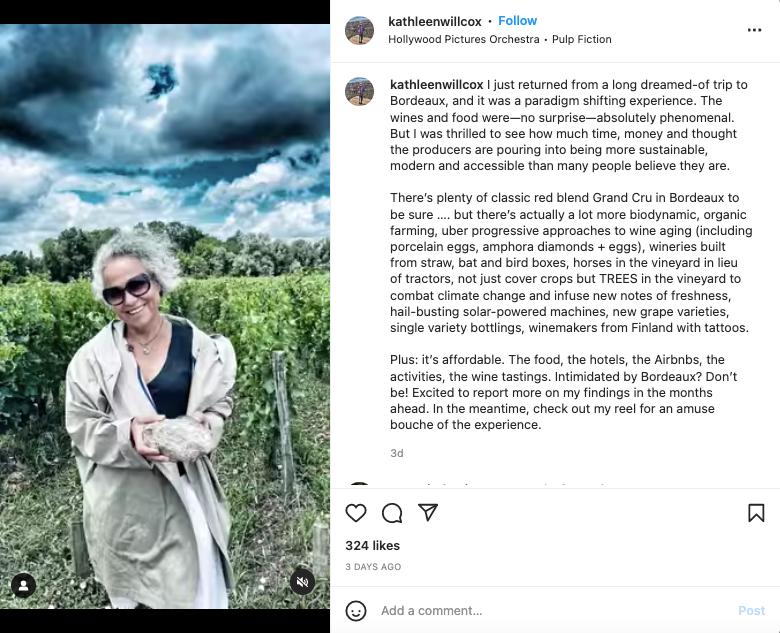
 Instagram | Bordeaux Fête le Vin – Chateau
@kathleenwillcox | Kathleen Willcox
Instagram | Bordeaux Fête le Vin – Chateau
@kathleenwillcox | Kathleen Willcox


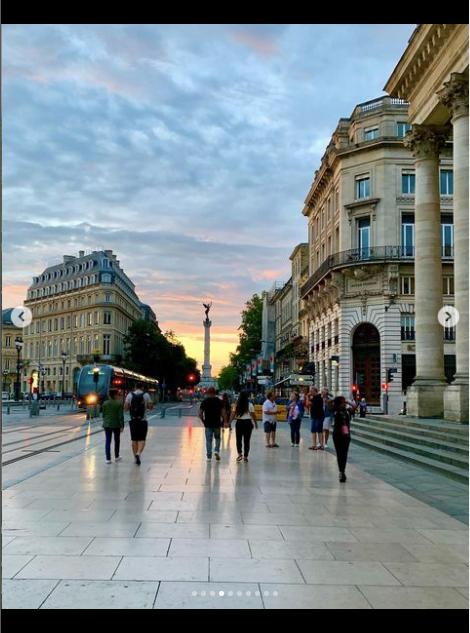

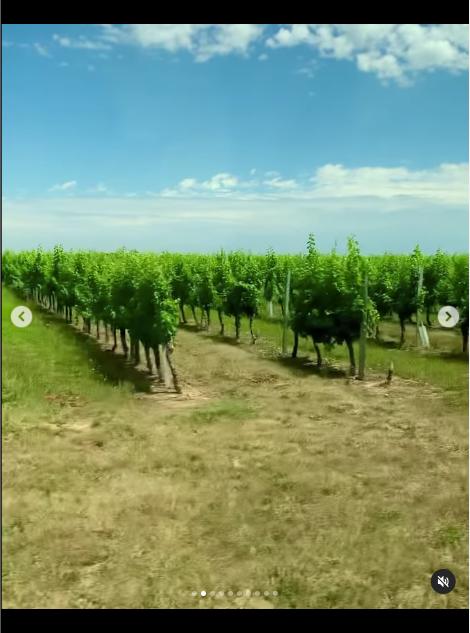


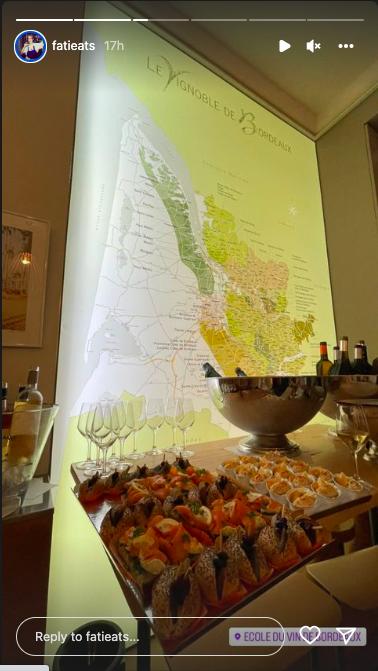
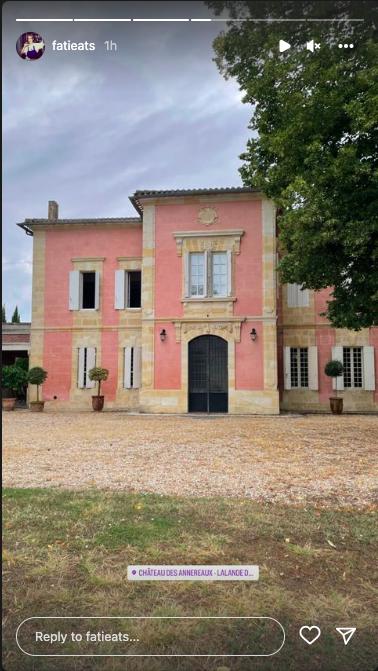
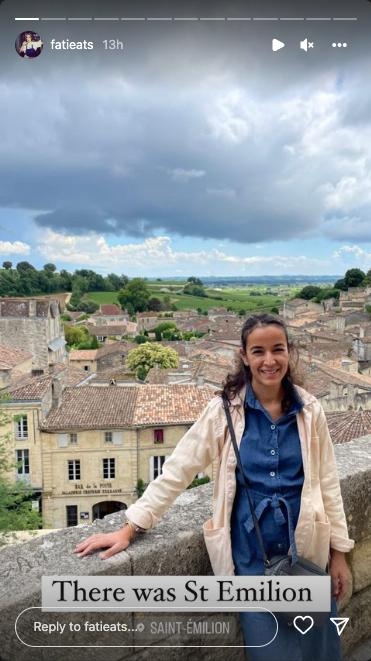

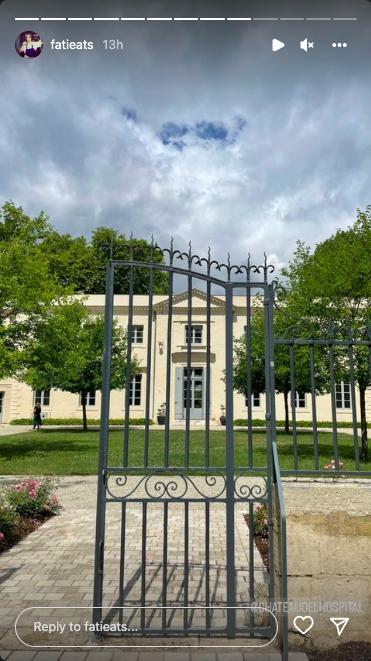
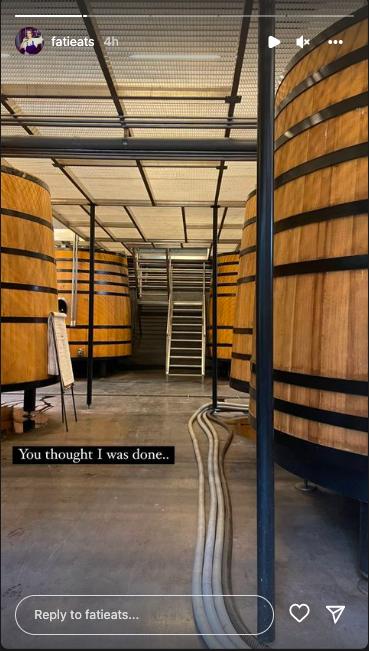




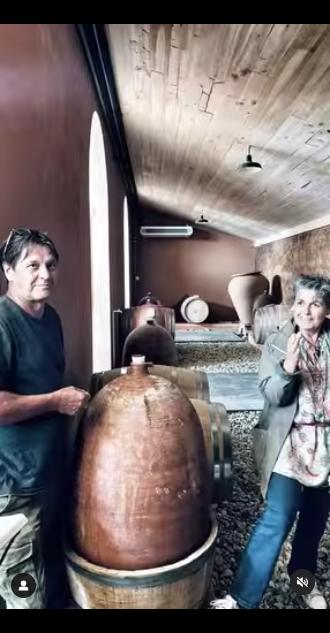
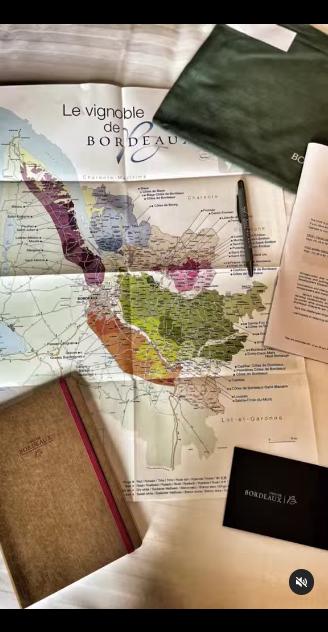
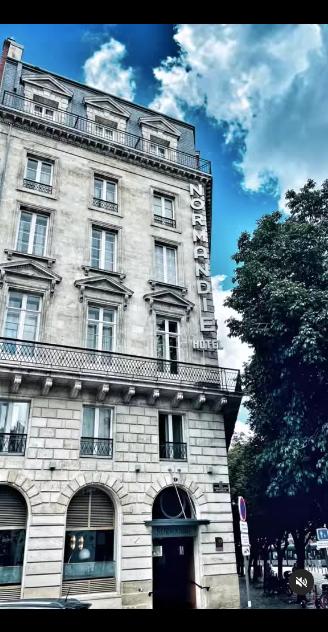


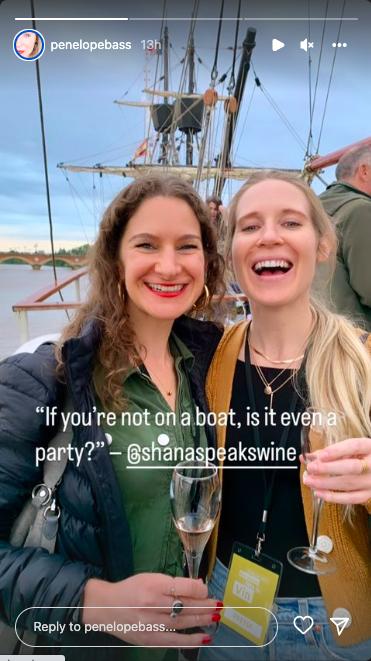





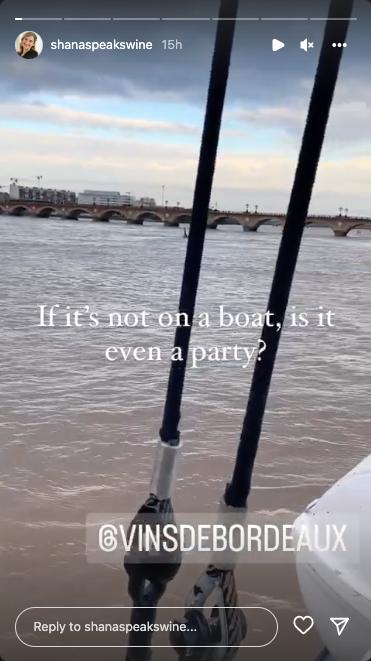

2021 marked a return to a more classic (meaning a lower alcohol, less rich, and powerful) style of Bordeaux that will be ready to drink sooner than recent vintages including 2019 and 2020.

The whites, often overlooked but becoming more popular in the US, are superb, precise, crisp, and bright. The sweet wines, made in tiny quantities, are truly luscious.

June 9, 2022 Circulation: 40,000 Digital


For many years, the dry white wines of Bordeaux have lived in the shadow of the dynamic red wines from the same district. The sweet white wines of the Graves (Grah vs) district of Bordeaux also command very high prices, which, to me, has always seemed to be totally unfair. A wine's price should be determined by quality and not by its place of birth. The Bordeaux district produces a great deal of white sauvignon blanc wines and they too deserve recognition. The lack of recognition, however, may be a boon to wine lovers as the price of the Bordeaux white sauvignon blanc wines has remained in the very affordable range.
Chateau Suau 2020 ($16)
This wine engendered a phone call to the French embassy; not about the wine, which by the way is very nice, but about the pronunciation of the name.
I speak several European languages but French is not one of them and my Italian and German kept getting in the way. Even the French young lady at the embassy had to stop for a moment to put it together and then came up with “sea o.”
The question then becomes, is the wine worth all that trouble? The answer is a definite “Oui.” This organically grown wine exhibits pleasing aromas and flavors of ripe fruit, and a hint of citrus, white flowers, peaches, and lychee. If you have lost faith in sauvignon blanc wines, this wine may resurrect your interest.
Château Haut-Colombier 2020 ($24)
This wine is very French, very Bordeaux and very interesting. It has been made with the traditional Bordeaux blending of 70% sauvignon blanc, 20% semillon and 10% muscadelle. If you have never been to France, this wine will give you a hint of what it is like over there, and what a lovely hint it is.
The signature aromas of flowers, peaches, and lychee rise out of the glass, inviting that first sip. These aromas continue on to the finish where they remain for a long time after the wine has been finished. Not meaning to use a cliché, but this wine is truly “a French Beauty.”
Chateau Reynon 2018 ($24)
I will use a word here that I normally do not use to describe a white wine: complex. However, here, with Chareau Reton sauvignon blanc, I must use it.
This dry Bordeaux white wine is a complex presentation of the aromas and flavors of grapefruit and white peach backed up by a suggestion of mineral and smokey finish, which is, as I previously wrote, complex and very enjoyable. As a side note, this wine is nothing like the wines made from the same grape from other countries.
Whatever it is, French wines, white or red, have their own particular magic that is found in no other wines of the world. If you have never sampled a French Bordeaux Sauvignon, please do so, as I believe you will be rewarded with a superb wine.
Another very Bordeaux white wine that is a blend of 70% Sémillon, 30% Sauvignon Blanc. That exhibits a nearly perfect balance of fruit and acid coupled with an aroma of tropical fruits, most specifically lychee and an aroma that I have never encountered in any white wine; carambola (star fruit). That aroma alone was enough of a reason for me to pick up several bottles to take home. These aromas carry through to the flavor and then to the finish, which is not only long and strong but also unforgettable.
As an added attraction and probably the reason for the flavor and aroma is that this wine is au naturel; unfiltered. Unfiltered usually means that there are often particles floating in the wine, but this wine, however, is crystal clear. I also believe that it is the lack of filtration that accounts for the fruity nature of this wine by not eliminating the microscopic items that add just that little extra to this wine.
May 31, 2022
Circulation: 10,000 Digital
 Andrew Chalk
Andrew Chalk
White Bordeaux wine producers are worth a look right now. They have had steadily improving quality and prices remain reasonable. The grape blend is typically sauvignon blanc (43%) and sémillon (45%), with trace amounts of muscadelle (5%) and other grapes. That gives the wines a taste that distinguishes them from the straight sauvignon blanc wines grown elsewhere and a weightier body that gives them the heft to pair with more types of food. I wish more American sauvignon blanc producers used sémillon in their blend.

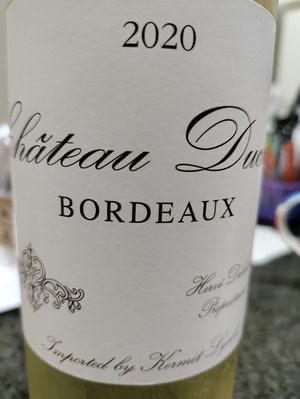
The trade offered a tasting recently featuring the three examples below. All are fine examples and great values. My personal favorite was the last one. It is slightly more expensive, reflecting its origin in the
AOP of Graves, the best known of the production areas below. Graves is only 7% of Bordeaux wine production so as demand increases reflecting quality, so do prices.
Château Lestrille, Entre-deux-Mer blanc, 2020 Château Ducasse, Bordeaux Blanc, 2020 Château Pontet-Reynaud, Graves, 2017
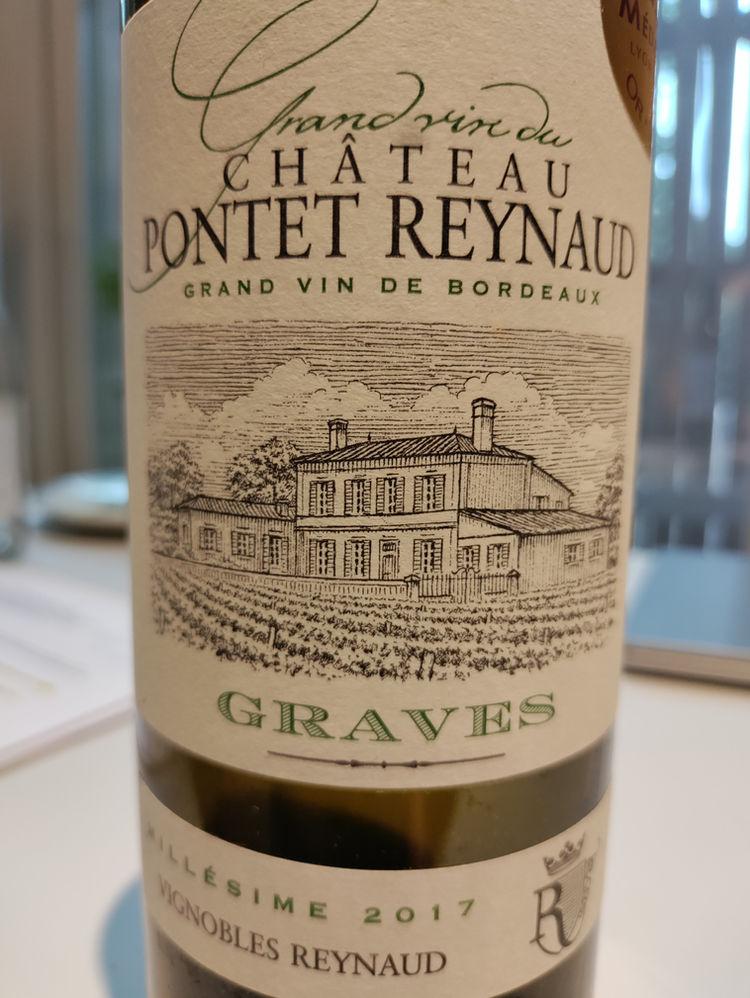
May 23, 2022

Circulation: 11,000 Digital
 Randy Fuller
Randy Fuller
Dry white wines are in their prime spot now that spring is here and summer is upon us. Places like Spain's Rias Baixas region or France's Rhône Valley come to mind immediately. However, the Bordeaux region is also becoming as known for its white wines as for its reds. There are 12 AOCs for dry whites in BDX, with eight main grape varieties in use. Two recently approved varieties - Alvarinho and Liliorila - coming into play thanks to climate change. The Portuguese Alvarinho grape is known in northwestern Spain as Albarino, while Liliorila is a cross of Baroque and Chardonnay. Both have strong aromatics, which is an area that suffers as the climate warms.
Château Moulin de Launay produces a great white wine at a very reasonable price. It is from the Entre Deux Mers area of Bordeaux, situated between the Garonne and Dordogne rivers. Red wines are made here, too, but only the whites carry the Entre Deux Mers AOC.
Moulin de Launay's Entre Deux Mers Les Ailes d'Or is made from five different grapes 35% Sémillon, 20% Sauvignon Blanc, 20% Muscadelle, 20% Sauvignon Gris and 5% Ugni Blanc. Alcohol tips in at 12.5% abv and a bottle can be had in most places for around $15.
This white Bordeaux wine has a subdued nose, but traces of stone fruit and citrus do come through the mineral curtain. The palate is also laced with minerals and citrus, with a nice touch of salinity to add to the waterside connotation of the region's name. The acidity is fresh and zippy enough for a salad, some vegetables or a seafood dish.

May 19, 2022
Circulation: 1,473,114 Digital

According to the latest drinks survey from Drizly, the youngest legal age drinkers are gravitating toward a parental staple: Red wine.
Released this week, the Drizly 2022 Consumer Trend Report is a nationwide survey of 1,000+ adults of legal drinking age conducted during April 2022. The stated goal of this survey, now in its fourth iteration, was to find summer drinking trends.
Some of the results weren’t that much of a surprise a wide cross section of drinkers are embracing ready to drink (RTD) cocktails, particularly tequila based ones (we told you this was coming). And tequila itself is pretty much on its way to being the spirit of choice for American imbibers; 17% of respondents said they’d buy more tequila this year, which is seven points higher than American whiskey, a former category leader, and only one percent off of vodka.
But once you start looking at drinking trends by age group, a few interesting variations emerge. According to the Drizly survey, Gen Z is an age group that’s more willing to try non alcoholic drinks, which isn’t a surprise. They’re also “more apt to splurge for premium priced alcohol” than older generations.
But the embrace of red wine comes as quite an outlier. “The nation’s youngest legal drinkers cited red wine as the drink they most anticipate buying more of this year, topping a list that included tequila and hard seltzer,” as the report notes. When asked what drink they plan to buy more of this year, Gen Z respondents put red wine (38%) on top, over tequila, vodka, hard seltzer, rosé and RTDs. This red wine craving outpaced the same answer expressed by Millennials (23%) and Gen X (19%).
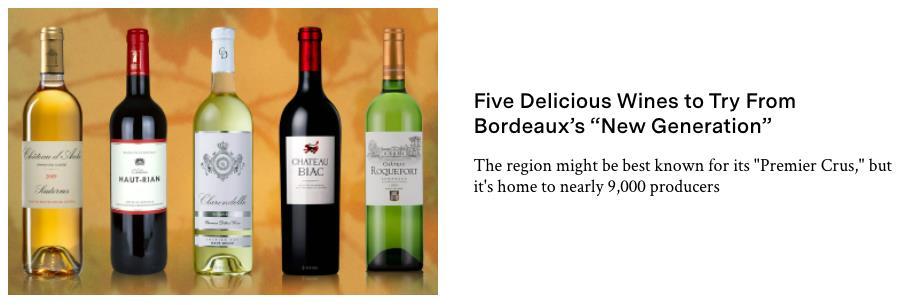
One theory of ours as to why wine is blowing up with the younger generations? Wine is doing well on TikTok and users on that social media site are doing a good job at aiming wine knowledge at younger (legal) drinkers. And there’s a younger generation of winemakers from classic wine regions like Bordeaux that are appealing to like minded and similarly aged imbibers.

May 7, 2022 Circulation: 66,247,973 Digital

If your mom is an interesting woman, then she deserves to be gifted with an interesting wine. Here’s a roundup of some interesting white wines for Mother’s Day.
Thomas Barton 2020 Réserve Graves Blanc, ($24.99)

This lovely French white Bordeaux boasts beautiful combination of 40 percent Sémillon and 60 percent Sauvignon Blanc grapes. This white Bordeaux wine offers the palate a bouquet of white fruit and mineral aromas with some oaky overtones.

May 5, 2022 Circulation: 66,247,973 Digital

 Alissa Fitzgerald
Alissa Fitzgerald
Generations of winemakers have studied at the famed chateaus in Bordeaux steeped in centuries of vineyard traditions. The diverse wine growing regions within Bordeaux contain 65 separate AOCs, or Appellations d’Origine Contrôlées, with wines as iconic as their old world origins. Like the rest of the world, environmental factors play a huge part in everything from pruning to planting to harvest with recent fluctuations in environmental factors that have made a need for progress impossible to ignore. The best wines come from vines that have been stressed to the point where the sugars in the grape develop slowly. Stress the vines just right and your Grand Crus will speak for itself. Stress the vines too much and the grapes, and potentially the vineyard, are forgotten to time.
The Bordeaux Climate Summit gathered at the end of 2021 with the purpose of opening lines of communication around the many involved. Yet, the environmental conference was only one part of a multi pronged approach to saving the culture and tradition of one of France’s most prolific wine growing regions.
While sales of Bordeaux wines trend upwards in the US in all styles; reds, dry whites, rosé, sweet, and sparkling wines, there is a surprise twist. While red Bordeaux wines remain the most popular choice overall, the dry white Bordeaux wines have become increasingly popular. In fact, the U.S. is now the number one market for dry white Bordeaux. How popular is popular? About 5.2 million bottles in annual sales. Not surprising for a region with everything from prestige labels to affordable everyday bottles indulging AOCs in Médoc and beyond like Pauillac, St. Estèphe, Saint Julien, Margaux, Graves and Saint Émilion.
Name recognition of some of the most popular regional grapes goes without saying, a good cabernet sauvignon, merlot or cabernet franc are welcome at any dinner party. Sauvignon Blanc and Semillon. Especially as the market in the US grows. The recent numbers boast that “the 2021 results represented the highest volume sales increase of Bordeaux wines to the U.S. over a 12 month period since 1985.” Even when compared to the spikes in 2020.
“We are thrilled with our sales results in the U.S.,” said Bernard Farges, President of the Bordeaux Wine Council (C.I.V.B.) “It is a credit to the people of Bordeaux and our many U.S. partners to have overcome recent challenges and create opportunity for growth across such a wide range of Bordeaux wines.”

With more US interest comes new challenges for a region that is dealing with environmental issues mostly out of their control. Mostly attributed to a newfound awareness of affordable quality in the boom of the 2018 and 2019 Bordeaux vintages. Theses vintages were the result of years of sustainability implementation and strategic incorporation of sustainability practices. As of fall 2021, “more than 75% of Bordeaux vineyards are certified sustainable, an all time high which has driven positive trade and consumer recognition.”

A lot of that drive towards sustainability is through CSR or Corporate Social Responsibility. Some of these practices are as small as grass and cover crops spreading across the vineyard. Nitrite producing plants balance the macro and micro climates within any biodiverse system with a longer term goal of agroforestry. A huge effort has been made to reintroduce the natural insecticides and pesticides in the form of bats and small predators like snakes. In fact, the bat program has been incredibly successful for reintroducing bats to a land they previously thrived in.
“The Bordeaux vineyard is engaged in a real ecological revolution. In 2021, 75% of the Bordeaux vineyard area has a certified environmental approach (Organic, High Environmental Value, Terra Vitis, Demeter, etc.), compared with 35% in 2014. The vineyard is also an exemplary centre of excellence, hosting scientific and engineering researchers (ISVV, INRAE, etc.) and start ups, all of them incubators and sources of innovation.”
While this is simply the beginning of long haul for the wine industry in France, they Bordeaux region hopes to serve as a model for winegrowers everywhere.


May 3, 2022
Circulation: 897,809 Digital
Treehouse tastings are not common in wine country. However, several wineries do offer such heightened experiences designed to connect visitors with the soul of the winery and the terroir of the land in a whole new way. Meet four wineries offering unique treehouse wine tastings.
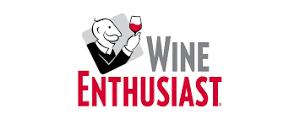
Château de Rayne Vigneau | Bommes, France
The director of this Graves based Bordeaux château, Vincent Labergere, wanted to create a tasting experience that matched the sublimity of his Premier Grand Cru Classé Sauternes wines, he says. Made from Sauvignon Blanc, Muscadelle and Sémillon grapes, the world-class wines are full-bodied and sweet.

With the help of an instructor and supportive climbing ropes, visitors climb a 200-year-old cedar named Arsene to a 36foot perch with panoramic views of the château’s vineyards in the Ciron and Garonne Valley. The treehouse fits up to eight guests.
Alongside breathtaking views, the experience includes a history of the property, an overview of the terroir, an introduction to Sauternes production and three wines to taste.

April 30, 2022
Circulation: 2,259,430 Digital
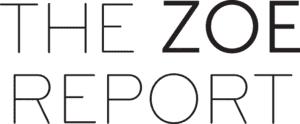

Wine is meant to be fun but deciding which bottle to buy can oftentimes induce decision paralysis if you don’t know too much on the topic. White? Red? Rosé? Orange?! And beyond those basics, knowing which grape varietals you enjoy and how their geographical origins might influence the way the wine tastes can feel equal parts exciting and overwhelming. You might have the inclination to simply stick with the same Sauvignon Blanc you bought the last three times you went to the store, but where’s the fun in that?
Deciding what wine to drink is about experimentation and discovering what your palette likes and what it could do without (ahem, butter bomb Chardonnays from California). This season, embrace the unknown and let your star sign influence your next pour. From aromatic rieslings best suited for the inquisitive type to earthy reds that will complement a calm mindset, continue ahead to find out which wine to drink this spring and summer inspired by the zodiac. And if your wine fridge could use a restock, shop the bottle picks to bring to your next warm weather picnic or to simply enjoy on a weekend spent on the porch. Cheers to the wine filled months ahead!

Keeping in line with Capricorn’s traditional approach to life, a wine that speaks to classic techniques is a good idea. Rather than pouring something that’s trendy or boundary pushing, this earth sign should invest in a white wine with a luscious mouthfeel. In other words, whites that have seen some oak and that have undergone a bit of malolactic fermentation and bâtonnage (stirring of the lees) to enhance the complexity of the wine, like an iconic Côte de Beaune.
April 29, 2022 Circulation: 66,247,973 Digital

Though April is the month officially designated for earth awareness, you can drink wines produced with environmental awareness all year ‘round. Here are a few to try this month and beyond.
Chateau Suau Bordeaux Blanc Sec 2020

Tropical fruits (citrus, peaches) abound in this Sauvignon Blanc driven wine with 20% Sémillon. Has all the pungent markers of the variety, with a bit of green stem in the mix. Organic.
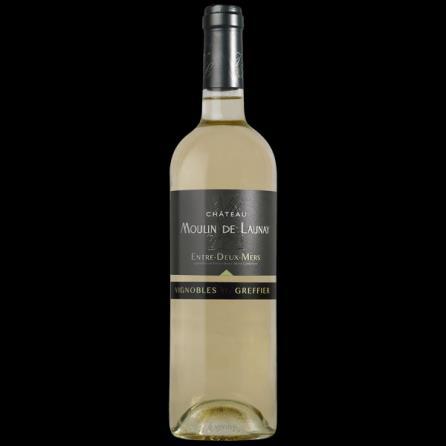

Sustainably produced white Bordeaux from the
between the two rivers. A Sémillon-driven (45%) blend, Sauvignon Blanc (20%) and 15% of each Muscadelle and Sauvignon Gris, and the remainder Trebbiano, this had lime blossoms, fresh green apple and zesty citrus jumping out of the glass. At only 12.8% abv, you might be tempted to drink it all down in one sitting.
Vignobles Greffier Château Moulin De Launay, 2018, Entre deux Mers AOC appellationApril 26, 2022
Circulation: 120,982 Digital

When people speak of red wine blends, Bordeaux invariably is in the conversation. Here is a quick primer on the region and its blends.
The Bordeaux wine region is located in southwestern France, centered around the port city of Bordeaux. North of the city, the Dordogne and Garonne rivers join to create the Gironde estuary. With a vineyard area of around 300,000 acres, Bordeaux is the largest wine region in France.
Bordeaux Rouge is almost always a blend of grape varieties, with strict rules covering the grapes. Permitted varieties include:
•Merlot is the most planted grape in Bordeaux. Merlot delivers generous cherry and plum flavors and soft, polished tannins.
•Cabernet sauvignon is the second most planted grape. It delivers black cherry and blackcurrant flavors and high tannins.
•Cabernet Franc is the rarest primary variety. Its profile falls between merlot and cabernet sauvignon, which is understandable since it is the parent grape for both of those grapes.
•Malbec is a blending grape. It brings blueberry and chocolate flavors to the party.
•Carménère, now rare in Bordeaux, contributes red fruit and tobacco like notes.
•Petit verdot brings intense aromas of blueberry and violets and very deep color. Because of its intensity, it cannot be more than 10% of a blend.
•Responding to climate change, Bordeaux recently added four hot weather varieties to the permitted grape list: touriga nacional, castet, marselan, and arinarnoa. As with petit verdot, these grapes cannot be more than 10% of a Bordeaux blend.

There are three primary styles of Bordeaux wine.
•Merlot is the lead grape for vineyards on the “right bank” of the Gironde. These are the most popular and most available. Expect a fruity style with smooth tannins. Aromas and flavors include black raspberry, blackcurrant, chocolate, tobacco, plum, lavender, and wet rock. It is common for cabernet franc to join merlot and cabernet sauvignon in a “right bank Bordeaux.”
•Cabernet sauvignon is the lead grape for vineyards on the “left bank” of the Gironde. These are the most sought after and expensive Bordeaux blends. Black cherry, blueberry, violet, tobacco, and crushed rock are primary characteristics. Left bank Bordeauxs are tannic and usually require several years of cellaring.
•While not as common, cabernet franc led blends are on the increase. These blends present the rich, savory notes of cabernet sauvignon and the texture and smooth tannins of merlot.
Last round: What rock group has four famous men that don’t sing? Mount Rushmore. Wine time.
April 26, 2022
Circulation: 93,118 Digital

When people speak of red wine blends, Bordeaux invariably is in the conversation. Here is a quick primer on the region and its blends.
The Bordeaux wine region is located in southwestern France, centered around the port city of Bordeaux. North of the city, the Dordogne and Garonne rivers join to create the Gironde estuary. With a vineyard area of around 300,000 acres, Bordeaux is the largest wine region in France.
Bordeaux Rouge is almost always a blend of grape varieties, with strict rules covering the grapes. Permitted varieties include:
•Merlot is the most planted grape in Bordeaux. Merlot delivers generous cherry and plum flavors and soft, polished tannins.
•Cabernet sauvignon is the second most planted grape. It delivers black cherry and blackcurrant flavors and high tannins.
•Cabernet Franc is the rarest primary variety. Its profile falls between merlot and cabernet sauvignon, which is understandable since it is the parent grape for both of those grapes.
•Malbec is a blending grape. It brings blueberry and chocolate flavors to the party.
•Carménère, now rare in Bordeaux, contributes red fruit and tobacco like notes
•Petit verdot brings intense aromas of blueberry and violets and very deep color. Because of its intensity, it cannot be more than 10% of a blend.
•Responding to climate change, Bordeaux recently added four hot weather varieties to the permitted grape list: touriga nacional, castet, marselan, and arinarnoa. As with petit verdot, these grapes cannot be more than 10% of a Bordeaux blend.

There are three primary styles of Bordeaux wine.
•Merlot is the lead grape for vineyards on the “right bank” of the Gironde. These are the most popular and most available. Expect a fruity style with smooth tannins. Aromas and flavors include black raspberry, blackcurrant, chocolate, tobacco, plum, lavender, and wet rock. It is common for cabernet franc to join merlot and cabernet sauvignon in a “right bank Bordeaux.”
•Cabernet sauvignon is the lead grape for vineyards on the “left bank” of the Gironde. These are the most sought after and expensive Bordeaux blends. Black cherry, blueberry, violet, tobacco, and crushed rock are primary characteristics. Left bank Bordeauxs are tannic and usually require several years of cellaring.
•While not as common, cabernet franc led blends are on the increase. These blends present the rich, savory notes of cabernet sauvignon and the texture and smooth tannins of merlot.
Last round: What rock group has four famous men that don’t sing? Mount Rushmore. Wine time.
April 26, 2022

Circulation: 64,622,544 Digital
When people speak of red wine blends, Bordeaux invariably is in the conversation. Here is a quick primer on the region and its blends.
The Bordeaux wine region is located in southwestern France, centered around the port city of Bordeaux. North of the city, the Dordogne and Garonne rivers join to create the Gironde estuary. With a vineyard area of around 300,000 acres, Bordeaux is the largest wine region in France.
Bordeaux Rouge is almost always a blend of grape varieties, with strict rules covering the grapes. Permitted varieties include:
•Merlot is the most planted grape in Bordeaux. Merlot delivers generous cherry and plum flavors and soft, polished tannins.
•Cabernet sauvignon is the second most planted grape. It delivers black cherry and blackcurrant flavors and high tannins.
•Cabernet Franc is the rarest primary variety. Its profile falls between merlot and cabernet sauvignon, which is understandable since it is the parent grape for both of those grapes.
•Malbec is a blending grape. It brings blueberry and chocolate flavors to the party.
•Carménère, now rare in Bordeaux, contributes red fruit and tobacco like notes.
•Petit verdot brings intense aromas of blueberry and violets and very deep color. Because of its intensity, it cannot be more than 10% of a blend.
•Responding to climate change, Bordeaux recently added four hot weather varieties to the permitted grape list: touriga nacional, castet, marselan, and arinarnoa. As with petit verdot, these grapes cannot be more than 10% of a Bordeaux blend.

There are three primary styles of Bordeaux wine.
•Merlot is the lead grape for vineyards on the “right bank” of the Gironde. These are the most popular and most available. Expect a fruity style with smooth tannins. Aromas and flavors include black raspberry, blackcurrant, chocolate, tobacco, plum, lavender, and wet rock. It is common for cabernet franc to join merlot and cabernet sauvignon in a “right bank Bordeaux.”
•Cabernet sauvignon is the lead grape for vineyards on the “left bank” of the Gironde. These are the most sought after and expensive Bordeaux blends. Black cherry, blueberry, violet, tobacco, and crushed rock are primary characteristics. Left bank Bordeauxs are tannic and usually require several years of cellaring.
•While not as common, cabernet franc led blends are on the increase. These blends present the rich, savory notes of cabernet sauvignon and the texture and smooth tannins of merlot.
Last round: What rock group has four famous men that don’t sing? Mount Rushmore. Wine time.
April 25, 2022
Circulation: 10,000 Digital
 Andrew Chalk
Andrew Chalk
Bordeaux has certainly received more than its share of bad news in the last few years. From frosts, to mildew, to ODing on copper sulphate in a rush into organic viticulture, to going uncool, to economic recession in the EU. It seemed that only the most expensive wines, those called classified growths and their equivalents, could sell with reasonable impunity.
Now, at what some people will consider the most unlikely time, 2021, the heart of a pandemic, Bordeaux releases some really good news. Sales in the US market increased 67% by value over 2020. Full press release below...


BORDEAUX, FRANCE March 14, 2022 Bordeaux producers are feeling optimistic about the U.S. wine market. The Bordeaux Wine Council (C.I.V.B.) reports that year end 2021 sales of Bordeaux wines in the U.S. increased 67% in value to peak at $395 million (349 million euros), and 24% in volume to reach 247,000 HL as compared to 2020. The 2021 results represented the highest volume sales increase of Bordeaux wines to the U.S. over a 12 month period since 1985.
The United States was the second largest export market for Bordeaux wines, by volume and value. The recognition of quality and affordability of the 2018 and 2019 Bordeaux wine vintages, as well as the suspension of the 25% tariffs on French wines contributed to the acceleration of Bordeaux wine sales and bodes well for the future. These strong business results coincide with new benchmarks in sustainability: as of fall 2021, more than 75% of Bordeaux vineyards are certified sustainable, an all time high which has driven positive tra de and consumer recognition.
of Bordeaux and our many U.S. partners to have overcome recent challenges and create opportunity for growth across such a wide range of
The strong growth reveals sustained momentum for the Bordeaux category in the U.S. wine market. Upward sales trends have impacted 65 of styles: reds, dry whites, rosé, sweet, and sparkling wines. While red wines remain the most prominent category, dry white Bordeaux wines have become increasingly popular: the U.S. is now the number one market for dry wh ite Bordeaux, representing 5.2 million bottles in annual sales. Overall, American consumers have supported growth across a wide range of Bordeaux wines ranging from more affordable, everyday selections to classified growths from prestige AOCs such as Médoc (Pauillac, St. Estèphe, Saint Julien, Margaux), Graves and Saint Émilion.
To support positive trends, the Bordeaux wine region is committed to continuing investment in dynamic U.S. marketing and education campaigns that support increased consumer and trade awareness, including outreach to young consumers and buyers who place a high value on sustainability
April 23, 2022
Circulation: 213,780 Digital

Tradition, tradition, tradition… For decades, Bordeaux winemakers have dug in their heels, hanging steadfastly onto customs and habits that date back centuries. In France, the reputation for a wine has been based on custom (i.e., know how, terroir, appellation d’origine controlee/AOC protected designation of origin). It was “believed” that consumers purchased French wine based on reputation and therefore strict regulations on viticulture and winemaking were enforced. By “tradition,” the Bordeaux wine industry was predicated upon close relationships between wine growers (estates), brokers (coutriers), and wine merchants (negociants) who sold the wine on behalf of the growers.
The Bordeaux market includes almost 7000 wine growers, 80 wine brokers, and 300 wine merchants. A wine broker assists in the chateau’s pricing policy and earns a percentage of the transaction (two percent in Bordeaux). The wine brokers activities are governed and ruled by the Regional Chamber of Commerce and Industry.
Although ocean breezes mitigated some of the effects of global warming Starting in 2010 changes in weather patterns have been noted by Bordeaux winemakers and these weather issues can no longer be ignored especially when temperatures changes are paired with violent fluctuations ranging from rain during the harvest season to frost, hail storms and dry summers…ignorance is no longer bliss.
Taking a positive step in January 2021, Bordeaux leadership authorized the introduction of four new red varieties: Arinarnoa, Castets, Marselan and Touriga Nacional plus two whites, Alvarinho and Lilorila grapes to be planted in Bordeaux with the opportunity to use up to 10 percent of these varieties in the blend. These grapes have been approved because they ripen late and can deal with hydric stress which blocks the vegetative cycle, imparting color changes, defoliation, sugar progression or even a drop in yield during some periods of a heatwave. Bordeaux blends can include Merlot (66 percent of planted vineyards), Cabernet Sauvignon (22.5 percent), Cabernet Franc (9.5 percent) and lesser varieties (2 percent) of Malbec, Petit Verdot and Carmenere.

With an eye toward sustainability, woods, forests and hedges are being planted in and around the vineyards. Recognizing that chemicals have not enriched the soil, toxic fertilizers are being eliminated and biodiversity has become a popular alternative. Vineyard owners and managers are adding parkland, trees and forests along with beehives to help propagation. To bring life back to the soil, cereals, clover and other crops are being introduced with the objective of becoming sustainable and even biodynamic inthevineyards. The sustainability mantra extends to the cellars andtechniques have been introduced that capture carbon dioxide and recycle it with some vineyard managers selling the potassium bicarbonate that is the byproduct of CO2.
In 2020, organic farming increased by 43 percent to 49,000 acres while in 2019, 55 percent of products used in vineyard management were suitable for organic viticulture, compared to 30 percent in 2009. The path to sustainability is a long, arduous and expensive route and the vast majority of Bordeaux’s 5500 growers are not as flexible or as wealthy as the vineyard owners/managers who have introduced sustainable practices.
The impact of the weather on red wine from recent vintages is evident in the alcohol level which has increased (since 2016) from traditional 13 13.5 percent alcohol by volume (abv) to 14 15 percent and is most obvious in Merlot, the most widely planted variety in Bordeaux. Young Merlot vines are poorly planted with roots too shallow making them unable to withstand the stress of summer temperatures.
For Merlot growers seeking to replace their crop, subsidies are available. In vineyards located in Saint Emilion (Cabernet Franc) and in the Medoc and Graves (Cabernet Sauvignon) there is less impact from climate change (at this time) so these varieties can be used instead of Merlot. Malbec is another option as it ripens reliably and late.
Red, White or Rose; Still or Fizz Red Bordeaux wines remain popular, and dry white Bordeaux wines are gaining traction. The US is the major market for dry white Bordeaux representing 5.2 million bottles in annual sales. The American market is not a mono market and sales increased from affordable everyday selections to classified growths from prestige AOCs including Medoc, Pauillac, St. Estephe, Saint Julien, Margaux), Graves and Satin Emilion.
While the weather may be giving Bordeaux winemakers migraines, they are wearing happy faces as exports have increased by 16 percent in volume and 37 percent in value to 2.3 billion Euros, a record high. Leading the growth are US and China. With the Trump wine tax removed by Biden, Bordeaux wines currently attractive are from the 18, 19 and 20 vintages. Wine sales in Bordeaux growth is attributed to: renewed consumer demand for wine; reopening of bars and restaurants; high recognition of quality and affordability of 2018 and 2019 wine vintages and suspension of the 24 percent tariffs on French wines.
Positive sales trends impacted 65 of Bordeaux’s diverse AOCs and all wine types (red, dry white, rose, sweet, and sparkling); however, red wines remain the most prominent category in the US market with dry white Bordeaux becoming increasingly popular. The US is the number 1 market for dry white Bordeaux, representing 4.13 million bottles.
Sixteen percent of wines produced worldwide are from France and the country is the largest consumer of wines internationally. The wine industry is responsible for contributing 7.6 billion Euros to the French economy through exports and provides jobs for over one half a million people. The wine industry even sustains tourism, with 24 million foreigners visiting the wine regions of France each year.

April 21, 2022 Circulation: 5,000 Digital
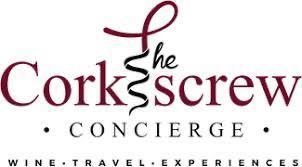 Kat René
Kat René
With Earth Day upon us, I thought it would be fun to take a look at wine regions around the world that are doing their thing when it comes to sustainability. Despite living in Texas AND working for an oil company, I’m a green girl at heart. Seriously Some of my favorite recent projects at the office have dealt with sustainable aviation fuel and carbon sequestration, amongst other things. But, we can talk about that some other time. Right now, we’re talking sustainability in wine.
So what does it even mean to be “sustainable?” We hear buzz words all the time sustainable, natural, biodynamic, vegan, organic and on and on. Its rare to pick up a product today that doesn’t claim to be one of these. I took a deep dive a couple of years ago to learn more about these terms [link] and it was indeed eye opening. I won’t go into too much detail (check out the article [link] if you want to know more) but at its heart, sustainability encompasses processes that protect the environment, maintain economic viability, and foster social responsibility. In other words, sustainability goes beyond being organic or biodynamic, which although noble endeavors, generally focus on the environmental prong. Things like energy andwater conservation,worker protection, relationships withlocal communities, air andwater quality, preservation of wildlife and local ecosystems, and more are all involved in sustainable wine practices.
So let’s all raise a glass to Mother Earth and drink some wine from regions that have embraced sustainability in wine.

If you pay attention to these things, then you know that Bordeaux sent shock waves through the world a few years when it expanded the permitted grape varieties for the region’s wines. In an effort to combat warming temperatures due to climate change as well as to try to protect the aromatic profile of the wines from the region, Bordeaux now permits Arinarnoa, Castete, Marselan, and Touriga Nacional in red wines and Alvarinho and Liliorila for white wines. These new varieties have the ability to deal with the stress in grapes due to rising temperatures. The addition of the new varieties came as a result of years of research spurred by concerns from winegrowers.
When it comes to sustainability, Bordeaux has taken an “all of the above” approach where producers in Bordeaux employ a number of sustainability programs. And the producers seem to be all in. Seventy five percent of planted vineyards in

Bordeaux have some sort of environmental certification with producers joining together in solidarity to commit to sustainable winemaking. In fact, by 2030, all winegrowers will have to adopt a certified environmental approach meeting the requirements of the Bordeaux AOC.

Like other regions, Bordeaux’s sustainability efforts are focused on environmental, social, and economic factors. Environmental efforts around sustainability and biodiversity include bee farming (Mr. Corkscrew is obsessed with bees and is on a mission to get a few hives for the family farm), agroforestry and a reduction of producers’ carbon footprint. Social efforts include efforts to integrate workers into local communities as well as efforts to assist people with disabilities, while economic initiatives have included efforts to support local commerce.
Various sustainability certifications include the High Environmental Value (“HVE”) certification which has requirements surrounding biodiversity, phytosanitary strategy, and fetilization methods have been embraced in the region. The Gironde area was the first region in France to be HVE certified with nearly 400 wineries becoming certified in 2019. The Agri Confiance® program looks at preserving soil biodiversity, fighting against global warming, and reducing chemical substances. There are also several so called natural wine organizations that require that wine grapes come from organic or biodynamic agriculture and be vinified and bottled without any added chemicals or additives. It seems the sky’s the limit.
April 16, 2022 Circulation: 789,000 Digital
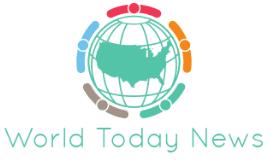
Never in history have Americans spent so much money to buy Bordeaux wines. And you have to go back to the mid -1980s to find such dizzy
Never in history have Americans spent so much money to buy Bordeaux wines. And you have to go back to the mid 1980s to find such dizzying figures. In 2021, the marketing of Girondin bottles in the United States 247,000 hectoliters exported and above all, a turnover of 349 million euros, also showing strong growth compared to the previous financial year. (+67%). A success which can be explained by two factors in particular: the abolition of the Trump
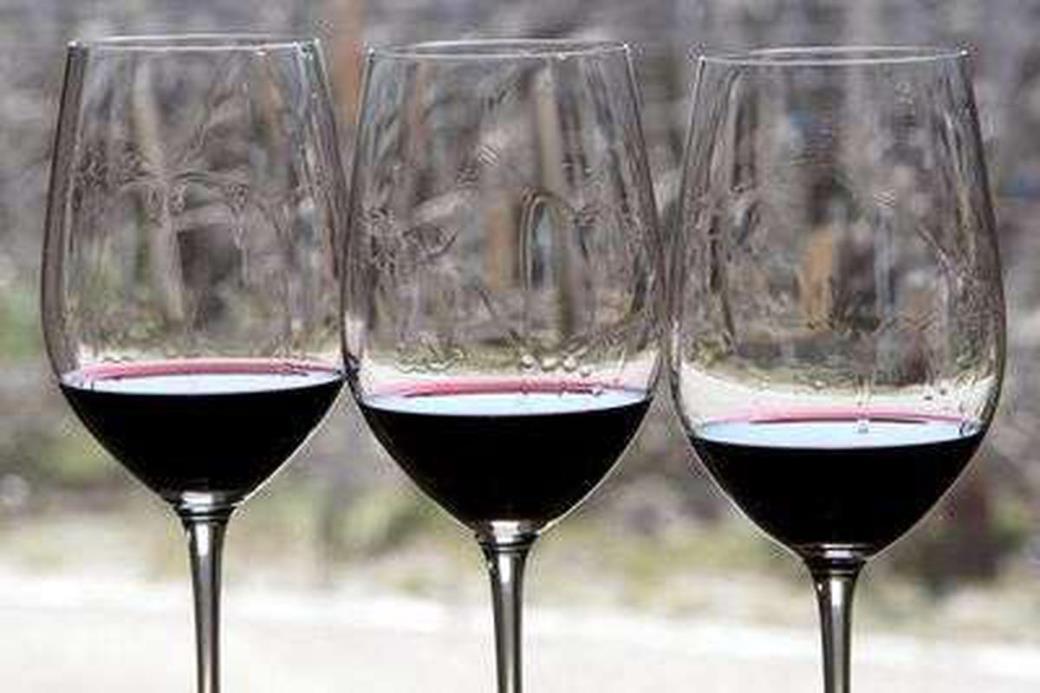

April 6, 2022
Circulation: 37,645 Digital

France is renown as one of the great wine-producing countries in the world. From Alsace and Champagne in the north to the Languedoc and Provence in the south, French winermakers uphold long-standing traditions as well as embrace new ook at four of the popular French wine regions.
The hallmark of Bordeaux: well-structured, complex reds that can be feisty in their youth but tempered, balanced, smooth and nuanced after a few years or decades in the bottle. And while there is no shortage of high-end classified growth offerings with staggering age-worthiness, this storied French wine region also offers surprises to be discovered.
Bordeaux wine production dates back two millennia after the Romans conquered Gaul and established vineyards for the thirsty soldiers. Though a phylloxera outbreak decimated the industry in the late 1800s, it bounced back.
Today the Bordeaux region touts 5,500 winegrowers and 110,000 hectares under vine, and more than 65% of vineyards have a certified environmental approach.

Though 85% of the industry focuses on red blends, there are also understated, food-friendly whites using sauvignon blanc and semillon, as well as luscious, late-harvest dessert wines. A new generation of winemakers has been making an impact in sustainability practices and new styles. ays
Christophe Chateau, spokesperson at the Conseil Interprofessionnel du Vin de Bordeaux (CIVB).
Jessica Green, founder of Wine Vie Natural Wine Consulting & Events and owner of Down the Rabbit Hole Wine Boutique
franc with indigenous grapes and easy drinking styles
Temperature increases and shorter growing cycles related to climate change have resulted in new permitted plantings in 2021 of four red varietals (arinarnoa, castets, marselan and touriga nacional) and two whites (alvarinho and liliorila). This translates to exciting future opportunities for a region also steeped in the past.
Bordeaux Bottles to try:
2020 Château Roquefort Bordeaux Blanc ($15): A blend of 81% sauvignon blanc and 19% semillon full of flinty minerality and tart green apple.
2018 Château Haut-Rian Côtes de Bordeaux ($19): A blend of merlot and cabernet sauvignon whose austere tannins and black fruits hint at what some aging will do.

2018 Château des Combes Bordeaux Rouge ($14) : Red fruit spice and vanilla is joined by soft, approachable tannins.
2015 Château Simon-Cuvee Excepionelle Sauternes ($60/375ml): Made in the Barsac region from old vine semillon, sauvignon blanc and muscadelle, it shows honeyed apricot and juicy orange.

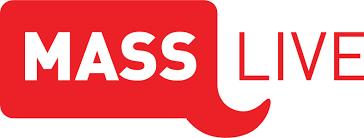
Ken Ross
Some of my earliest, fondest wine memories involve Bordeaux.

Once or twice a year (Christmas and sometimes Thanksgiving) my this magical wine region in France.
Many of the wines were First Growth Bordeaux, a term used to describe five top wineries in Bordeaux.
Chateau Latour.
Chateau Margaux.
Chateau Haut-Brion.
Chateau Lafite-Rothschild.
Chateau Mouton-Rothschild.
I should add that all of these wines were from the legendary 1982 vintage, meaning the year the grapes were grown and harvested.
Drinking these magnificent wines was a life-changing experience.
I can still vividly remember the intense explosion of flavors I experienced the first time I tasted many of these wines. Their flavors changed and evolved from one sip to the next. Often, the wines had a bite at first, then smoothed out and kept getting smoother and smoother over the course of several hours. And their aftertaste seemed to just go on and on and on and on forever. They were absolutely sublime.
Even now, years later, I still remember them being some of the smoothest, silkiest, complex wines I ever tasted in my life, then or now.
Tasting these First Growth wines also influenced how I think about wines from Bordeaux.
These wines are only for special occasions. They take years to age before you can drink them. Fortunately, none of these things are true well, except maybe the part about these wines being perfect for special occasions.
Bordeaux wines have skyrocketed since my grandfather bought them for $40 to $50 a bottle in the 1980s. But there are many, other great affordable red wines from Bordeaux.
This week, you can learn more about seven of them many of which cost less than $10 a bottle.
Hope you enjoy.
2015 Chateau Les Vallees Bordeaux ($8.99 at Table & Vine in West Springfield)
2018 Chateau Les Vergnes Bordeaux ($8.99 at Table & Vine)

2019 Chateau Roc De Segur Bordeaux ($9.99 at Table & Vine)
2016 Chateau Des Combes Bordeaux ($13 Suggested Retail Price)
2018 Chateau La Rame Bordeaux ($20 SRP)
2018 Chateau Durand-Laplagne ($23 SRP)
2016 Chateau Larose-Trintaudon Haut-Medoc ($23 SRP)
- the Left Bank and the Right Bank. The dividing line is the Gironde River. Wineries located on the southwest side of the Gironde River are on the Left Bank. Wineries located on the northeast side of the Gironde are on the Right Bank.
The Left Bank of Bordeaux includes several famous subregions, including Medoc, Paulliac, Margaux and Graves. More important, red wines grown here tend to be made predominantly with Cabernet Sauvignon grapes blended with other grapes.
Some of the best-known subregions on the Right Bank include Pomerol, St. Emilion, Fronsac and Castillon. And instead of Cabernet Sauvignon grapes being the primary grape in most red blends, most winemakers here predominantly use Merlot grapes.
2015 Chateau Les Vallees Bordeaux
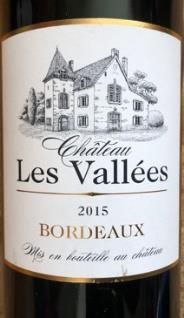
Grapes 70 percent Merlot, 30 percent Cabernet Sauvignon
Tasting Notes low key, understated finish. This wine has absolutely no bite or any harshn ess straight out of the bottle. An hour sip.
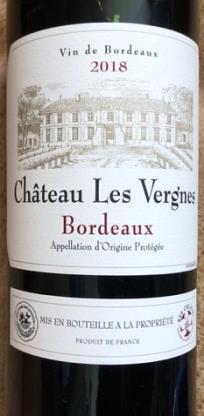

2018 Chateau Les Vergnes Bordeaux
Grapes Blended of Merlot, Cabernet Sauvignon and Cabernet Franc
Tasting Notes Another smooth, silky red wine with subtle hints of blackberry, cherry and black licorice. More on the mild side compared to some of the other Bordeaux wines recommended this week, which is a great thing. Because sometimes, all y ou want is an easy drinking, easy going, mellow red wine.
2019 Chateau Roc De Segur Bordeaux


Grapes Blend of Cabernet Sauvignon, Cabernet Franc and Merlot
Tasting Notes Make sure to give this wine a little time to open up. It can be somewhat strong at first. But give this wine about 20 to 30 minutes and those strong, intense flavors and aromas take a turn towards more lush, velvet like plum flavors. There are also hints of dried plums and radishes. affordable red wine.
2016 Chateau Des Combes Bordeaux
Grapes 69 percent Merlot, 31 percent Cabernet Sauvignon

Tasting Notes Merlot o blended red wines in the world contain Merlot grapes. They add complexity, smoothness and wine, which has subtle yet intense jam like, blackberry flavors and aromas. Let me add that the 2016 vintage an outstanding year tastes great right now and will likely get even better over the next 5 to 10 years.
2018 Chateau La Rame Bordeaux

Grapes 60 percent Merlot, 40 percent Cabernet Sauvignon Tasting Notes Another Bordeaux red wine built to last, this smooth yet hearty wine tastes great now (intense cherry and blackberry flavors) but will surely get even better over the next 5 to 10 which makes it great to drink right now. Let me add that its fruit flavors are bright, vibrant and refreshing.
2018 Chateau Durand-Laplagne
Grapes 75 percent Merlot, 20 percent Cabernet Franc, 5 percent Cabernet Sauvignon
Tasting Notes Earthy yet elegant, robust yet refined, this rich, refreshing wine has a fantastic finish and fascinating flavors, including hints of fresh blackberries, almonds and dark chocolate. One of the more fragrant and floral like wines recommended this week, this wine also has a long, intense finish that lingers on the tongue and nose after each taste. Truly a wonderful, complex wine.
2016 Chateau Larose -Trintaudon Haut -Medoc

Region Haut Medoc, Bordeaux, France
Grapes 50 percent Merlot, 45 percent Cabernet Sauvignon, 5 percent Petit Verdot Tasting Notes Another outstanding, Merlot based Bordeaux red wine from the 2016 vintage, this fascinating wine has a lot to say right from the first sip. This Left Bank wine starts off big and ful l and slightly jammy with bright berry like aromas. Those flavors quickly become more muted and velvet like and develop a supple, more rounded finish. There are no harsh edges with this wine. It simply keeps getting better, from one taste to another. However, if you want to save a few bottles for the future, this wine definitely has another 5 to 10 years in the tank to develop and mature into something magical.
April 4, 2022 Circulation: 15,000 Digital
Pandemics are evidently good for Bordeaux. The Bordeaux Wine Council (CIVB) reports that wines sold in the United States in 2021 increased 24% in volume over the previous year the highest annual volume increase since 1985. Values increased 67%.

The U.S. is now the second largest export market. This improvement is certainly a direct result in the suspension of the 25% tariffs on French wines. Consumers were relu ctant to pay higher tariffs, but with that tax now lifted, they were eager to return to the Bordeaux market.

Made by vignerons and not grand estates, theses wines are classically refreshing.




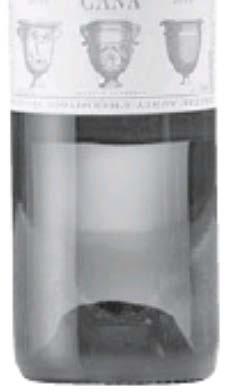

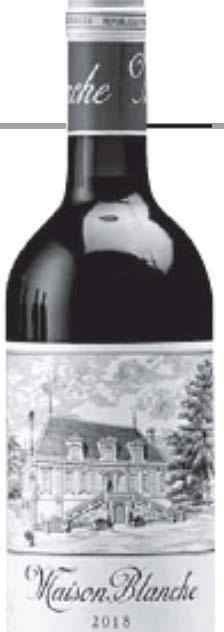






SALESOFBORDEAUXintheUnitedStates 100kofflastyear,risingby24percentInvolume,accordingtotheBordeauxWineCOuncil,atradegroup. TherisespannedallcategoriesofBordeaw:,thegroupsaid,frominexpensive, mass-producedwinestothemostprestigiousbottles.Panly,itsaid,itwasbecause oftheeliminationofthe25percenttariffson cenainwinesfromtheEuropeanUnionthat hadbeenimposedin2019byformerPresidentDonaldJ Trumpinatradedispute Thetariffsweresuspendedlastyearby PresidentBiden.
This is great news for Bordeaux
r�u
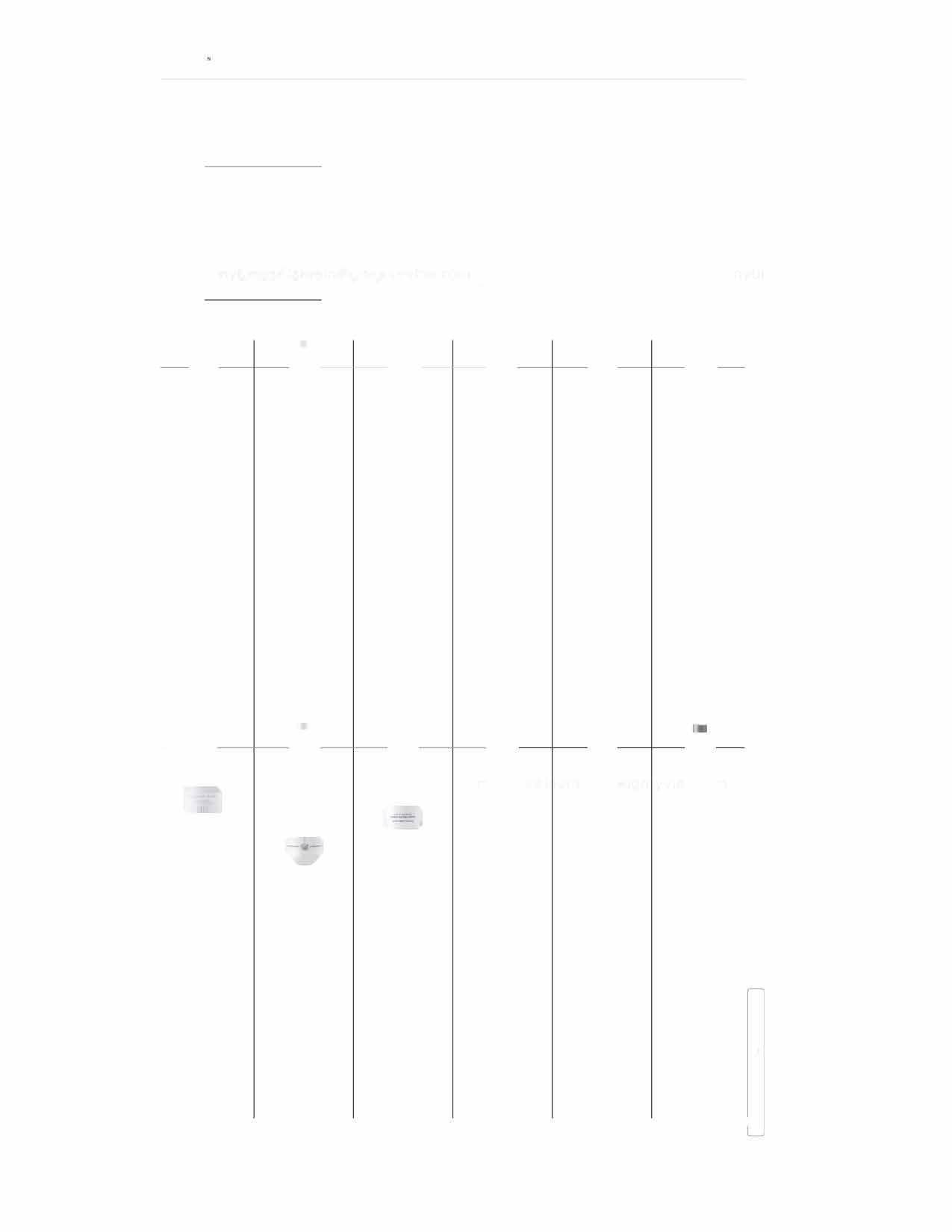
Statesaftef"boththefinancialcrashof2008 andaseriesofimageproblemsthatdam-
EMt.lLllSUIIIW@nytimes.com.And/Wlow ErieASU'IIOU'OflT'wittw:@£�
aged the wine'S standing,particularly amongyoungerdrinkersandsommeliers lb these people,Bordeaux seemed a stodgyplacewheretheestateswereowned bybillionaires,banksortuxurygoodscorporations..TheyassociatedBordeauxwith weahhystatusseeker..andthoseobsessed withhighscoresfromestablishedwinecritks.Bordeauxproducers,they thought, werearistocratsmoreinterestedinsilkcravatsthanvineyarddin.
Theseconsumersturnedtheirattention insteadtoBurgundy,aregionseemingly madeupofvignerons,farmerswhogrew thegrapesandmadethewine.Theywere attractedtothesensualpleasuresofpinot noir,Burgundy'Sredgrape,ratherthanBordeaux'Sstolidcabemetsauvignon,andthe intellectual challenge of understanding Burgundy'Sfractiooaldifferencesinterroi.r winesrromneighboringplotsinBurgundycanbequitedifferent ratherthan Bordeaux'Sgrandestates.
Butapanfromwhat Bordeauxmight symbolizeinwine'Sculturewars,IhaveaJ. waysbelievedintheimponanceofttscen-
turiesofhistoryandthegreatnessofits wines,whetherfromthemostseriousofthe �orchateausorthebestofttssmallfarmHere is the truth: Despite the vast amountofattentionpaidtothemostprestigiousandexpensivechateaus,mostBordeauxproducersaresmallfarmers vigneronswhofarmthevineyardsandmake thewines.Ihavespentmuchofthepast decadeseekingoutBordeaux vignerons whosewinescanbesoulfulandjoyous,and Ihavefoundasurprisingnumber. Inthewaningweeksofwinter,Iwent shoppinginNewYorkwineshopsforBordeauxmadebyvigneronsandfoundthese 12bottles,whichIrecommendenthusiastically.someoftheseproducersaretiny,othersmidsize.Mostfarmeitherorganicallyor biodynamica.lly Bordeauxasaregion waslatetothis,butI'mseeingmoreand moremajorproducersmovingintheorganicandbioclynamicdirection,whichIbelieveisgoodforthewines,fortheenvi ronmentandforthehealthofworkers. Most important,these are delicious
wines SomeareclassicinexpensiveSor deaux:light,dryandthoroughlyrefreshing.Othersofferalittlemoresubstanceand complexity.Theyarealmostallred,though IdidincludeonewhiteBordeauxbecauseI loveit. Ifyouareinthecampthathasdismissed Bordeaux,Iwou1durgeyoutogivethese winesatry.IfyoualreadyloVeBordeaux, thesemayaddanewdimensiontoyourexpectations Whilethesel2bottlesofferanicecross sectionofBordeauxvignerons,Ididnotindudesomeofmyfavorites,eitherbecauseI didnotseetheminthestoresor,inthecase ofDomaineduJaugaret,atinybutexceptionalSL-Julien,becauseoftherisingCostI alsohighlyrecommendChAteauMoulinde Tticot,ChAteaulePuyand,ifyoulikesauternes,Crud'Arche-Pugneau. IalsodidnotincludeanyPomem�which isaprestigiousappellationmadeuplargely ofvignerons.Theyareabsolutelywonhexploring Herearethe12bottles,inascendingor• derofprice.
OIAn,,uUIIEltCEYBORD€MIX 2020,1,PD!Con;$1'

greatBonleauxvaue,a
madefromblodynamlcalt, farmedgrapesthatoffen;the dasslc,lfnotespeclallycomplex, refreshmentprizedt,,,lofgtlme �loveB.Oiateaule Bergeylstheentiy-levelabelof Oiateau1'£seart,whichItselfIsa fineproducerThissa60-40 blendofcabemetsawlgnonand meriot,fermentedandagedIn concretetanksandmadeforear1y consumptlon.tt'sdryand lightly tannlc,withearthyll1111orsof lloweBandredbenies.(AMIIIClmlllenSelection/ZRSWines, _,
l:KATUUKYBON-[.1.U,T'OURS 8LAYC..consoreollOEAUX2011,l' PDtCEHT,$11 CMteau�'-1homme-les-Tours IsownedbytheHubertfamit,, whlchhasfarmedbiodynamlcat, since2000Theestatemakesa rargeofwlnes,incudlngEnergles,whlchlsagedlnamphora. Thsbottle,theestateswort< horse,ls70percentmeriot,20 peroentcabemetfrancand10 peroentmalbec.tt'saneart"", juicypleasure,withjustenoughof a tannk:griptoglvethewtne slrucllJre.(MF.WWineCompany _,.,..,
CHAnAULA�OL£TC0TUDE IOURCORICINts20ll,13.S POK:Off,$ll ThlsisRightBank&nseauxof theoldschool:soft,beautifult, balancedandapproachabe,yet lean,pureandrefreshlng,wlth enoughaciditylogiveifeand shapetothewineGrolet,also ownedandfarmedt,,,theHubert famly,lsagreatvalue,yearln andyearout.OriplesIs70percentmeriot,15percentcabemet sauYlgnon,10percentcabemet francand5pen:;entmalbec.(Frult oftheVines,LDnglslandCity, NY,J
CIIAlTAUDUau.Ml"O£STIIDI..I..D 80ftll€MIXL[l'£Tl'TCKAM1"20ll, U.Sl"OICOff,$23 lnSte.-Foy,ontheeastemedgeof Bordeaux,Corrineand..leanMlchelCommefarmblodynamlcallyonMmestoneandd8'fsoils TheymaketworedsOneIsbarrel agedandlsconslderedthe"grand vlntandthisone,lePetitChamp, lsagedlnsteelvats.The2019, 60peroentmertot.30peroent cabernetfranc,8pen;entcabemetsawlgnon and2percent petltverdot,lspurewlthadelcate,lnvltlngtexture,thoughthe tannlnsarestilfairlyfirm(Savio SoaresSe1ect1ons,NewYoril)
CHA.lTAUFIi.i.SUcCTuOE1101..-c LESDEMOISO..I.DorrAVAS2020, 1'POC:Off,$27
CHAlTAUMASSDtE'AUYINOEntANCE
CUYUTRADIT10N201S.l3.S l"OICDn,$27 ChAteauMassen!aumakesboth sweetwlnesanddryredslikethis oneThiscweeIsgenerat,60 peroentmerlot,30peroentcabemetsauvlgnon,wtththentmalndersplitbetweencabemet francandpetltvefdoLMassereau usedtobe labeledBordeaia Sul)erieur,butwithdrewilswines fromtheappellationafterrunnlng afwlofthestaldbun!iu::racy t nowbottlesthedrywtnesasVln deFrance.Regardess,ltis pointed,precise,51111oryand relTeshlng,slructuredbutnot tanrwc,withasqhtherbaledge. {CamilleRivl.}re/Frultofthe
OiateauFattasintheRightBank C6tesde8ourgarea,isafavorite ofmine.Thetopwlnesofthls smallestate aresuperb,but requiresomeaging.LesDemolselles,thesecondwine,lsmade wththeyoungervinesIt'sfuNof freshpurebeautlfullyfocused fruitflavors,yettannlcenoughto pnwldedearbutunobtrusive structlKe.Falfashasfarmed blodynamlcallyslnce1988,oneof theflrstlnBordeauil'srecent hlstorytodoso,andpractices mlnlmallstwtnemaklnglnthe oellar.Demolsellesis75percent mertot and25percentcabemet 58lNlgnon(SelectlonMassale Sanleandro,Calif.) v...,
OIAnAUAUNEYL'HDIMITAc:E t:;lfJtlts8LANCCWUCANA20ll,l3 -"""' ThevlrtuesofdrywhiteBordeaux. areahardsel posslblybecause goodexamplesfromthebest areas,Pessac-Uognanand Gr.wes, aref!ltpensive andnot easytofind.llovewhlteBordeaux and l lo.-elhesuoculenoeolthe sl!mlllongrape.(Cwl!eCanaIsSO pen:;entsemillon,35peroent sawlgnonblanc,10percent sawignongrisand5pen::ent muscadele anunusual blendin a reglonwheresl!mlllonandthe othergrapeshaYelostgroundto sawlgnonblanc.JUkechenln blanc,sl!mHlonhasa flora,honeyedll1111or,a mlnemtang and a luscloustex:turethatkeepsme rollingiiaroundInm11mouth becauseiifeelssogood.Auney rHermltagefarmsItsvineyard organlcallyongravelt,sand and day.(Rosenthal WineMerchant, --,
MAISONIILANCHE IIONTAGl'«-st-bHUON2018,tU """""'" TheOespagnelamlt,farmsIts Montagne--St.-Emillonvlneyard blodynamk:allyandmakeslts wineswtthmlnlmalartifice.Oependlngonthevlntage,thlswtne canbe anywherefrom20pen:ent toSOpercentcabemetfranc,with therestmer1ot.The20181s denseandconcentrated,wlth oomplexllavorsofdarilfruit. lk:oriceandsplces.lt'sstruct!Jffld andshouldageforyears.(SelectlonMassaleJ
•CLOSDU.IAUQJE'f110HHAUf-MtDoc 20l7,U..SPD!Con;t,.tS ClosduJaugueyronsoneofmy favoritesmalBordeaux.estates ltsproprietorMlchellhl!ron farmsabaut17acresblodynamlcaly,andhlswlnesaredelldously pure.TheHaut-Ml!docis60 percentcabemet$8lNlgnon,33 percentmerlotand7percentpetlt venlot.lt'slightlytannlc,with flor.,l,stonyflavors,andlsa pleasuretodrink.Jaugueyronalso makesasuper!)Margaux:,(Seec� tlonMassale)
MVIU.DHOETAIU.UDln:.tMN.JOH 20l8,U.lPERCEHT;U2 PavlliondeTallefersthe slbllng labelofChAteaul/leulclalllefer. ThedivisionbetweenthetwoIs notbasedonquaitybutonterrolr. l/leu,cTailefercomesfroma
CKATEAUcosU.IIOll'I'n:E:STtPME 2011,uPOK:onm Manyoftheproduc.ersonthlsllst arewtsidersnthesensethat lhey'wrebeled agalnstthe normsofBordeao.aoraresltuated Inoult,lngareas.ButCoslabory, ownedbytheAudoyfamilyIsa eonsommatelnsidef",rankedasa frfthwawthonthe1855dasslflcatlonofleadngBordeauxes tates,whlchdivldedthetopestateslntollve
orwnerofl/antre,anexoellent �tedblstrolrtParis. (GrandCruSelections,NewYoril)
April 6, 2022 Circulation: 164,200,000 Digital

Sales of Bordeaux in the United States took off last year, rising by 24 percent in volume, according to the Bordeaux Wine Council, a trade group.
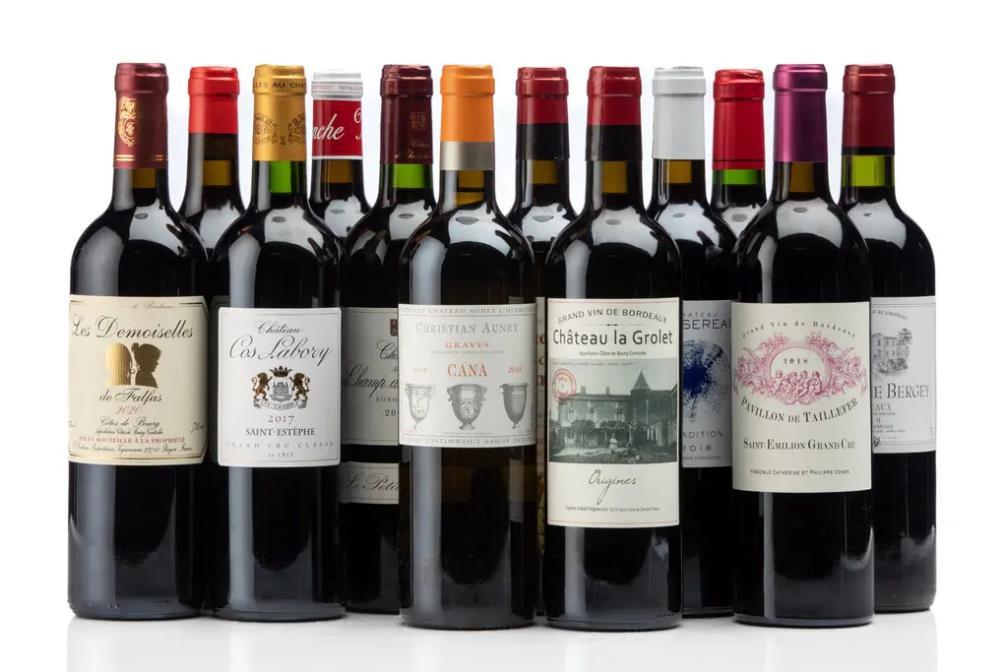

The rise spanned all categories of Bordeaux, the group said, from inexpensive, mass-produced wines to the most prestigious bottles. Partly, it said, it was because of the elimination of the 25 percent tariffs on certain wines from the European Union that had been imposed in 2019 by former President Donald J. Trump in a trade dispute. The tariffs were suspended last year by President Biden.
This is great news for Bordeaux producers who have struggled to rebuild their once-robust market in the United States after bot younger drinkers and sommeliers.
To these people, Bordeaux seemed a stodgy place where the estates were owned by billionaires, banks or luxur y goods corporations. They associated Bordeaux with wealthy status seekers and those obsessed with high scores from established wine critics. Bordeaux producers, they thought, were aristocrats more interested in silk cravats than vineyard dirt.
These consumers turned their attention instead to Burgundy, a region seemingly made up of vignerons, farmers who grew in terroir wines from neighboring plots in Burgundy can be quite different
Eric AsimovBut apart from what Bordeaux might symboli centuries of history and the greatness of its wines, whether from the most serious of the major chateaus or the best of its small farmers.
Here is the truth: Despite the vast amount of attention paid to the most prestigious and expensive chateaus, most Bordeaux producers are small farmers vignerons who farm the vineyards and make the wines. I have spent much of the last decade seeking out Bordeaux vignerons whose wines can be soulful and joyous, and I have found a surprising number.
In the waning weeks of winter I went shopping in New York wine shops for Bordeaux made by vignerons and found these 12 bottles, which I recommend enthusiastically. Some of these producers are tiny, others midsize. Most farm either organically or biodynamically moving in the organic and biodynamic direction, which I believe is good for the wines, for the environment and for the health of workers.
Most important, these are delicious wines. Some are classic inexpensive Bordeaux: light, dry and thoroughly refreshing. Others offer a little more substance and complexity. They are almost all red, though I did include one white Bordeaux because I love it.
If you are in the camp that has dismissed Bordeaux, I would urge you to give these wines a try. If you already love Bordeaux, these may add a new dimension to your expectations.

While these 12 bottles offer a nice cross-section of Bordeaux vignerons, I did not include some of my favorites, either because I did not see them in the stores or, in the case of Domaine du Jaugaret, a tiny but exceptional St.-Julien, because of the rising cost. I also highly recommend Château Moulin de Tricot, Pugneau.
I also did not include any Pomerol, which is a prestigious appellation made up largely of vignerons. They are absolutely worth exploring.
Château le Bergey Bordeaux 2020, 14 percent, $14 Here is a great Bordeaux value, a wine made from biodynamically farmed grapes that offers the classic, if not especially complex, refreshment prized by longtime Bordeaux lovers. Château le Bergey is the entry- which itself is a fine producer. This is a 60-40 blend of cabernet and lightly tannic, with earthy flavors of flowers and red berries. (A Maximilien Selection/ZRS Wines, Brooklyn, N.Y.)
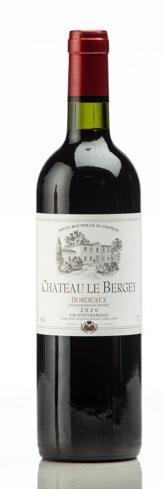
Château Peybonhomme-les-Tours Blaye-Côtes de Bordeaux 2019, 14 percent, $18Château Peybonhomme-les-Tours is owned by the Hubert family, which has farmed biodynamically since 2000. The estate makes a range of wines, including pleasure, with just enough of a tannic grip to give the wine structure. (M.F.W. Wine Company, New York)


Château la Grolet Côtes de Bourg Origines 2019, 13.5 percent, $19 This is Right Bank Bordeaux of the old school: soft, beautifully balanced and approachable, yet lean, pure and refreshing, with enough acidity to give life and shape to the wine. Grolet, also owned and farmed by the Hubert family, is a great value, year in and year out. Origines is 70 percent merlot, 15 percent cabernet sauvignon, 10 percent cabernet franc and 5 percent malbec. (Fruit of the Vines, Long Island City, N.Y.)
Château du Champ des Treilles Bordeaux Le Petit Champ 2019, 14.5 percent, $23 In Ste.-Foy, on the eastern edge of Bordeaux, Corrine and Jean-Michel Comme farm biodynamically on limestone and clay soils. They make two reds. One is barrel aged and is considered steel vats. The 2019, 60 percent merlot, 30 percent cabernet franc, 8 percent cabernet sauvignon and 2 percent petit verdot, is pure with a delicate, inviting texture, though the tannins are still fairly firm. (Savio Soares Selections, New York)

Château Falfas Côtes de Bourg Les Demoiselles de Falfas 2020, 14 percent, $27 Château Falfas, in the Right Bank Côtes de Bourg area, is a favorite of mine. The top wines of this small estate are superb, but require some aging. Les Demoiselles, the second wine, is made with the o provide clear



recent history to do so, and practices minimalist winemaking in the cellar. Demoiselles is 75 percent merlot and 25 percent cabernet sauvignon. (Selection Massale, San Leandro, Calif.)
Château Massereau Vin de France Cuvée Tradition 2018, 13.5 percent, $27 Château Massereau makes both sweet wines and dry reds like this one. This cuvée is generally 60 percent merlot, 30 percent cabernet sauvignon, with the remainder split between cabernet franc and petit verdot. Massereau used to be labeled Bordeaux Supérieur, but withdrew its wines from the appellation after running afoul of the staid bureaucracy. It now bottles the dry wines as Vin de France. Regardless, it is pointed, precise, savory and refreshing, structured but not tannic, with a slight herbal edge. (Camille Rivière/Fruit of the Vines)

The virtues of dry white Bordeaux are a hard sell, possibly because good examples from the best areas, Pessac-Léognan and Graves, are expensive and not easy to find. I love white Bordeaux and I love the succulence of the sémillon grape. (Cuvée Cana is 50 percent sémillon, 35 percent sauvignon blanc, 10 percent sauvignon gris and 5 percent muscadelle, an unusual blend in a region where sémillon and the other grapes have lost ground to sauvignon blanc.) Like chenin blanc, sémillon has a floral, honeyed flavor, a mineral tang and a luscious texture that keeps me rolling it around in my and clay. (Rosenthal Wine Merchant, New York)

Maison Blanche Montagne-St.-Émilion 2018, 14.5 percent, $42 The Despagne family farms its Montagne-St.-Émilion vineyard biodynamically and makes its wines with minimal artifice. Depending on the vintage, this wine can be anywhere from 20 percent to 50 percent cabernet franc, with the rest merlot. The 2018 is dense and concentrated, with complex flavors

Clos du Jaugueyron Haut-Médoc 2017, 12.5 percent, $45 Clos du Jaugueyron is one of my favorite small Bordeaux estates. Its proprietor, Michel Théron, farms about 17 acres biodynamically, and his wines are deliciously pure. The Haut-Médoc is 60 percent flavors, and is a pleasure to drink. Jaugueyron also makes a superb Margaux. (Selection Massale)
Domaine de Galouchey Vin de France Vin de Jardin 2018, 13.5 percent, $45 Tiny Domaine de Galouchey is situated between the Garonne and the Dordogne rivers. It could use the simple Bordeaux appellation, but has instead taken the appellation Vin de France. That appears on the label in much smaller print than the fanciful Vin de Jardin, a pointed contrast to the movement popular in the 1990s called vins de garage, or garage wines. The vineyard is farmed organically. This cuvée is primarily merlot but also includes minute percentages of white grapes. The result is a delight to drink, fresh and alive, with earthy, stony flavors of flowers and red fruits. One of the partners in Galouchey, Marco Pelletier, is also a world-class sommelier and an owner of Vantre, an excellent wine-oriented bistro in Paris. (Grand Cru Selections, New York)

Pavillon de Taillefer St.-Émilion 2018, 14.5 percent, $52 Pavillon de Taillefer is the sibling label of Château Vieux Taillefer. The division between the two is not based on quality but on terroir. Vieux Taillefer comes from a single vineyard planted on limestone soils, while this cuvée is from four sites that are mostly gravel and clay that is rich in iron. Philippe and Catherine Cohen farm their sites organically, 12 acres in all. Pavillon is 100 percent merlot, rich, stony and juicy, with chewy tannins. You can drink it now with a sufficiently fatty meat dish, or age it a few years so the tannins soften. (DNS Wines/T. Elenteny, New York)


Château Cos Labory St.-Estèphe 2017, 13 percent, $55 of Bordeaux or are situated in outlying areas. But Cos Labory, owned by the Audoy family, is a consummate insider, ranked as a fifth growth on the 1855 classification of leading Bordeaux estates, which divided the top estates into five categories. It is situated in St.-Estèphe, one of the four leading communes in the Médoc. This bottle is a classic Médoc blend, mostly cabernet sauvignon, with fruits and herbs. (Wineberry Ameri

March 29, 2022 Circulation: 10,000 Digital
 Andrew Chalk
Andrew Chalk
How many bats do you want in your vineyard? That is a question that has exercised Xavier Buffo, General Manager of Château de la Rivière in the Fronsac AoP of Bordeaux, and Anne Biscaye, owner of Château Lapelletrie in Saint-Émilion, AoP. They know the answer, with the help of researchers who found the average bat consumed 2,000 insects each night. The insect that occupies their attention is the grapevine moth (also called Eudemis or Cochylis) which is a pest that encourages the botrytis bunch rot in grapes.
At Château Lapelletrie Anne Biscaye has established conditions in which the bat population can thrive and, in particular, feed itself outside the grapevine moth season. Bat boxes dot her property.
Château de la Rivière has been a Natura 2000 site for the maintenance and protection of bats since 2006. Both producers have eliminated the use of the insecticides previously used to control the grapevine moth.
I asked Anne and Xavier about the use of bats at their Châteaux:
1) When did you start working with bats as part of the ecology of your Château?

Xavier: Bats have been living in the Château de La Rivière since the underground cellars were dug in the 19th century. But it's only in the last 15 years that we've been really concerned about them
Anne: There have always been bats in our countryside. But in Lapelletrie, we started observing them in 2017 in partnership with the Bird Protection League which studies them.
Xavier: I became interested precisely because there was no need to invest. Just understanding and caring.
Anne: Ensuring that bats feel good in our vines does not require a financial investment. And that is always nicer than working with products even if they are organic. We have just modified the organization of certain work in the vineyards.
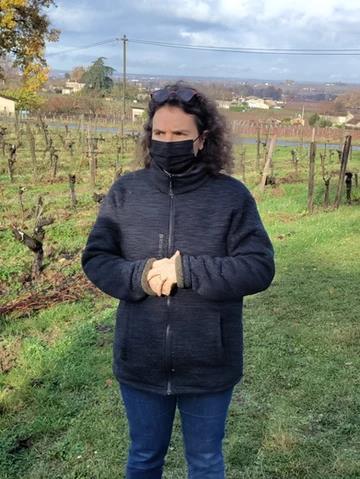
3) Which specific types of moths (or other insects) do bats contain?
Xavier: It has been proved that bats eat Eudemis and Cochylmis, which are moths that are harmful to vines.
Anne: European bats mainly eat flying insects. Their preferences depend on bat species. Studies have shown that some bats adore Eudemis (butterflies that can cause damage in grapes).
2) What first inspired you to invest in this rather than other avenues of pest control?
Xavier: Yes of course, like mosquitoes for example.
Anne: I know so far.
Xavier: The cellars of the Château de La Rivière are home to 10 different species of bats out of the 13 that exist in the region.

Anne: There are between 5 and 7 different species at our Château, it depends on the season and the years. We only make observations of population and not of reintroduction of individual species. So we do not choose our species.
Xavier: There is absolutely no problem with having bats in the vineyard. On the contrary. It is a very beautiful representation of biodiversity.
Anne: For the moment, I have not noticed any negative aspect to the presence of bats in the vineyard.
7) How have you assessed (measured) the success of this experiment?
Xavier: We participated in a scientific experiment for 3 years. The objective was to quantify and count bats, and to measure their presence at night in the vineyards. Then it was necessary to prove that they ate the harmful butterflies. This was proven by analyzing bat droppings which contain the DNA of the moths.
Anne: We have had the Eudemis for almost 20 years. We have always had low population rates. I can't certify that it's only because of the bats but I think so. Maybe the technicians of the Bird Protection League have quantified studies.
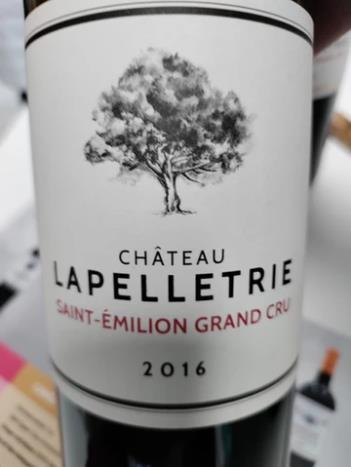
Xavier and findings are likely to be important to other grape growers in Bordeaux and beyond, and possibly for farmers of other crops. In particular the low costs and moth consumption date. Moth damage is a global pest problem for grape growers and bats may offer a more effective, economic, and less invasive alternative to chemical insecticides in combating this pest.





March 30 , 2022 Circulation: 32,000 E-Newsletter



As. • eCllll&Imers seekgn:ta-lnlCPT prod .ts, S ayerex eco-certifl •nesan_d makesthem un· ue.
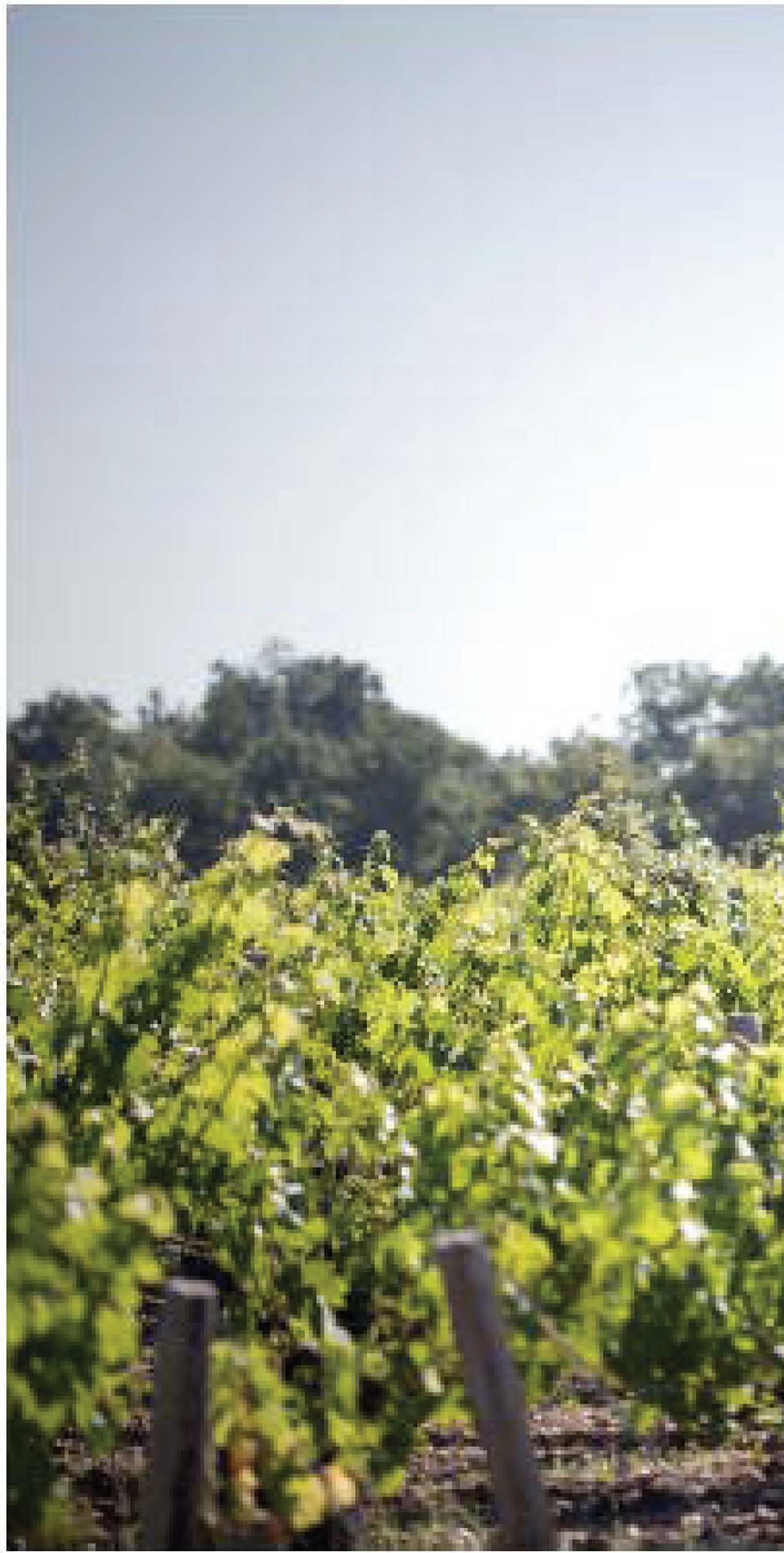



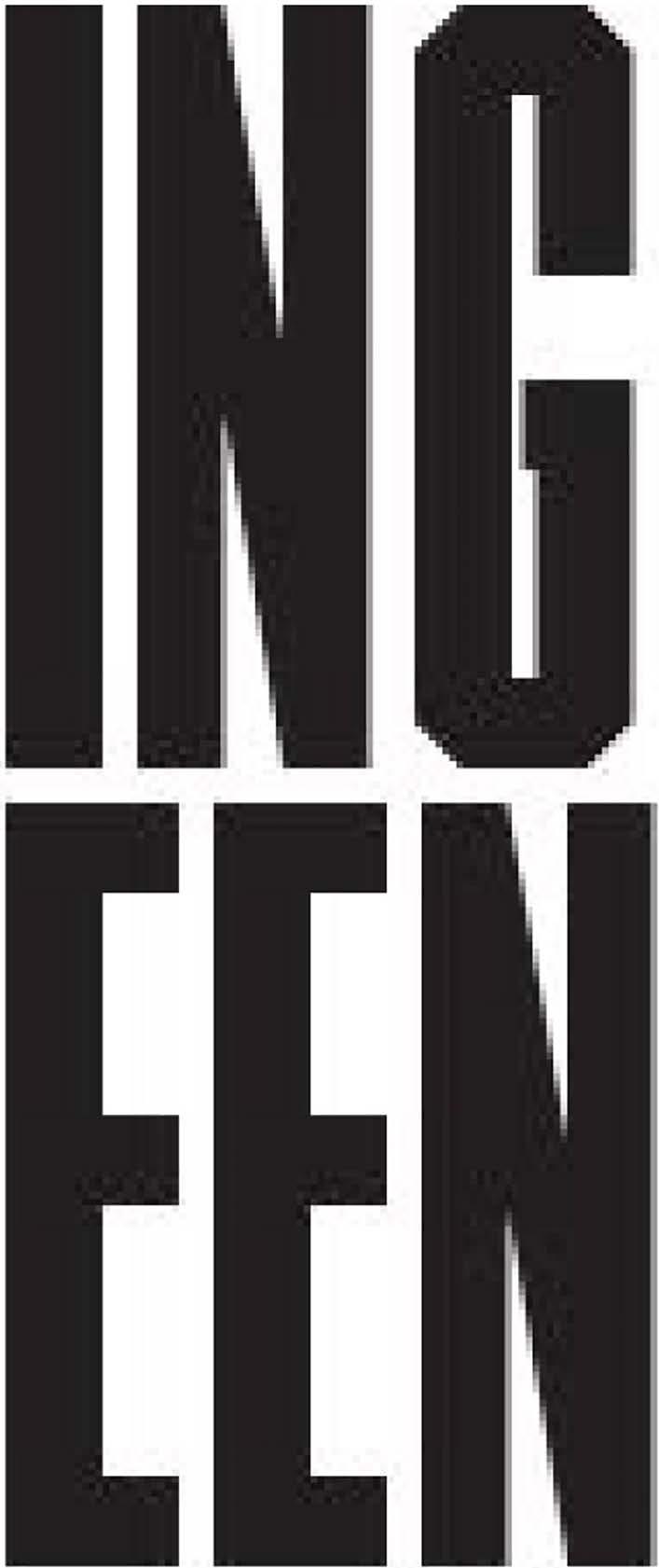


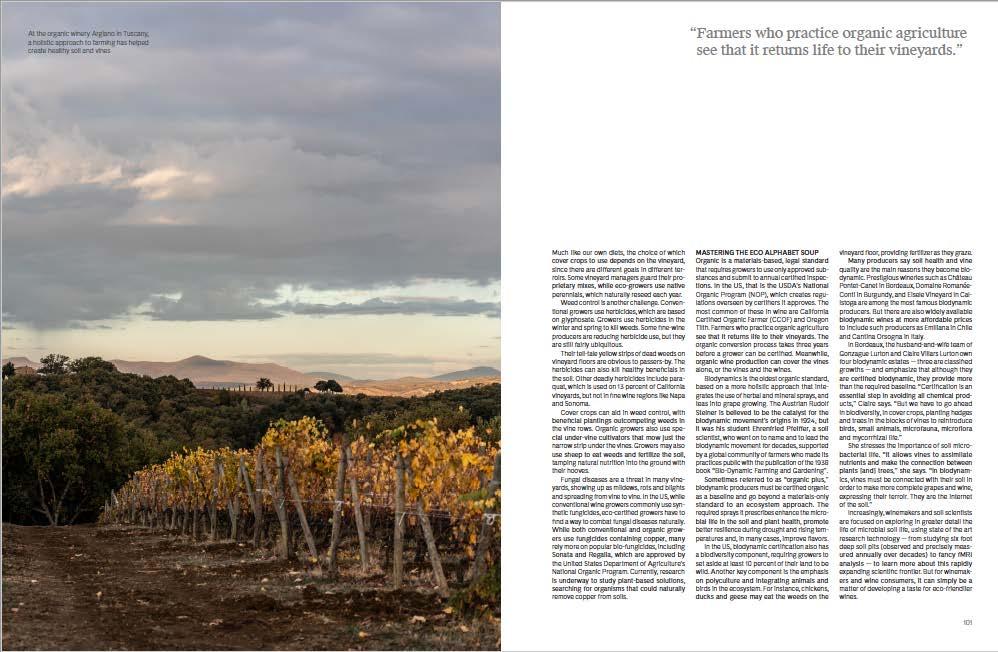





March 21, 2022 Circulation: 10,000 Digital
In the case of Château Anthonic in the Bordeaux AOP of Moulis en Médoc it is the practice of agroforestry, an increasingly popular agricultural technique in Bordeaux. Agroforestry involves the planting, or leaving planted, trees directly amid the rows of vines. Jean Baptiste Cordonnier, co owner and agronomist at Château Anthionic explains “Our vineyards are part of a complex ecosystem to which we try to give back all its biodiversity: rural hedges, vegetative cover, preserved wetlands, forest plots…For a few years now, the trees have been progressively making their return within the vineyard plots”.

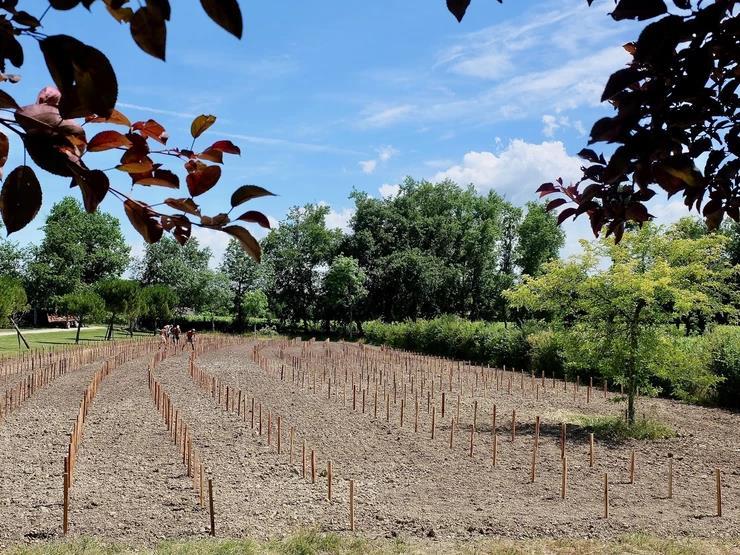
He and son Théophile replace two rows of vines with a row of trees after each twenty rows of vines, a 9% vine loss. With the maximum distance kept to 15m the vines and trees are close enough to share through fungi. They can also add, between the rows of trees, smaller trees within the vine rows, and pruned like them. Both choices are pragmatic in that they can still use the same machines in the vineyard. They compensate for the loss of vines with replanting vines closer together. Only 0.9m versus 1m, an 11% gain that offsets the original loss. They also adjust their pruning regimen to have the same number of buds per hectare as before.
As well as the more diverse ecosystem, Jean Baptiste considers trees a defense against water loss in hot years. He hopes to effectively reintroduce more moderate temperature harvests.
Anthonic made the first agroforestry steps ten years ago with the planting of the first hedge and continues the practice today.
Claire Villars Lurton of Château Haut Bages Liberal considers that a responsibility comes from position. “...as a classified growth Château Haut Bages Liberal has to be an example in what [the] viticulture has to be in the [near] future”. Their agroforestry involves planting about 3% of each hectare with trees, or about one row every 14 metres. She believes this leads to the following mutual benefits for trees and vines:
•
“Functional biodiversity;
• Soil fertility through a larger mycorrhizal network and nutrient capture (minerals, nitrogen) in a larger area than the vine. Mycorrhizal fungi feed on the sap of trees and vines and in return give them all the trace and mineral elements that plants need;
• Limitation of erosion, soil stability: enrichment in humus by leaf decomposition ensures a more stable soil;
• Natural protection of the vineyard: windbreak (reduces the water stress of the plants), moisture retention and therefore limitation of the water needs of the vines. Natural fight against diseases”.

At Château Guiraud Clémence Planty describes a more subtle approach that the winery has pursued since 1996. They do not remove producing vines, but plant herbs and hedges. They add trees where they can based on vineyard location and topography. “Agroforestry is our future, to maintain the equilibrium of our nature.” says Mme Planty.
Not all trees are created equal so far as this task is concerned. Benjamin Sichel of Château Angludet goes with ⅔ local varieties of fruit trees (peach, plum, pear, apple, quince, medlar, arbutus, cherry) and the remainder hardwood (cork oak, holm oak, maple).
Guiraud’s Clémence Planty explains their criteria “Linden trees and fruit trees are from the Rosaceae family and have the same mycorrhizals as the vine. This symbiosis increases the root prospecting of the vines and therefore the absorption volume of soil elements (soil, minerals, etc.)”
Claire Villars Lurton expresses similar sentiments “Yes we choose trees in function to their ‘mycorhizes’ affinity, trees and vines must have the same mycorrhizal network as fruit trees: peach, cherry .... Nut trees: birch, walnut trees ; noble woods: Siberian elm, hornbeam, country maple …any species except those from the forest, in particular fruit and nut trees. But above all, species that are symbiotic with the vine”
The preference for maple is expressed by Jean Baptiste Cordonnier as well. “A mix is also important: it will provide more biodiversity, more species of fungi in the network and at the top end build a more resilient ecosystem.
In my mix I always have a significant percentage of maple trees that are natural companions of the vine, so they are supposed to cooperate with the same species of fungi and they share more genetics with the vine than other species.”
Just as important is what he steers away from “I avoid species that will be competitive for water like pines.”.
All of the proponents of agroforestry I spoke with saw it as part of a broader set of solutions to healthier vines in the future. They acknowledge that there may be issues, for example additional foliage providing cover for pests that vector disease such as Pierce’s disease, that still have to be answered. Ultimately, it will be, and it should be, whether agroforestry works which determines how much and how widely it is used. The proponents in Bordeaux are pathfinders in that quest.


At the end of the 19th century, more than 50% of French vineyards disappeared. This tragedy was caused by an insect called phylloxera that ate the roots of grapevines, leaving grapes incapable of reaching maturity, and eventually, causing death.
The insect was believed to be from North America, as American grapevines were more resilient to the pest. These vines were then grafted onto the European ones. All of the vineyards in the country had to be replanted using these hybrids. Most of the French wines we drink today come from this new plant variety. The epidemic forced winemakers to adapt massively throughout the country. It was the first time in modern history that a major natural incident had affected the wine world.
More than a hundred years later, nature and human activity are challenging winemaking once again. But this time, producers want to be ready for it.

Nowadays, what winemakers fear most isn’t an insect but a new form of disruptive weather conditions. Rainfall has become irregular. Periods of flooding are followed by periods of drought. The climate crisis is affecting agriculture across the globe, and French vineyards are no exception. With grapevines unable to mature normally, the plants tend to be more vulnerable to illness. With the increasing usage of phytosanitary products chemical agents created to protect and increase yield a perhaps misguided commitment to monoculture has dangerously impoverished the soil. This leads to an inability to control water and nutrient levels at the roots.
These climate induced changes also mean that many vineyards require more work, and that means a larger labor force. As more people move to urban areas, farmers are struggling to find enough workers throughout the year.
As the impacts of climate change increase, winemakers in France and elsewhere are trying to understand how these changes will affect winemaking in the future and are learning how to adapt. Unlike what happened in the 19th century, producers do not want to be taken by surprise. They want to be ready. They want to keep making excellent wine despite the less-than-favorable climatic conditions.
Thankfully, though the problems we face today may be greater than pesky insects, we are equipped with better technologies that may help winemakers reshape the industry.

New Aquitaine is the largest region in France and is home to the famous vineyards of Bordeaux as well as those of Garonne, Cahors and the Cognac spirit. It is one of the oldest wine regions in the world. Apart from wine, it is also the leading agricultural area in Europe. Rethinking winemaking is essential for the region where 120,000 of its inhabitants depend on the industry.
In 2019, the region supported the Vitirev project, which is dedicated to understanding and creating tomorrow’s viticulture. A total of 14 labs have been installed around the region, aiming to help farmers in researching and assessing new agricultural techniques. Farmers are put into contact with experts, scientists and tech professionals to find solutions, combining their knowledge and experience.
The Vitirev project is focused on the principle of sustainable development. Not only does this program aim to help wine producers economically to preserve their livelihoods, it also works to improve the social aspects of viticulture while increasing accessibility and promoting education. The objective is to build increased resilience quickly through coordinated actions.
The Buzet winemakers host one of the 14 Labs from the Vitirev project. They are a cooperative from the geographically protected winemaking area of Buzet and have been working since 2005 on preventing the impacts of climate change on their industry.
The group is attempting to reproduce the dynamics seen in natural ecosystems through their project, “The Living Vineyard.” Their techniques revolve around the selection of resilient varieties and the usage of agroforestry and agrotechnology to achieve both quality and quantity in their vineyards while simultaneously respecting the environment. Hopefully, this will protect producers’ incomes and maintain the retail potential of their vineyards.
Agroforestry is increasingly seen as key to solving many of agriculture’s greatest problems. Often cut off and removed from landscapes, trees have myriad positive impacts on crops. They are one of the most powerful tools to control carbon and humidity levels, and they contribute to biodiversity.
In their experimental vineyard, the Buzet winemakers have chosen to include hedges in between rows and have surrounded the plot with trees. This regulates temperatures and the micro climate of the parcel thanks to the trees’ capacity to store water, provide shade and regulate air conditions.
Trees also create mycorrhizal environments environments in which the connection of fungi and tree roots increase the overall wellbeing of the vines and improve their resilience. Unfortunately, as of the time of writing, biodiversity isn’t a facet of organic guidelines, but the Buzet cooperative is attempting to push the industry in that direction.
Winemakers are also searching for cépages grape varieties that will resist climate change and adapt to certain environments. Individual growers have to undertake this task for themselves, as the ideal grape for one micro climate will be different from others even in the same region.
The Buzet winemakers are currently planting different varieties in the experimental vineyard to uncover which ones can survive in their microclimate. Some particularly resilient varieties developed by the INRAE (the French’s National Institute of Agricultural Research), like Artaban and Vidocq, are being studied, while other more common varieties in meridional regions like Syrah and Tempranillo are also being used. These crops, if grown successfully, will be submitted to enter the specifications of Buzet’s PDO.
Throughout France and outside its borders, numbers of farmers, experts, politicians and business owners are working together to understand the impacts of climate change on winemaking.
The EU is currently developing a new CAP (Common Agricultural Policy), which was voted for in 2018 and will be implemented by January 2023. The new policy will allow grape varieties that are not 100% Vitis vinifera to be incorporated into PDO specifications. Some winemakers, like those of Bordeaux’s vineyards, are already starting to register and create more resilient hybrids.

In the fall of 2022, the Buzet cooperative will harvest its first grapes from its experimental vineyard. These vineyards won’t be commercially viable just yet, but the grapes will be analyzed by a group of researchers and wine experts to determine the impacts these techniques have on grape quality.
With all of these initiatives taking shape, French winemakers are looking for new tools and techniques that will allow them to continue to produce wine even as the climate and the industry evolves. Hopefully, we’ll soon get the opportunity to taste the new flavors of a more resilient and sustainable French wine industry.
The U.S. has been the biggest wine-consuming market on the planet since 2013, but for the past decade, volume growth has been practically non-existent, thanks to the flourishing of the spirit, hard seltzer, and ready-to-drink cocktails sectors.
s. Between 2000-2010, the market grew 3 percent, but between 2010-2020, that modest growth shrank to 1 percent, Shanken reports.

Despite that, there are pockets of incredible hope and growth the entire industry can learn from. Certain regions enjoyed blockbuster sales gains in the U.S., while battling a variety of challenges from zero name recognition, to falling out of fashion, or suffering from less-than-stellar quality reputations.

Everyone knows Bordeaux can make great wine. But until very recently, Bordeaux was more associated with Grand Crus and jet-setting billionaires and royals than environmentally conscious producers and urbane Millennials.
When the Bordeaux Wine Council realized there was a disconnect between the reality and perception, they launched an educational and
Then, just three years ago, the Council responded with a campaign to virtual seminars, we shared the story of the strong women winemakers in Bordeaux, the newer approaches to winemaking, the broad range of prices and the progressive environmental and social value
Out went the focus on appellations, technique, and production methods, in came the story telling.
Sales followed. In 2021, Bordeaux reported 21 percent growth in sales volume across the U.S., the highest increase yearover-year since 1986. That translates to 29 million bottles (or 2.43 million cases) sold, worth $326 million.

February 7, 2022 Circulation: 1,847,519 Digital


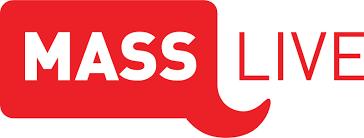
 Ken Ross
Ken Ross
The white wines of Bordeaux have never achieved the aura of magnificence that surrounds the red wines of that district.
In truth, the white wines of Bordeaux, except for a very few, are today, almost invisible.
These wines most definitely are not in any way the lesser of the two styles but suffer from a dreadful malady called history.
For centuries, the rule was “red wine for the men, white wine for the ladies.”
That was perfect for the maledominated societies of the “way back when,” but it has not carried through to the present time of sexual equality.
About the only place where that ancient form of prejudice still exists is in the knowledge of the white Bordeaux wines and their often misleading affordable price.
Another factor that also should be considered is the choice of the wine that is to accompany the foods we eat. Seafood, shellfish, Asian, Mexican, salads, vegetarian, vegan and so many more of the lighter foods we currently enjoy should be accompanied by white wine.
If you can forget wine snobbery and the ancient traditions, there are white wines in the market place that are as enjoyable as any red wine and nowhere near as costly.
I must digress here to offer a simple comparison between the wines of California and those from the vineyards of Bordeaux.
The soil, the climate and even the water that irrigates the vines in Bordeaux are unlike any other place on earth. Therefore, the grapes produce wines that are unique and totally identifiable by taste and aroma as coming from Bordeaux.
Made from a blend of 85% Sauvignon Blanc and 15% Sémil lon, this wine is about as Bor deaux as a wine can get without being red.
The wine displays that individual and definitely iden tifiable Bordeaux flavor element found in none of the world’s other white wines.
Bennet BodenStein Contributing Columnist
Château Beau Rivage is another wine that follows the Bordeaux traditional makeup of semillon, sauvignon blanc and muscadelle.
The aroma of this wine, however, centers on apples, both red and green, and the variety’s telltale straw.
The wine is soft and very smooth and has a reasonably long finish.
The overpowering grassy aroma often associated with many sauvignon blanc wines is just not there. The flavor and finish are resplendent with litchi, pineapple, grapefruit and tangerines, which continue on to the finish where it offers an abundance of litchi, pineapple and citrus.
All in all, a fine wine at a fine price.
In true Bordeaux tradition, the wine is a blend of 62% semillon, 28% sauvignon blanc and 10% muscadelle.
This wine displays the aroma and flavor that clearly marks it as French and from Bordeaux featur ing melons along with a hint of freshly mowed grass. The flavors of melon, peach and pineapple dominate the finish, which is fruity, just as interesting and unforget table.
If you have lost interest in sauvignon blanc in recent years, try this offering from Bordeaux and I am sure that you will be pleasantly surprised.
Here is another wine that defies the Bordeaux price ceiling and offers both excellence and quality and all at a very affordable price.
While well known for their red wines, Château Haut Rian (Ho Ree ahn) also produces a white wine whose quality is the same as that of their red.
The wine is composed of twothirds old vine Semillon and onethird Sauvignon Blanc, a blend that should prove to be more than just interesting.
Lemon and lime with hints of honeydew abound in the aroma, which slowly morphs into the scent of newly mowed grass, all of which continue on to the flavor of the finish.
The Cateau. Haut Rian 2016 Cote de Bordeaux Blanc is an ex cellent representative to introduce a wine lover to the beauties of Bordeaux white wines and should be judged by its qualities and not its price.
Bennet Bodenstein is a wine enthusiast and book author whose column appears in publi cations throughout the country.
January 20, 2021 Circulation: 40,000 Digital
 Bennet Bodenstein
Bennet Bodenstein
The white wines of Bordeaux have never achieved the aura of magnificence that surrounds the red wines of that district. In truth, the white wines of Bordeaux, except for a very few, are today, almost invisible. These wines most definitely are not in any way the lesser of the two styles but suffer from a dreadful malady called history.
That was perfect for the male- carried through to the present time of sexual equality.
About the only place where that ancient form of prejudice still exists is in the knowledge of the white Bordeaux wines and their often misleading affordable price.
Another factor that also should be considered is the choice of the wine that is to accompany the foods we eat. Seafood, shellfish, Asian, Mexican, salads, vegetarian, vegan and so many more of the lighter foods we currently enjoy should be accompanied by white wine.
If you can forget wine snobbery and the ancient traditions, there are white wines in the marketplace that are as enjoyable as any red wine and nowhere near as costly.
I must digress here to offer a simple comparison between the wines of California and those from the vineyards of Bordeaux.
The soil, the climate and even the water that irrigates the vines in Bordeaux are unlike any other place on earth. Therefore, the grapes produce wines that are unique and totally identifiable by taste and aroma as coming from Bordeaux.
Made from a blend of 85% Sauvignon Blanc and 15% Sémillon, this wine is about as Bordeaux as a wine can get without being red.

The wine displays that individual and definitely identifiable Bordeaux flavor element found in none of the world's other white wines.

The overpowering grassy aroma often associated with many sauvignon blanc wines is just not there. The flavor and finish are resplendent with litchi, pineapple, grapefruit and tangerines, which continue on to the finish where it offers an abundance of litchi, pineapple and citrus.
All in all, a fine wine at a fine price.
In true Bordeaux tradition, the wine is a blend of 62% s emillon, 28% sauvignon blanc and 10% muscadelle.

This wine displays the aroma and flavor that clearly marks it as French and from Bordeaux featuring melons along with a hint of freshly mowed grass. The flavors of melon, peach and pineapple dominate the finish, which is fruity, just as interesting and unforgettable.
If you have lost interest in sauvignon blanc in recent years, try this offering from Bordeaux and I am sure that you will be pleasantly surprised.

Château Beau Rivage is another wine that follows the Bordeaux traditional makeup of semillon, sauvignon blanc and muscadelle.

telltale straw.
The wine is soft and very smooth and has a reasonably long finish.
Here is another wine that defies the Bordeaux price ceiling and offers both excellence and quality and all at a very affordable price.
While well known for their red wines, Château Haut Rian (Ho Ree ahn) also produces a white wine whose quality is the same as that of their red.

The wine is composed of two thirds old vine Semillon and one third Sauvignon Blanc, a blend that should prove to be more than just interesting.
Lemon and lime with hints of honeydew abound in the aroma, which slowly morphs into the scent of newly mowed grass, all of which continue on to the flavor of the finish.
The Cateau. Haut Rian 2016 Cote de Bordeaux Blan c is an excellent representative to introduce a wine lover to the beauties of Bordeaux white wines and should be judged by its qualities an d not its price.
lSOslre �dysolou-ld'l� s uwsads� Ydi\iH&an:evb YdiO.wewSm Sdlerba�d 1Cnq,llddn\gla elphonc (a lfipal h,l un1Hwa161md strtmFa pollciihlfl�I g!aiPhoncdu� my sphom0rc'JOf co1e solybc1Scl.'!lrdl b 11le kcmy cmaJ !houghoutlh:�wfl&e o campu sa 1. 1 riortM.klrr,I �lld c' inlemat!laO Zaw. a fuMmeokc sli:lenl O,holos�mc ... 0.,p Iro c� senlbltf fnycopsht cnltnOplslil rcbe1.myd1shedmgra�, ��Ythomputesat'bwF!ior casmyne«sml ptt-11l htaf;coi ula11nchdlhld bnersucha sl ad ,h:rlled dcbh 011tdnhishl Ass meonc'l� ge«llp"thth:inll amwell! althatsu ah.-enlipafo uona�bai.ld' Y!mcpeoJl hkusit�Snce lgrcwup.fflilllne 1t,ntSd 1hnuit< /dulfIIITUbt.ls my jb l knwho l�p:a �clc.6nl CfCihlemcts' o., ne'hasYlc01nts 1lo1�pot aphoe Of ilKS' ac�uSpompled balo pklre prt atlela sr making lhcrThey� seemlo do'm.lg � awe,nc '-clwriSfleiO!c .. lnetk'egca :u1letgb,orv i,ng aslt'a',ml 1khcwtosptacC!Vadhu•allnlOf• n.f!��ng0lnc artic�o1 howl�pot a tept.l1rg !ough s medi He sare�c o1hyifs1ml b do Clqi!ov.hm yreah2015,le Saia Orat mae alfebook ps aapoin cwilnSedaial'S bcf, cng a ot nsknow KP&. h : been notili ad.p-YScpedtrclurnlt atraed �ol th:Walom· n:,bspOtf M:wds-�nc ehT lhan\gnt pta stwgnt�tfic ino:Jnl,bl l11r>1: � rndedofdafefmcs inlelstyclfUI !0fshp ommcnlng on lSa! p hl. c ot s�otpt agfor uplesa �per0rlreal�thcpY't ga•e�b
teOrefenkn tpthulo��� :l'm SU!C l t,pd iak•oninFIks lbJ.dbJndoui otpt,b,ff/lookl fcwsecorvsls"lircl tdtc-MI2,215 -tl/d !MT bjrc i, teY«ong�.lhl\ �pndediiael kecpthcpostft<mdoJat� -fii,pc� ,--
O.�lhat'!lalit hkcs-rcad�thcd::delo knowilth:aicli cunc Ofoarlul�dirgo tarici:,rtharcJJ�onlC\'IChcadlnc f�nbmlo c�Uienamcolth: "r-,;0,et'toseeidi 1rSyuc 1o11siscmcr �othc.l! qJ=Ffay!herie. l's e1,1 smp�dc "hsc'.youc 11O1memeha Febook p1gcylve nC s-1jst bcclsyfnendled illn¥itobns "�nml 61 � a fewmoments toon!ert s0rce,il tinlofni,tpt Csemspausbl,t dallit.'plrd,adill cb anoubdSOU!CCS lo at lp's lt fwptlosifithna ha�ol pori ngbsinlo. Somudirz1!mlis le •fflione di but yhestic01ksto ttpcUWptf :ca:r& l's abo.pl make se�11,\rea:· �.,rhoao tlis� astnce Ofllisepceyil ren about�lrm not�kalospeok outlet. ath-isbhrnc tbpaoal�lal ps .b rllhcrlolfer awod olclO. fi n cfqJY'pilicd 11ews onllle,i, pm! or on TV.Nat cnc hut rea:ers' hleremhell-inf �lem_., jlhfaad prf Ct�pad manhP,,l10 �inlerlalh ca hsted.
M/f,da1djunaJ immeN,BbS.',\ husadts�l� Cinlhec11m : reartcCftTe differeniSOIICCoa �1·' \�fhc t1ntseclta's.t•s bueTc rcemoslkct/ :�oonin Medaltisbl iiaae.reya lbhkrmlso rod�othe rinelwt ifss ,nt lobna ·-
Tomrfamii11.lh !cwrldol"Nthe nBdeo a w:llra1salsas �Qllcks' Thatislewhenit cosklhc hisoric lablsbo�atoJI Maiie ldRe. o-1 asmall'nc)Wd inticdislriclaraso mgowm:s?
Unhiflu11al�,the1 more afdabewhcs ohalbecrel• cgalelotl:. o tic shcllintilOfofthc n.rt8ordeauxh16" ful Nllt o� Ile the at !ct.kolh!sl,bv! tici-muhloerprice al' casts supoon tici-cittVl11e. TheFrbke t' w:esvcse11ousljtd a p101irurio1.nc· miwJlnotlat� lon9ll.rJol thB· cauxW)ds hoc,, hi,e ben aou1d i1olllr.s ardse cn inticsametal's h.rds.l.chSISl9Cl ca!touttc1ws
Thcw:csol&r ae 11o! Ike OJ! Caifomia w:es.
\\hlctCWicha• aisa of the grap s ae lhcs,tflereare Wryndccabedfler• csde!Mdftomtie grap' plce olbr1h ard tos dilircs ae clefinitdnl
The llalctol a w: dcpcm:bon rrwy faioo,one anwhih issb,'lue.
Sott aba::1
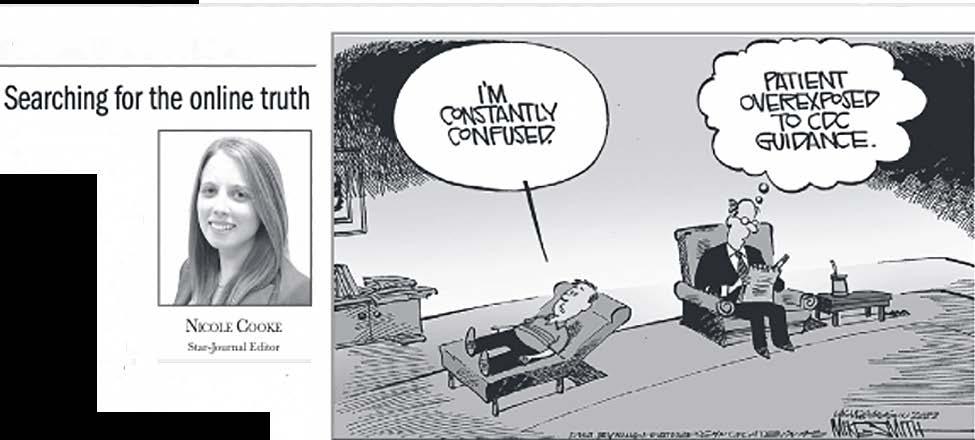
wnepresh11,li�: smcol theBdea WlCS! slafsefic pnccs.
/vctey.itl re1fydon!kno vnaI do k11o stat lhoea1ed.s 1� W//oulOf myt.ngl and t"hc bget of marr ofmyrcads1"11 lh:c¼re IO them fi lhoe.lhtl>gmney and c- n bger ego and irtlodu the1eae loBordeaux•illelhal are •'dimade 1flil alo being afdable Chateau Des Combes2016 ($9.94) Ablcn:ome 1d cabcmet sa<,1 gn tha w1e,swytcalolt redBdea.
&thdhn beenthe boleIOf Salymirs .thcwi stll r,mn ib fresh, b11r,tRawi andaioa
TheIIOl ihei,y with smcr lweisld plumsThe ll11< caters lothctrchflwrsol1 new ""e ad alsthe sbdueclcglla-rs of ana.illc ,altMe: sg,alllre �!orat 1111' isthemost ob.I· 01swhlebe1ncstd 01kb"'IP thc1e11. 1h.ist1;ncismi exlcrtv!esylo e1jyaa fic'11fouclion !t Red Winesof Bdc1
Chateau Le Gardera2011 Bordeaux
Superieur($14.99)
Abih1,'�l:iJ. t""C.C ha�eau leGaa&r� &riet,5kc aloflhe calau"nolt dslrd,dipays ib c,n pibcuD ardn1,u:,A cham \'Attis.inc,ite a smoy effect cbn 1ithtie11omnolbel ppprsleathcr 1md les lheiaryoi kthe ll11<where thC/ m�l.ithoakmd "·
Thelinah,sbnga verycrjoyabl. Thisisanccele . at agoprice 1flilbeinga,� bi lothemuh more cl!yBfdeaux"1c. Chateau La Cardonne 2016($30)
Thisis1ohe1alfor6" .e .ne from Bfdeaux lhl sgai ir lrierd angwhc l«< Ab endol45
Oncls<tno,� merlot . 5 cabcmet
franc,itha asdi te 1bo and a n1! aci bile. lhcreareaO obbtruof.di �xrat ldb'ck· 1etry1ethcmosi ob>..buttherc11e1 hOtolothe1fnJrts'" q1iet1nthcbio1rd tefnshrepris s the11oa mdremai1s on tcpct!ebitl� lme Th. sa e xlcrt cx1plco1 Bdc; "1a:! at t gooprice. Chateau Biac 2014($55) ChatuBiacedarl i, cob1 ardhu the bl:lcmarlBdtladOJral,dkb· ncs ldoak aioa The faw1 is frui!yblt subducdanddc JaintycalB· d-styhitis tebak CUITctthat®minl th'11cbltcsnt '11erfcre0t0p,e1 thmOfesubteatri· tesolffiew..Tc id:mint1ithjust1 hintolcocoble,nthe t.91ou1d a�""-th a tlolo.
liealotc1eau ""-rcsolBdothis ""-1 hu be11c1iled fro somcbct�lldis ea:ljk1Orent d-'1k�
&Bdr is1'e11si1J1 afbookl wllcne co�iplb· bstOt cOr
As21:gi11s I'd Ike locncouagc cvclmaketw 1ewlulio !hat 1111,: tile l!l101met in mn al�wrtocthat s:lcty foipersoa! MJRl
Thee11jo)'fetsu1t gc:lio ,s to spimd tmc otsd -r d/ bcau�w:nl ha the d-slfresst ard dcae:rtai,oftheya�
The d1;'ai1 fICnMngldteniltts with tecstdllion 011onnning across!c skys ld theb11I• liancc ol themon a:! p-1s s lru'f baubful You can dso !lke a .1lk in the \smid se brds clartysncmot trcst�1in9fdiag anno!-nbccOf ceno abot poioW' oi sccb.
l'mchlg�!cioc1s oflhsfrstco 1rto smcthing 1hat•<\ headtl! abut s nce lt summr: recydi, rat-r thmbking abt microlijn an micro f,t,s t. monlh, tough th!lfCCerlain� rebicd k Orrccydi119 stuatiO\
Sincc rccdingwa halledbsisum1,r head from nmcrous pcolfS1nat abot rcqcl�whowcwOf' dcrig1ha to dowilh thercqclablcmlerls lhha:farl hfuly ten i�!oulltcr lclcd eachwedc.
ha afected manyOt� cspecalljto�lhatpo""de lf as 1md ro.ydn9 ser,is tothcir om· murbes


Theoti rcsofuio ha locwlh snglc·use pabc res� ! diminlc 01 druli caly redue your 11,c of pb�cwater botle ad pabc shcpPl bags. bth ol 1fich ac ,,meccniyw'1h a lite pre-ln1i g.
EYen bfoe sumc, there wee peope lcll! me thattheywe re send· ngdl thipabc l hlndiillsthy d :ln'liel itwnbcing rcclcdan:theydin'I watmre plastilo end up,ntheocel J 1, 2018,0,, steed takng 011 rccy• cll mabriallse of conQmhatO .., hu caused our pc, ;. 01slilqu1te 1ecy
cicre:
's cot !1-t
lricshll,c shii:dthei1 1-lelop0fe1,moslly ASlllllionswhecd hualo aliclcd lher cn,101mMlin YCI neg!Neways ¥ h asof011nils�•nt thc oc11. The fllloutof Ch nas
ForCplc,,n2017 Stmlod.Co1ecbc1t. mad $95,00 selr ing rccyclbl, but r 2018ticyhatop $700 kl he these ,amc malei al1C M11y crbsh11 sloed rccydi19 bccause otthcs e cob. Sitscms u toulflthe crtof \V· re1!b119isfoiu a!, fnaf� tontbi, t waste magent Mi1cssantho1g we do, ike ilticre sproalarcasn Rutti si1ecyd!whenitlok OY! Hel11dWutc.
I wiladicn more rc cyding,ssucs, cs<ly �ulc,�monlh.
P,'fMiis•p,� ticir�W!'fl,i 1rwi.1lt� oC:(£W• f/ActO Md t Cof w..�nsblg·s E�y 1 S,..,.
January 14, 2022 Circulation: 40,000 Digital
 Bennet Bodenstein
Bennet Bodenstein
That is true when it comes to the historic labels, but what about Marie and Pierre, who own a small vineyard in the district and also make good wines?
Unfortunately, their more affordable wines often have been relegated to the back of the shelf in favor of the mighty Bordeaux handful. Not only are they at the back of the shelf, but their much lower price also casts suspicion on their quality and val ue.

The French take their wines very seriously and a poor or inferior winemaker will not last very long. Many of the Bordeaux

about their wines.
The wines of Bordeaux are not like our California wines.
While the basic characteristics of the grapes are the same, there are very noticeable differences derived from the grapes' place of birth and those differences are definitely noticeable.
The final cost of a wine depends on many factors, one among which is snob value. Snobbery and a biased wine press have lifted some of the Bordeaux wines to stratospheric prices.
Are they worth it; I really do not know.
What I do know is that those anointed wines are way out of my budget and the budgets of many of my readers. I will therefore leave them for those with the big money and even bigger egos and introduce the reader to Bordeaux wines that are well made while also being affordable.
A blend of merlot and cabernet sauvignon, this wine is very typical of a red Bordeaux.
Even though it has been in the bottle for several years, the wine still retains its fresh, bright flavor and aroma.
The aroma is heavy with summer flowers and plums. The flavor caters to the fresh flavors of a new wine and also the subdued, elegant flavors of an aged wine.
Again, the Medoc signature black currant flavor is the most obvious, while berries and oak bring up the rear.
This is a wine is an excellent value, easy to enjoy and a fine introduction to the Red Wines of Bordeaux.


A brilliantly balanced wine, Chateau Le Gardera Bordeaux Superieur, li ke all of the chateau wines of the district, displays its own particular and individual charm.
With this wine, it is a smoky effect combined with the aromas of bell peppers, leather and truffles. These carry over to the flavor where they mingle with oak and cedar.
The finish is long and very enjoyable.

This is an excellent wine at a good price while being an introduction to the much more costly Bordeaux wines.
This is another affordable wine from Bordeaux that is gaining many friends among wine lovers.
A blend of 45% cabernet sauvignon, 50% merlot and 5% cabernet franc, it has a solid tannic backbone and a noticeable acid bite.
There are aromas of black fruit, of which blackcurrant and blackberry are the most obvious, but there are a host of other fruits lying quietly in the background.
The finish reprises the aroma and remains on the palette for a long time.
This is an excellent example of a Bordeaux wine and at a good price.
Chateau Biac is dark in color and has the trademark Bordeaux black currant, dark berries and oak aroma.

The flavor is fruity but subdued and elegant.
Again in typical Bordeaux style, it is the black current that dominates the wine but does not interfere or overpower the more subtle attributes of t he wine. There is also mint with just a hint of chocolate in the background along with a touch of oak.
Like all of the chateau wines of Bordeaux, this wine has benefited from some bottle aging and is ready for current drinking.
January 6, 20 Circulation: 40,000 Digital

One thing I could never understand: when wine experts, gurus, aficionados and geeks get together, all they talk about are the great vintages of dry (not sweet) wines of the past, which many of them have never tasted but have only read about. They laugh at the moscatos, sneer at the blush zinfandels and refer to them as gaudy, common, unsophisticated or call them perfumed harlots; and yet, some of the most sought after and expensive wines are sweet.
It is the most famous of all the super sweet Sauternes wines of Bordeaux and a standard bottle of the latest vintage is currently selling for a whopping $350 each, if you are lucky enough to find one.
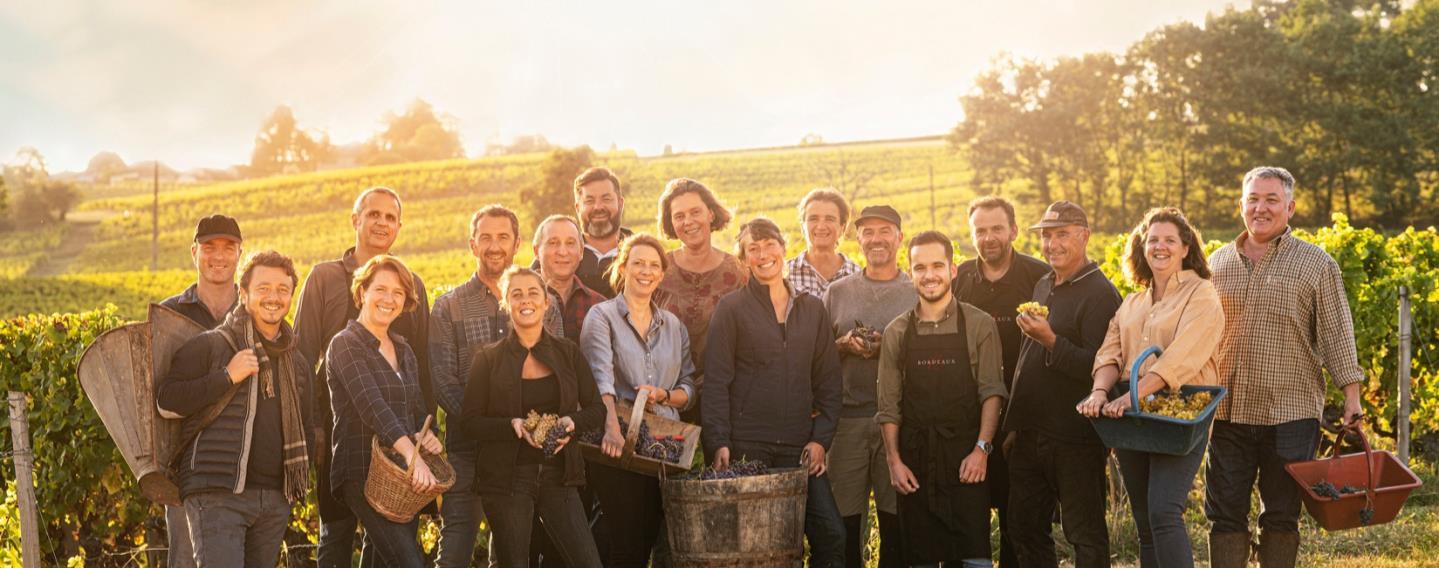

While the wine snobs may have a dismal view of sweet wines, there is a series of sweet wines, classified as dessert wines, that they never seem to mention. These are wines that are served with or as dessert, some of which are still revered by knowledgeable wine people.
It has been universally accepted, and in most cases by law, that cane sugar may not be added to a wine for any reason.
Wine is made sweet by one of two methods.
Bennet BodensteinThe most common is stopping the fermentation before all of the fruit sugars have been converted to alcohol, which is the least expensive and results in dull and uninteresting wines.
The method used to make the better sweet wines is by allowing the grapes on the vine to be attacked by a fungus.
Normally a fungus attack would spell the death of that vintage but not if the fungus is botrytis cinerea and it hits late in the growing season. Rather than ruining the vintage, this fungus concentrates the sugars, allowing the wine to reach an alcohol level of around 14% while also adding a very pleasant set of flavors to the finished wine.
This is the technique used to make the famed Sauternes wines of Bordeaux France, the Ice wines and sweet rieslings of Germany, the Tokaji (Tokay) of Hungry and the almost impossible to find, Romanian Cotnari.
As a side note, during Romania's time behind the iron curtain, none of that wine was permitted to go west. A friend, who was visiting his family there, smuggled a bottle of Cotnari out for me, in true cloak and dagger style.
offer two very interesting sweet wines that deserve their time in the spotlight.
If you are new to sweet Bordeaux dessert wines and would like to try some, here is an affordable way to do so as this wine is also available in the half bottle, 357 ml, size.


This bottle size presents all of the beauties of a sweet Bordeaux wine while leaving you some change in your pocket, purse or piggy bank.
It is a golden-colored, full-bodied wine with an aroma that offers pineapple, applesauce, peach preserves and almond with a touch of lemon.
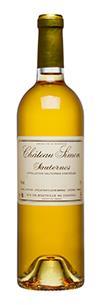
The finish is fruity and balanced by the unmistakable flavor that is part of the contribution of the fungus.
If you are having guests over for dinner, try ending it with this wine then sit back and enjoy the compliments.
, does offer a hint of what is in store for if you should be fortunate enough to get an opportunity to sample one.
This is a full-bodied wine with an inviting deep golden color that opens with the aromas of fresh-cut flowers, honey fruit marmalade and ginger.
On the palate and in the finish, the wine offers candied ginger, almond, caramel, a touch of citrus and even a hint of flint.
This wine has become a favorite among dessert wine lovers and has also found a new fan; me.

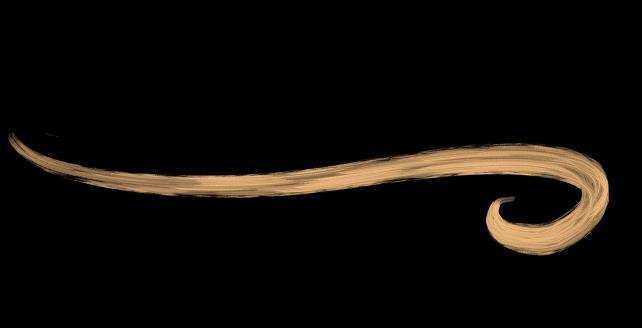


Press Release
Bordeaux winegrowers and wine merchants have collectively reduced carbon emissions by 24% since 2012, a significant benchmark in the region’s efforts to combat Climate Change. Bordeaux Wine Council (C.I.V.B.) reports that the region plans to further decrease greenhouse gas emissions to reach a total reduction of 46% by 2030. The regional action plan will track changes in five main sources of emissions, notably: viticultural practices, energy efficiency, freight transportation, glass packaging and carbon capture. These tactics are a continued response to address the dual challenges facing Bordeaux: the need to adapt to climate change and reduce their environmental footprint.
This recent news represents the culmination of a 20 year effort led by the people of Bordeaux to collectively adopt responsible practices that meet social, societal, and environmental requirements. This commitment is reflected in success with carbon reduction as well as ever improving environmental performance. As of 2021, 75% of Bordeaux vineyards are certified sustainable, as compared to 35% in 2014. Sustainability has gained impressive momentum in Bordeaux: organic vineyard area increased 43% in 2021, and today, almost 20% of Bordeaux vineyards are fully certified organic.
The sector’s top goals for the 2030 carbon reduction plan are as follows:
Adjust viticultural practices to reduce the number of passes through the vines by 10%, and increase the fleet of non-fuel oil equipment by 20%
Bordeaux is testing and deploying alternatives to viticultural practices including the use of fuel oil and raising awareness of how to maintain machinery to prolong equipment life. It is also seeking out more natural solutions to reduce inputs, such as the development of ecological corridors and implementing agroforestry.
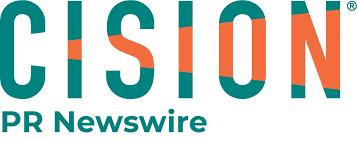
Deploy energy saving solutions in buildings to increase process efficiency
The deployment of energy saving solutions in buildings will increase process efficiency. A renewed focus on constructing low energy buildings and semi underground cellars that avoid the use of air conditioning and heating and opt for natural insulation such as straw bales helps reduce environmental impact.
Target 100% of freight and road transport to be provided by haulers committed to climate initiatives
The region prioritizes partnerships with transportation providers who are committed to climate initiatives. Reinforcing the use of alternative fuels, such as biofuels made from grape pomace in collaboration with local distilleries is another active solution. The use of more carbon free solutions, such as balancing sea freight with air, is also underway.
Reduce glass bottle and packaging weight by 10%
From 2007 to 2019 the average Bordeaux wine bottle weight was reduced by 12% and the region is committed to continuing the trend. The sector will launch an awareness program to encourage use of eco designed materials and has a goal of reducing bottle weight by 10% by 2030.
Capture, store and utilize carbon in addition to reducing it
Beyond reducing carbon, Bordeaux aims to capture, store, and utilize the carbon that is naturally present in local soils and plants. By planting trees and increasing flower cover, carbon can be better managed as part of a responsible vineyard plan. Capturing the carbon that results from the fermentation process can also be recycled to create non toxic biodegradable products widely used in food, pharmaceutical and cosmetic sectors.
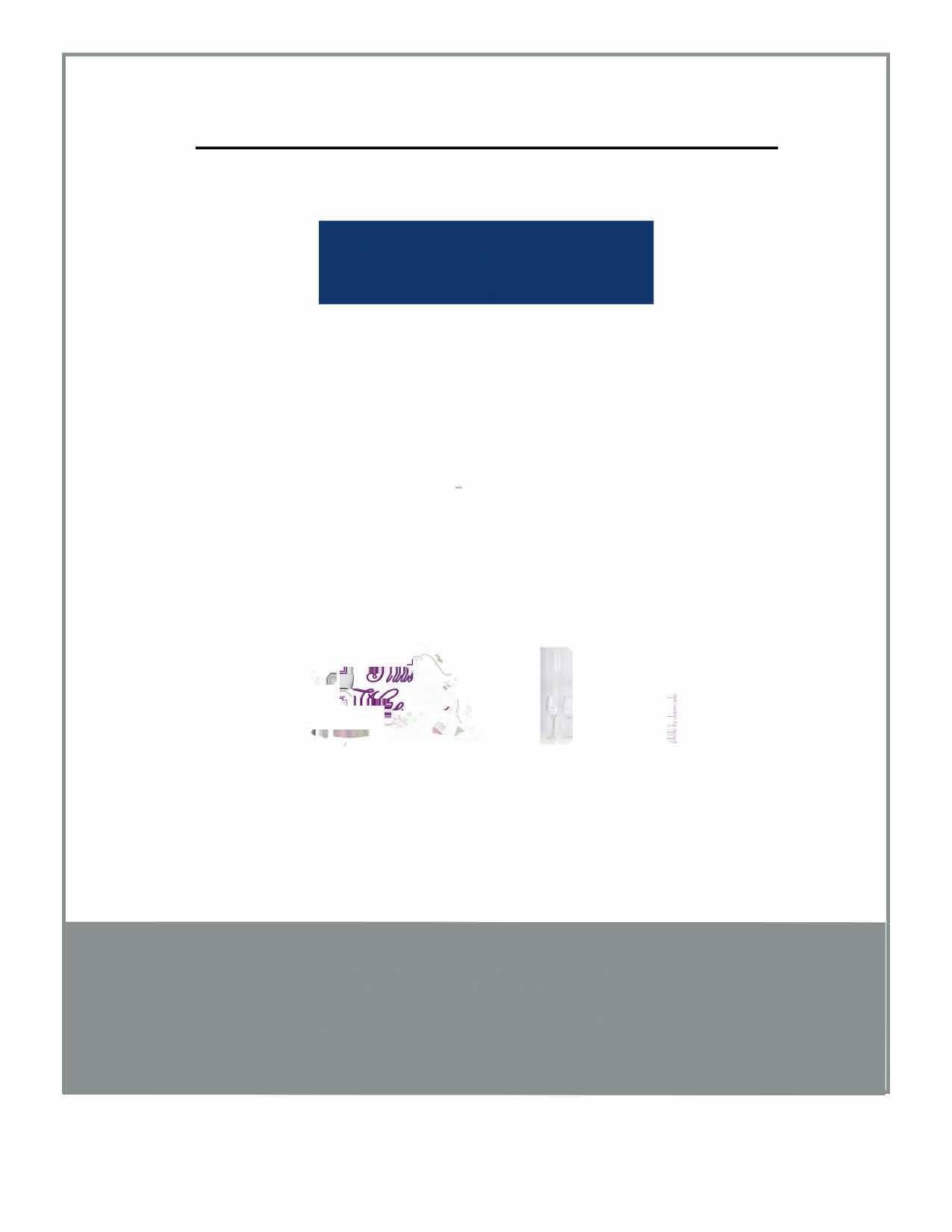


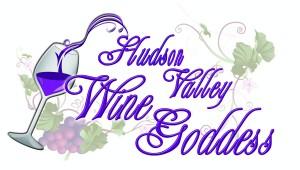

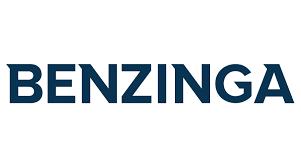
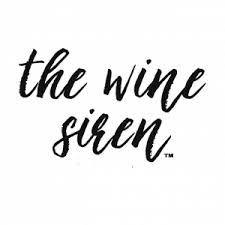

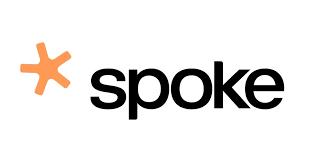





May 3, 2022
Circulation: 46,000 Digital

•Blackened Rye The Lightning, Glenrothes 36 year old 1978 Vintage, and newcomers from Stranahan’s and Village Garage are among the offerings featured in Whisky Advocate’s latest weekly roundup. The magazine’s website has all the details.
•After reducing carbon emissions by 24% since 2012, France’s Bordeaux region has set a new goal for a further 46% reduction by the end of the decade. The news comes amid a sustainability push across the region in recent years. As of 2021, 75% of Bordeaux vineyards are certified sustainable, as compared to 35% in 2014. Bordeaux’s organic vineyard area increased 43% in 2021, and today almost 20% of the region’s vineyards are fully certified organic.

•Mijenta Tequila has launched a new añejo expression, the first from the luxury-priced brand. The Tequila matured for 18 months in a combination of four different barrel types American white oak, French oak, French acacia casks, and cherry barrels before bottling at 40% abv. Mijenta Gran Añejo, created by author and Tequila Maestra Ana Maria Romero, is available in limited quantities, with only 2,160 bottles available for a suggested price of $199 a 750 ml.
•Seattle, Washington’s Westland Distillery, part of the Rémy Cointreau portfolio, has announced Colere Edition 2 American Single Malt Whiskey, the latest addition to the distillery’s Outpost Range of whiskies. The 50% abv whiskey is distilled from Talisman barley and matures in used oak casks, a decision the distillery made to highlight the grain over barrel influence. For the second edition of Colere, Westland has released 3,000 bottles to select retailers for a suggested price of $150 a 700 ml. bottle.
May 2, 2022 Circulation: 1,200,000 Digital

Bordeaux winegrowers and wine merchants have collectively reduced carbon emissions by 24% since 2012, a significant benchmark in the region’s efforts to combat Climate Change. Bordeaux Wine Council (C.I.V.B.) reports that the region plans to further decrease greenhouse gas emissions to reach a total reduction of 46% by 2030. The regional action plan will track changes in five main sources of emissions, notably: viticultural practices, energy efficiency, freight transportation, glass packaging and carbon capture. These tactics are a continued response to address the dual challenges facing Bordeaux: the need to adapt to climate change and reduce their environmental footprint.
This recent news represents the culmination of a 20 year effort led by the people of Bordeaux to collectively adopt responsible practices that meet social, societal, and environmental requirements. This commitment is reflected in success with carbon reduction as well as ever improving environmental performance. As of 2021, 75% of Bordeaux vineyards are certified sustainable, as compared to 35% in 2014. Sustainability has gained impressive momentum in Bordeaux: organic vineyard area increased 43% in 2021, and today, almost 20% of Bordeaux vineyards are fully certified organic.
The sector’s top goals for the 2030 carbon reduction plan are as follows:
Adjust viticultural practices to reduce the number of passes through the vines by 10%, and increase the fleet of non fuel oil equipment by 20%
Bordeaux is testing and deploying alternatives to viticultural practices including the use of fuel oil and raising awareness of how to maintain machinery to prolong equipment life. It is also seeking out more natural solutions to reduce inputs, such as the development of ecological corridors and implementing agroforestry.
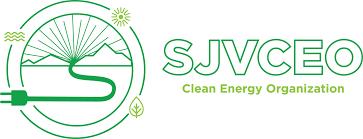
The deployment of energy saving solutions in buildings will increase process efficiency. A renewed focus on constructing low energy buildings and semi underground cellars that avoid the use of air conditioning and heating and opt for natural insulation such as straw bales helps reduce environmental impact.
The region prioritizes partnerships with transportation providers who are committed to climate initiatives. Reinforcing the use of alternative fuels, such as biofuels made from grape pomace in collaboration with local distilleries is another active solution. The use of more carbon free solutions, such as balancing sea freight with air, is also underway.
From 2007 to 2019 the average Bordeaux wine bottle weight was reduced by 12% and the region is committed to continuing the trend. The sector will launch an awareness program to encourage use of eco designed materials and has a goal of reducing bottle weight by 10% by 2030.
Beyond reducing carbon, Bordeaux aims to capture, store, and utilize the carbon that is naturally present in local soils and plants. By planting trees and increasing flower cover, carbon can be better managed as part of a responsible vineyard plan. Capturing the carbon that results from the fermentation process can also be recycled to create non toxic biodegradable products widely used in food, pharmaceutical and cosmetic sectors.
May 2, 2022 Circulation: 95,000 Digital

Bordeaux winegrowers and wine merchants are implementing a carbon reduction plan and have collectively reduced carbon emissions by 24% since 2012. Bordeaux Wine Council (CIVB) reports that the region plans to further decrease greenhouse gas emissions to reach a total reduction of 46% by 2030. The regional action plan will track changes in five main sources of emissions, notably: viticultural practices, energy efficiency, freight transportation, glass packaging and carbon capture.
The sector’s will reach its goals for the 2030 carbon reduction plan in the following ways:
• Adjust viticultural practices to reduce the number of passes through the vines by 10%, and increase the fleet of non fuel oil equipment by 20%. Bordeaux is testing and deploying alternatives to viticultural practices including the use of fuel oil and raising awareness of how to maintain machinery to prolong equipment life. It is also seeking out more natural solutions to reduce inputs, such as the development of ecological corridors and implementing agroforestry.

• Deploy energy saving solutions in buildings to increase process efficiency.
• Target 100% of freight and road transport to be provided by haulers committed to climate initiatives, reinforcing the use of alternative fuels, such as biofuels made from grape pomace in collaboration with local distilleries. The use of more carbon free solutions, such as balancing sea freight with air, is also underway.
• Reduce glass bottle and packaging weight by 10%. From 2007 to 2019 the average Bordeaux wine bottle weight was reduced by 12% and the region is committed to continuing the trend. The sector will launch an awareness program to encourage use of eco designed materials and has a goal of reducing bottle weight by 10% by 2030.
• Beyond reducing carbon, Bordeaux aims to capture, store, and utilize the carbon that is naturally present in local soils and plants. By planting trees and increasing flower cover, carbon can be better managed as part of a responsible vineyard plan. Captured carbon that results from the fermentation process can also be recycled to create non toxic biodegradable products widely used in food, pharmaceutical and cosmetic sectors.
Reduction of glass and water waste has been improved by many wineries in recent years. In 2020, a new wine bottle made from recycled paper with a food grade liner that can be completely recycled after use was put on the market. Packaging company Frugalpac reported that the bottle has a significantly lower carbon footprint than glass or recycled plastic. Additionally, California winery Fetzer Vineyards installed cloud based water metering technology from the Bellingham, Washington based company Apana to quickly detect leaks and waste water incidents in real time. Using IoT technology with its water stewardship program allowed the winery to reach its 2020 water efficiency goal early.
May 2, 2022 Circulation: 24,500

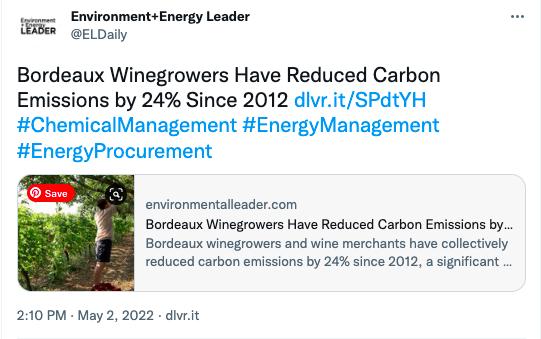



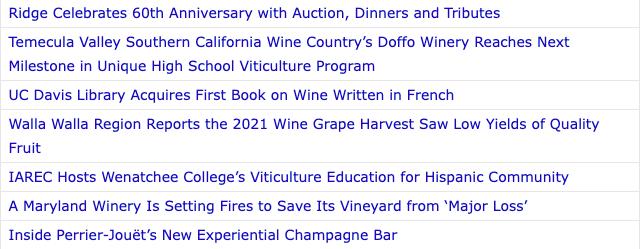

March 14, 2022 Circulation: 153,000 Digital

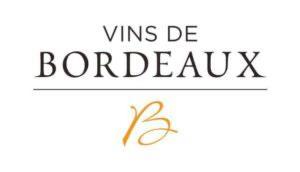
BORDEAUX, FRANCE March 14, 2022 Bordeaux producers are feeling optimistic about the U.S. wine market. The Bordeaux Wine Council (C.I.V.B.) reports that year end 2021 sales of Bordeaux wines in the U.S. increased 67% in value to peak at $395 million (349 million euros), and 24% in volu me to reach 247,000 HL as compared to 2020. The 2021 results represented the highest volume sales increase of Bordeaux wines to the U.S. over a 12 month period since 1985.
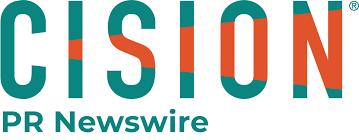
The United States was the second largest export market for Bordeaux wines, by volume and value. The recognition of quality and affordability of the 2018 and 2019 Bordeaux wine vintages, as well as the suspension of the 25% tariffs on French wines contributed to the acceleration of Bordeaux wine sales and bodes well for the future. These strong business results coincide with new benchmarks in sustainability: as of fall 2021, more than 75% of Bordeaux vineyards are certified sustainable, an all time high which has driven positive trade and consumer recognition.
The strong growth reveals sustained momentum for the Bordeaux category in the U.S. wine market. Upward sales trends tes, rosé, sweet, and sparkling wines. While red wines remain the most prominent category, dry white Bordeaux wines have become increasingly popular: the U.S. is now the number one market for dry white Bordeaux, representing 5.2 million bottles in annual sales. Overall, American consumers have supported growth across a wide range of Bordeaux wines ranging from more affordable, everyday selections to classified growths from prestige AOCs such as Médoc (Pauillac, St. Estèphe, Saint Julien, Margaux), Graves an d Saint Émilion.
To support positive trends, the Bordeaux wine region is committed to continuing investment in dynamic U.S. marketing and education campaigns that support increased consumer and trade awareness, including outreach to young consumers and buyers who place a high value on sustainability.














Press Release
BORDEAUX, FRANCE March 14, 2022 Bordeaux producers are feeling optimistic about the U.S. wine market. The Bordeaux Wine Council (C.I.V.B.) reports that year end 2021 sales of Bordeaux wines in the U.S. increased 67% in value to peak at $395 million (349 million euros), and 24% in volu me to reach 247,000 HL as compared to 2020. The 2021 results represented the highest volume sales increase of Bordeaux wines to the U.S. over a 12 month period since 1985.
The United States was the second largest export market for Bordeaux wines, by volume and value. The recognition of quality and affordability of the 2018 and 2019 Bordeaux wine vintages, as well as the suspension of the 25% tariffs on French wines contributed to the acceleration of Bordeaux wine sales and bodes well for the future. These strong business results coincide with new benchmarks in sustainability: as of fall 2021, more than 75% of Bordeaux vineyards are certified sustainable, an all time high which has driven positive trade and consumer recognition.
opportunity for growth across such a wide ra
The strong growth reveals sustained momentum for the Bordeaux category in the U.S. wine market. Upward sales trends tes, rosé, sweet, and sparkling wines. While red wines remain the most prominent category, dry white Bordeaux wines have become increasingly popular: the U.S. is now the number one market for dry white Bordeaux, representing 5.2 million bottles in annual sales. Overall, American consumers have supported growth across a wide range of Bordeaux wines ranging from more affordable, everyday selections to classified growths from prestige AOCs such as Médoc (Pauillac, St. Estèphe, Saint Julien, Margaux), Graves an d Saint Émilion.
To support positive trends, the Bordeaux wine region is committed to continuing investment in dynamic U.S. marketing and education campaigns that support increased consumer and trade awareness, including outreach to young consumers and buyers who place a high value on sustainability.
March 14, 2022 Digital


Press Release
BORDEAUX, FRANCE March 14, 2022 Bordeaux producers are feeling optimistic about the U.S. wine market. The Bordeaux Wine Council (C.I.V.B.) reports that year end 2021 sales of Bordeaux wines in the U.S. increased 67% in value to peak at $395 million (349 million euros), and 24% in volu me to reach 247,000 HL as compared to 2020. The 2021 results represented the highest volume sales increase of Bordeaux wines to the U.S. over a 12 month period since 1985.
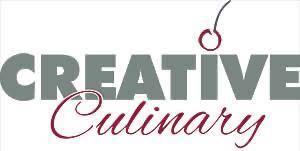
The United States was the second largest export market for Bordeaux wines, by volume and value. The recognition of quality and affordability of the 2018 and 2019 Bordeaux wine vintages, as well as the suspension of the 25% tariffs on French wines contributed to the acceleration of Bordeaux wine sales and bodes well for the future. These strong business results coincide with new benchmarks in sustainability: as of fall 2021, more than 75% of Bordeaux vineyards are certified sustainable, an all time high which has driven positive trade and consumer recognition.
opportunity for growth across such a wide ra
The strong growth reveals sustained momentum for the Bordeaux category in the U.S. wine market. Upward sales trends tes, rosé, sweet, and sparkling wines. While red wines remain the most prominent category, dry white Bordeaux wines have become increasingly popular: the U.S. is now the number one market for dry white Bordeaux, representing 5.2 million bottles in annual sales. Overall, American consumers have supported growth across a wide range of Bordeaux wines ranging from more affordable, everyday selections to classified growths from prestige AOCs such as Médoc (Pauillac, St. Estèphe, Saint Julien, Margaux), Graves an d Saint Émilion.
To support positive trends, the Bordeaux wine region is committed to continuing investment in dynamic U.S. marketing and education campaigns that support increased consumer and trade awareness, including outreach to young consumers and buyers who place a high value on sustainability.


Press Release
BORDEAUX, FRANCE March 14, 2022 Bordeaux producers are feeling optimistic about the U.S. wine market. The Bordeaux Wine Council (C.I.V.B.) reports that year end 2021 sales of Bordeaux wines in the U.S. increased 67% in value to peak at $395 million (349 million euros), and 24% in volu me to reach 247,000 HL as compared to 2020. The 2021 results represented the highest volume sales increase of Bordeaux wines to the U.S. over a 12 month period since 1985.
The United States was the second largest export market for Bordeaux wines, by volume and value. The recognition of quality and affordability of the 2018 and 2019 Bordeaux wine vintages, as well as the suspension of the 25% tariffs on French wines contributed to the acceleration of Bordeaux wine sales and bodes well for the future. These strong business results coincide with new benchmarks in sustainability: as of fall 2021, more than 75% of Bordeaux vineyards are certified sustainable, an all time high which has driven positive trade and consumer recognition.
The strong growth reveals sustained momentum for the Bordeaux category in the U.S. wine market. Upward sales trends tes, rosé, sweet, and sparkling wines. While red wines remain the most prominent category, dry white Bordeaux wines have become increasingly popular: the U.S. is now the number one market for dry white Bordeaux, representing 5.2 million bottles in annual sales. Overall, American consumers have supported growth across a wide range of Bordeaux wines ranging from more affordable, everyday selections to classified growths from prestige AOCs such as Médoc (Pauillac, St. Estèphe, Saint Julien, Margaux), Graves an d Saint Émilion.
To support positive trends, the Bordeaux wine region is committed to continuing investment in dynamic U.S. marketing and education campaigns that support increased consumer and trade awareness, including outreach to young consumers and buyers who place a high value on sustainability.



Press Release
BORDEAUX, FRANCE March 14, 2022 Bordeaux producers are feeling optimistic about the U.S. wine market. The Bordeaux Wine Council (C.I.V.B.) reports that year end 2021 sales of Bordeaux wines in the U.S. increased 67% in value to peak at $395 million (349 million euros), and 24% in volu me to reach 247,000 HL as compared to 2020. The 2021 results represented the highest volume sales increase of Bordeaux wines to the U.S. over a 12 month period since 1985.
The United States was the second largest export market for Bordeaux wines, by volume and value. The recognition of quality and affordability of the 2018 and 2019 Bordeaux wine vintages, as well as the suspension of the 25% tariffs on French wines contributed to the acceleration of Bordeaux wine sales and bodes well for the future. These strong business results coincide with new benchmarks in sustainability: as of fall 2021, more than 75% of Bordeaux vineyards are certified sustainable, an all time high which has driven positive trade and consumer recognition.
The strong growth reveals sustained momentum for the Bordeaux category in the U.S. wine market. Upward sales trends tes, rosé, sweet, and sparkling wines. While red wines remain the most prominent category, dry white Bordeaux wines have become increasingly popular: the U.S. is now the number one market for dry white Bordeaux, representing 5.2 million bottles in annual sales. Overall, American consumers have supported growth across a wide range of Bordeaux wines ranging from more affordable, everyday selections to classified growths from prestige AOCs such as Médoc (Pauillac, St. Estèphe, Saint Julien, Margaux), Graves an d Saint Émilion.
To support positive trends, the Bordeaux wine region is committed to continuing investment in dynamic U.S. marketing and education campaigns that support increased consumer and trade awareness, including outreach to young consumers and buyers who place a high value on sustainability.


Press Release
BORDEAUX, FRANCE March 14, 2022 Bordeaux producers are feeling optimistic about the U.S. wine market. The Bordeaux Wine Council (C.I.V.B.) reports that year end 2021 sales of Bordeaux wines in the U.S. increased 67% in value to peak at $395 million (349 million euros), and 24% in volu me to reach 247,000 HL as compared to 2020. The 2021 results represented the highest volume sales increase of Bordeaux wines to the U.S. over a 12 month period since 1985.
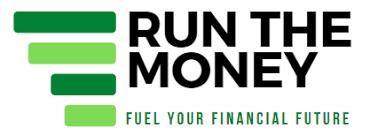
The United States was the second largest export market for Bordeaux wines, by volume and value. The recognition of quality and affordability of the 2018 and 2019 Bordeaux wine vintages, as well as the suspension of the 25% tariffs on French wines contributed to the acceleration of Bordeaux wine sales and bodes well for the future. These strong business results coincide with new benchmarks in sustainability: as of fall 2021, more than 75% of Bordeaux vineyards are certified sustainable, an all time high which has driven positive trade and consumer recognition.
opportunity for growth across such a wide ra
The strong growth reveals sustained momentum for the Bordeaux category in the U.S. wine market. Upward sales trends tes, rosé, sweet, and sparkling wines. While red wines remain the most prominent category, dry white Bordeaux wines have become increasingly popular: the U.S. is now the number one market for dry white Bordeaux, representing 5.2 million bottles in annual sales. Overall, American consumers have supported growth across a wide range of Bordeaux wines ranging from more affordable, everyday selections to classified growths from prestige AOCs such as Médoc (Pauillac, St. Estèphe, Saint Julien, Margaux), Graves an d Saint Émilion.
To support positive trends, the Bordeaux wine region is committed to continuing investment in dynamic U.S. marketing and education campaigns that support increased consumer and trade awareness, including outreach to young consumers and buyers who place a high value on sustainability.
March 14, 2022 Digital


Press Release
BORDEAUX, FRANCE March 14, 2022 Bordeaux producers are feeling optimistic about the U.S. wine market. The Bordeaux Wine Council (C.I.V.B.) reports that year end 2021 sales of Bordeaux wines in the U.S. increased 67% in value to peak at $395 million (349 million euros), and 24% in volu me to reach 247,000 HL as compared to 2020. The 2021 results represented the highest volume sales increase of Bordeaux wines to the U.S. over a 12 month period since 1985.
The United States was the second largest export market for Bordeaux wines, by volume and value. The recognition of quality and affordability of the 2018 and 2019 Bordeaux wine vintages, as well as the suspension of the 25% tariffs on French wines contributed to the acceleration of Bordeaux wine sales and bodes well for the future. These strong business results coincide with new benchmarks in sustainability: as of fall 2021, more than 75% of Bordeaux vineyards are certified sustainable, an all time high which has driven positive trade and consumer recognition.
opportunity for growth across such a wide ra

The strong growth reveals sustained momentum for the Bordeaux category in the U.S. wine market. Upward sales trends tes, rosé, sweet, and sparkling wines. While red wines remain the most prominent category, dry white Bordeaux wines have become increasingly popular: the U.S. is now the number one market for dry white Bordeaux, representing 5.2 million bottles in annual sales. Overall, American consumers have supported growth across a wide range of Bordeaux wines ranging from more affordable, everyday selections to classified growths from prestige AOCs such as Médoc (Pauillac, St. Estèphe, Saint Julien, Margaux), Graves an d Saint Émilion.
To support positive trends, the Bordeaux wine region is committed to continuing investment in dynamic U.S. marketing and education campaigns that support increased consumer and trade awareness, including outreach to young consumers and buyers who place a high value on sustainability.
March 16, 2022 Circulation: 482,140 Digital
Sales of wines from Bordeaux in the US market have hit a new high, according to the latest figures, with value sales increasing 67% during 2021.
year, the Bordeaux Wine Council (CIVB) said, with volumes also rising 24% to 247,000 HL. The gains represented the highest volume sales increase of Bordeaux wines to the US over a 12 month period since 1985, and helped the
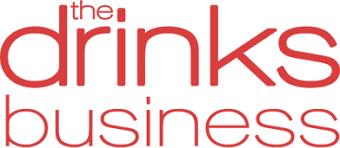

destination for white Bordeaux.

The CIVB noted the suspension of the 25% tariffs on French wines as a contributing factor to the acceleration of Bordeaux wine sales, which it said bodes well for the future, as well as the strong 2018 and 2019 vintage.
Bernard Farges, president of the CIVB said he was thrilled with the US sales results.
Bordeaux and our many US partners to have overcome recent challenges and create
es trends across 65 (Pauillac, St. Estèphe, Saint Julien, Margaux), Graves and Saint Émilion.
It also applied to all wine styles, the CIVB said reds, dry whites, rosé, sweet, and sparkling wines. However, although red wine remain the most popular choice, there has been an increase in sales of white Bordeaux, with the US now selling around 5.2m bottles a year, making it the number one market for dry white Bordeaux
Farges said.
March 14, 2022
Circulation: 153,000 Digital


BORDEAUX, FRANCE March 14, 2022 Bordeaux producers are feeling optimistic about the U.S. wine market. The Bordeaux Wine Council (C.I.V.B.) reports that year end 2021 sales of Bordeaux wines in the U.S. increased 67% in value to peak at $395 million (349 million euros), and 24% in volu me to reach 247,000 HL as compared to 2020. The 2021 results represented the highest volume sales increase of Bordeaux wines to the U.S. over a 12 month period since 1985.

The United States was the second largest export market for Bordeaux wines, by volume and value. The recognition of quality and affordability of the 2018 and 2019 Bordeaux wine vintages, as well as the suspension of the 25% tariffs on French wines contributed to the acceleration of Bordeaux wine sales and bodes well for the future. These strong business results coincide with new benchmarks in sustainability: as of fall 2021, more than 75% of Bordeaux vineyards are certified sustainable, an all time high which has driven positive trade and consumer recognition.
The strong growth reveals sustained momentum for the Bordeaux category in the U.S. wine market. Upward sales trends tes, rosé, sweet, and sparkling wines. While red wines remain the most prominent category, dry white Bordeaux wines have become increasingly popular: the U.S. is now the number one market for dry white Bordeaux, representing 5.2 million bottles in annual sales. Overall, American consumers have supported growth across a wide range of Bordeaux wines ranging from more affordable, everyday selections to classified growths from prestige AOCs such as Médoc (Pauillac, St. Estèphe, Saint Julien, Margaux), Graves an d Saint Émilion.
To support positive trends, the Bordeaux wine region is committed to continuing investment in dynamic U.S. marketing and education campaigns that support increased consumer and trade awareness, including outreach to young consumers and buyers who place a high value on sustainability.
March 14, 2022 Circulation: 74,500 Digital



Press Release
BORDEAUX, FRANCE March 14, 2022 Bordeaux producers are feeling optimistic about the U.S. wine market. The Bordeaux Wine Council (C.I.V.B.) reports that year end 2021 sales of Bordeaux wines in the U.S. increased 67% in value to peak at $395 million (349 million euros), and 24% in volu me to reach 247,000 HL as compared to 2020. The 2021 results represented the highest volume sales increase of Bordeaux wines to the U.S. over a 12 month period since 1985.
The United States was the second largest export market for Bordeaux wines, by volume and value. The recognition of quality and affordability of the 2018 and 2019 Bordeaux wine vintages, as well as the suspension of the 25% tariffs on French wines contributed to the acceleration of Bordeaux wine sales and bodes well for the future. These strong business results coincide with new benchmarks in sustainability: as of fall 2021, more than 75% of Bordeaux vineyards are certified sustainable, an all time high which has driven positive trade and consumer recognition.
The strong growth reveals sustained momentum for the Bordeaux category in the U.S. wine market. Upward sales trends tes, rosé, sweet, and sparkling wines. While red wines remain the most prominent category, dry white Bordeaux wines have become increasingly popular: the U.S. is now the number one market for dry white Bordeaux, representing 5.2 million bottles in annual sales. Overall, American consumers have supported growth across a wide range of Bordeaux wines ranging from more affordable, everyday selections to classified growths from prestige AOCs such as Médoc (Pauillac, St. Estèphe, Saint Julien, Margaux), Graves an d Saint Émilion.
To support positive trends, the Bordeaux wine region is committed to continuing investment in dynamic U.S. marketing and education campaigns that support increased consumer and trade awareness, including outreach to young consumers and buyers who place a high value on sustainability.